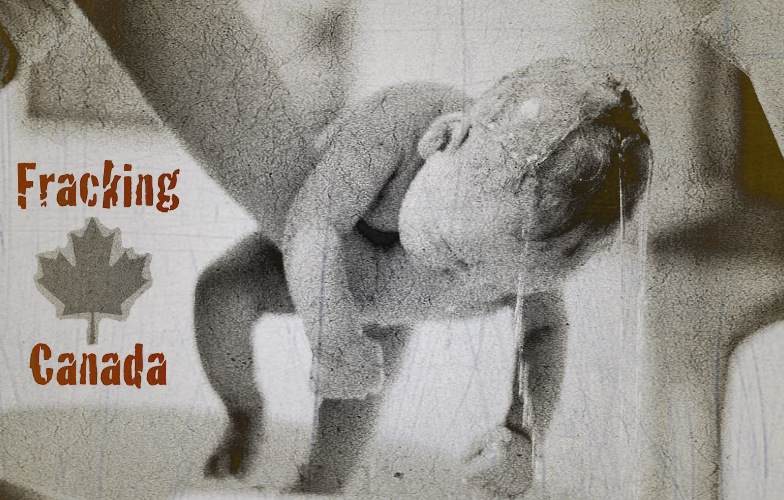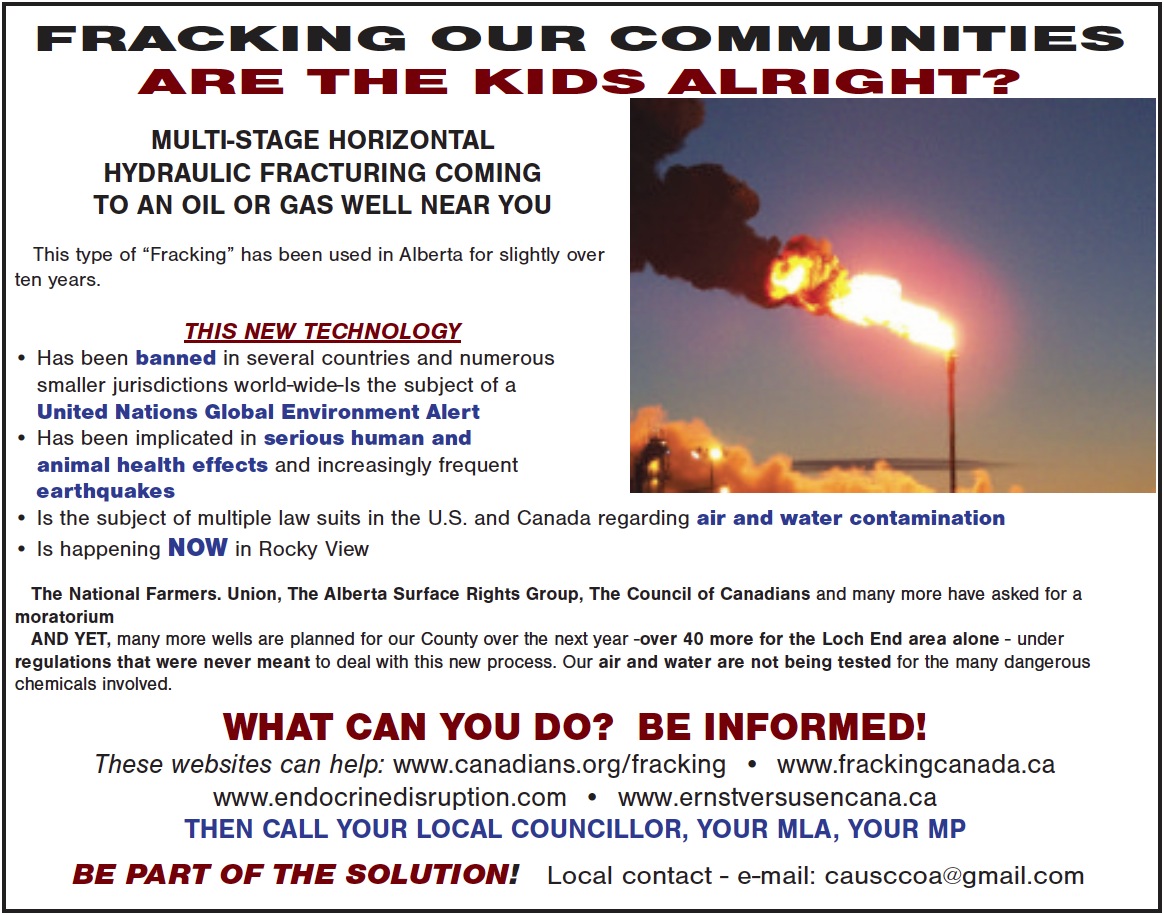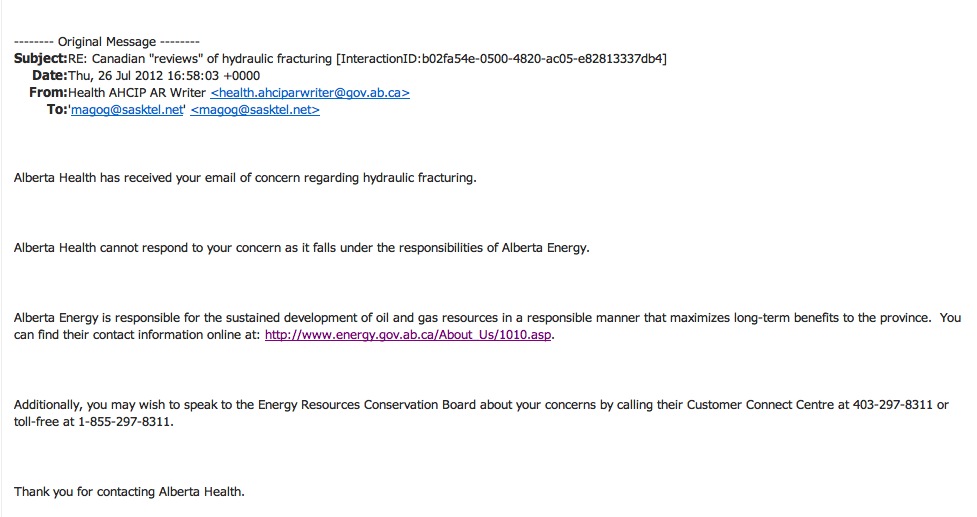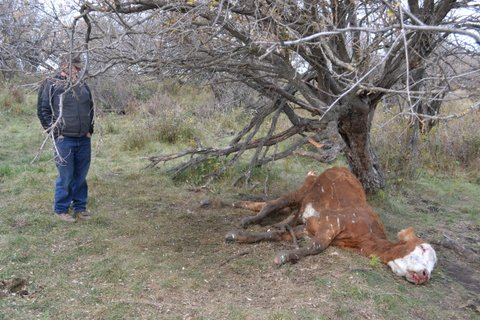Fracking Rocky View County
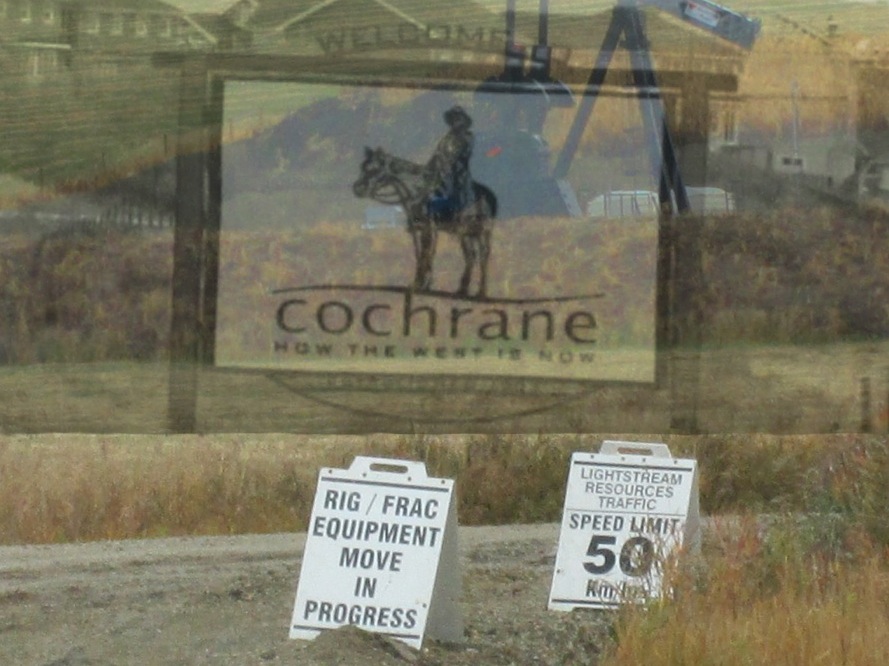
"How The West Is Now." The Cowboy Trail becomes another "Frack Alley" north of Cochrane, Alberta. Companies prepare to frack a well near Cochrane's new residential neighbourhood of Sunset Ridge. October 2013
As countries and other jurisdictions around the world say no to hydraulic fracturing and the toxic industrialization of their communities, Alberta has embraced it.
One such county in Alberta, abutting Calgary, where the unconventional hydraulic fracturing experiment has been underway since 2009, has undergone a massive industrialization transformation and downsizing of public safety services (when homes, schools, businesses or water wells explode and burn – who are you going to call and how does that happen)?
A devastated landscape, reports of sick and dying pets and livestock, earthquakes and structural damage to homes and outbuildings, contaminated water, air and land, road destruction, decimation of property values, livelihoods and residents' enjoyment of their homes and health being severely impacted - continue to increase - with no help or protection, offered or supplied, to those affected.
After drilling and fracking 80+ energy wells in an area of Rocky View County that was once known as "The Jewel of the County," reportedly, the plan is to drill and frack over 3000 more, this of course doesn't include the drilling and fracking of one of "Canada's Richest Postal Codes," or the City of Calgary.
For those countries and jurisdictions who have banned and criminalized the use of hydraulic fracturing or are considering such, we will update this page, and others, as the impacts and devastation continue to increase in these areas of Alberta.
We think it's important (and heartbreaking) to document the impacts and decimation of an area known for its stunning beauty, sprawling ranches, world famous beef and agriculture, cowboy history and down-home hospitality. We hope this glimpse into the beginning stages of an oil and gas industry invasion, will galvanize others to stand and say no, protect their communities, their life-sources, and all they hold dear - before it's too late.
Oil Activity Continues to Grow in Big Hill Springs Area
'It’s an example of how we are trying to minimize the impact.'
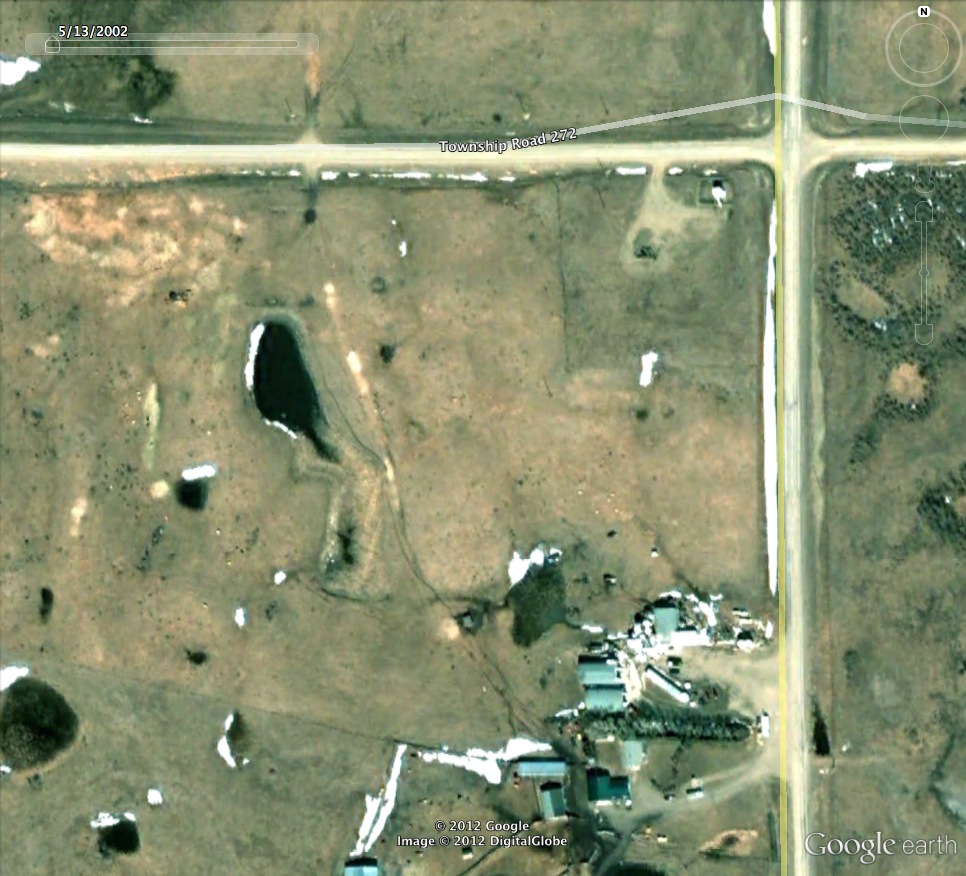 A home and outbuildings on Lochend Road near Calgary, Rocky View County AlbertaBy Rachel Maclean, September 21, 2010, Cochrane Eagle
A home and outbuildings on Lochend Road near Calgary, Rocky View County AlbertaBy Rachel Maclean, September 21, 2010, Cochrane Eagle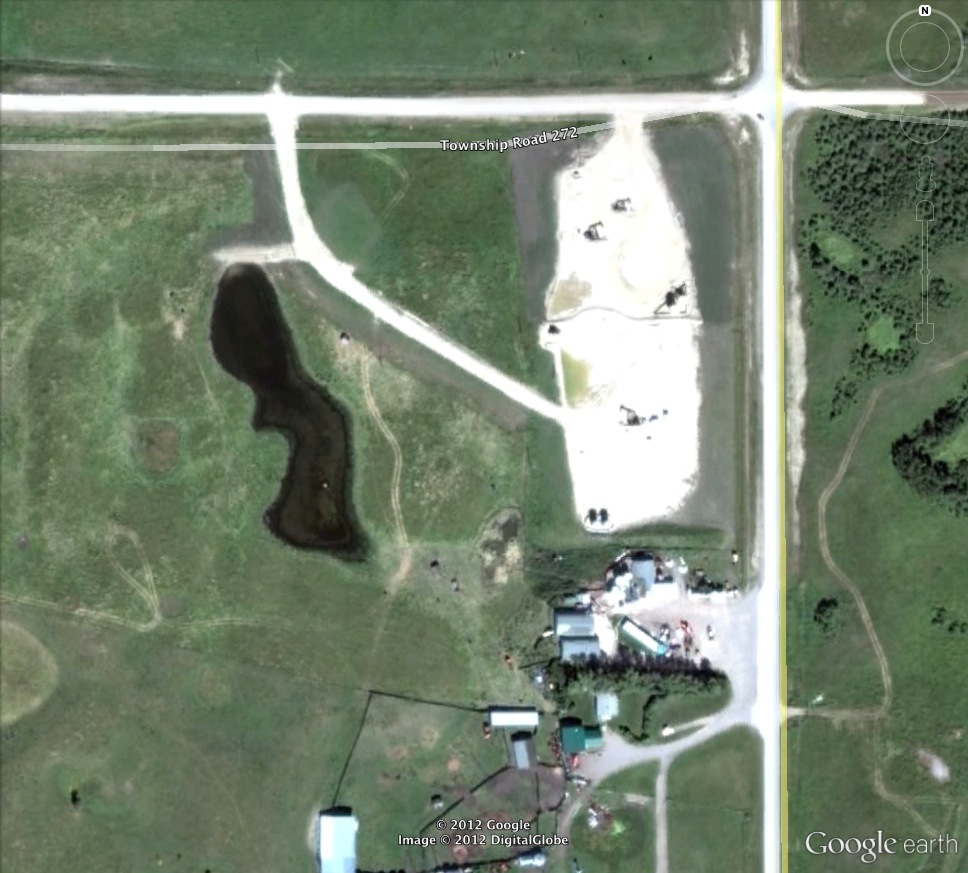 A new 'good neighbor' multi-well pad moves in. Lochend Road, Rocky View County AlbertaIt is considered more efficient than vertical drilling because vertical drills only target a very specific location.
A new 'good neighbor' multi-well pad moves in. Lochend Road, Rocky View County AlbertaIt is considered more efficient than vertical drilling because vertical drills only target a very specific location.Local Group Presents Workshop On The ‘Dangers’ Of Fracking
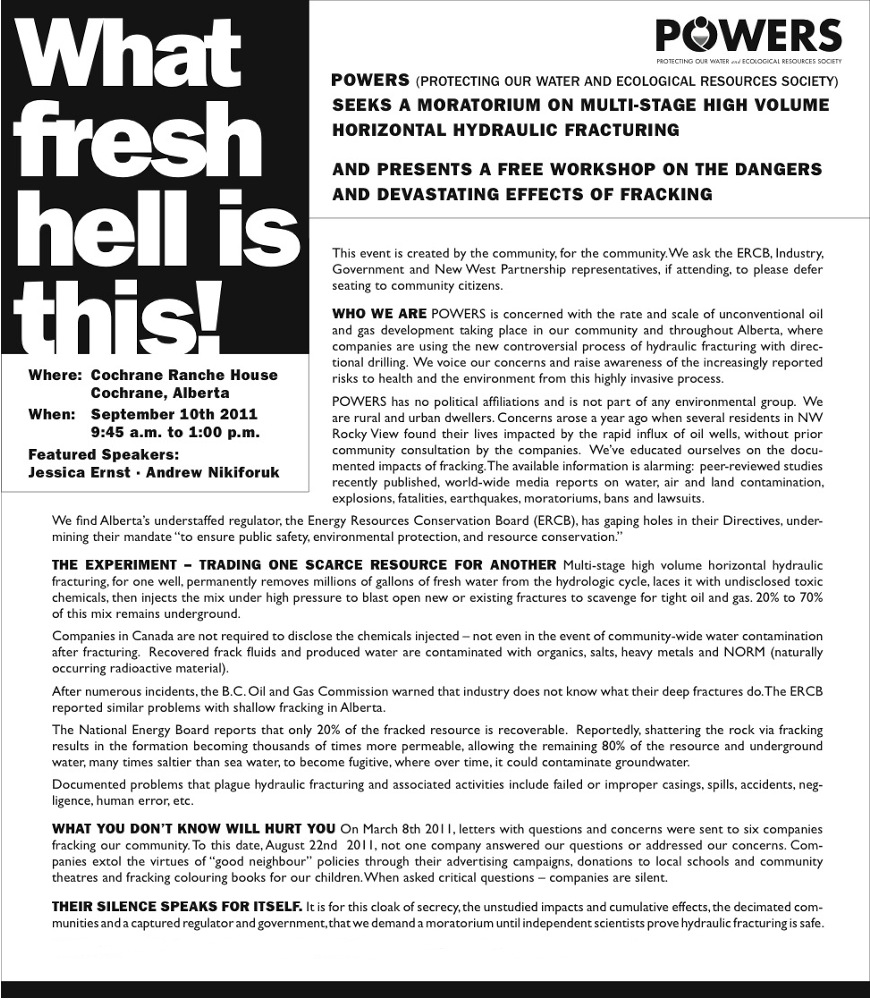 Concerned residents put together a workshop and run an ad in the local papers to inform others.
Concerned residents put together a workshop and run an ad in the local papers to inform others. Local Residents Face Off Against An Oil Company In Bearspaw
The land has been in his family since 1905, and Bancroft would like to keep it pristine.
“Who would buy a house, be it on four acres, if it has . . . pumpjacks behind it,” said Motoc. ... more.
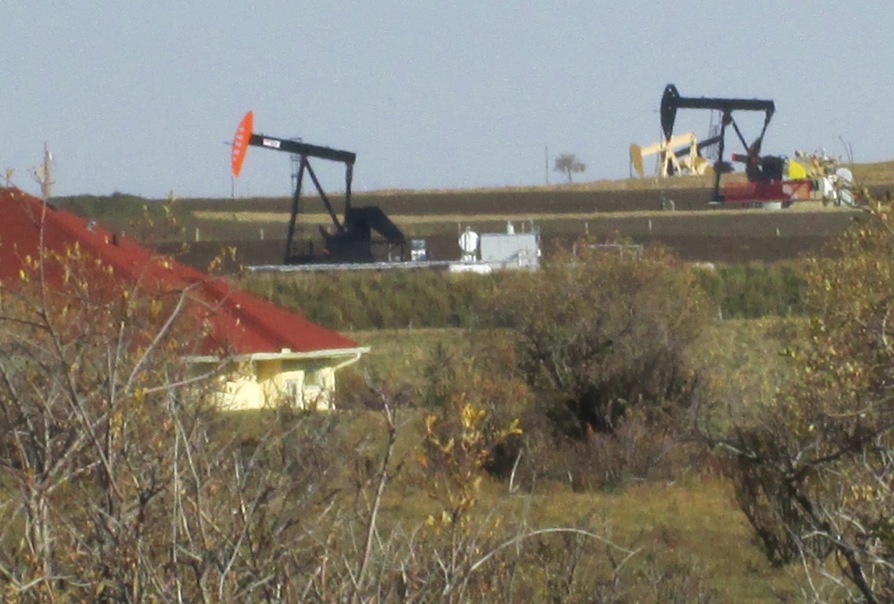
Oil Company Holds Local Open House
McDougall said NAL takes about 15 days to drill and another 15 days to complete a well, leaving behind an electrically-operated pump jack that has a small footprint.
... “There is nothing toxic or something people should be worried about.”
Jessica Brennan of NAL Resources said Westbrook School was designated the beneficiary of the donation. ... more.
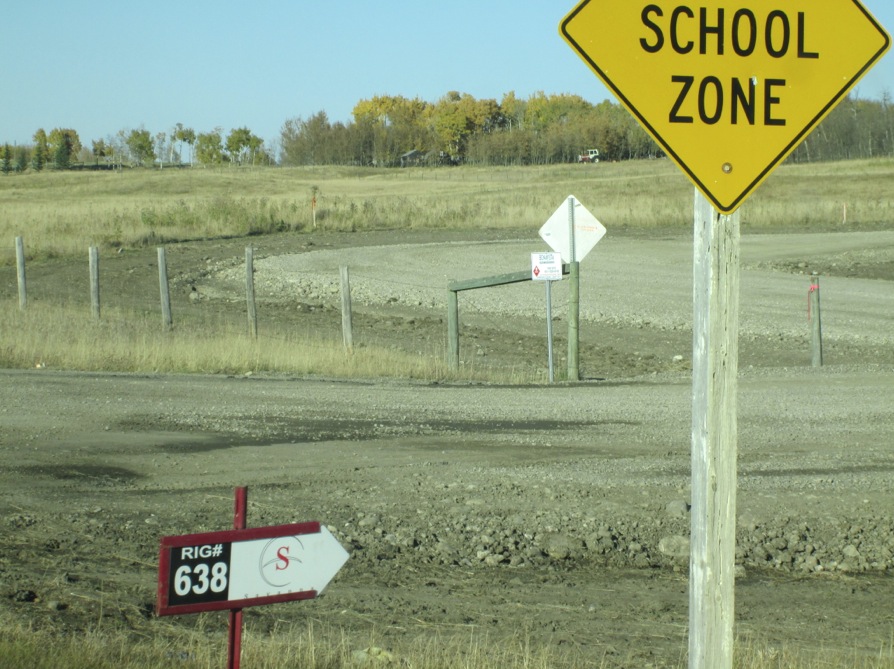
“…As pediatricians specializing in environmental medicine, we at The Center for Children’s Environmental Health are opposed to the current use of hydraulic fracturing not only due to the multiple known risks to children’s health, but also due to the substantial lack of research into the health effects of this practice. While this particular void in research is prominent and must be addressed, multiple health concerns have already been brought up by a wide range of individuals and groups, from rural communities to political bodies and environmental organizations to public health experts." ... more.
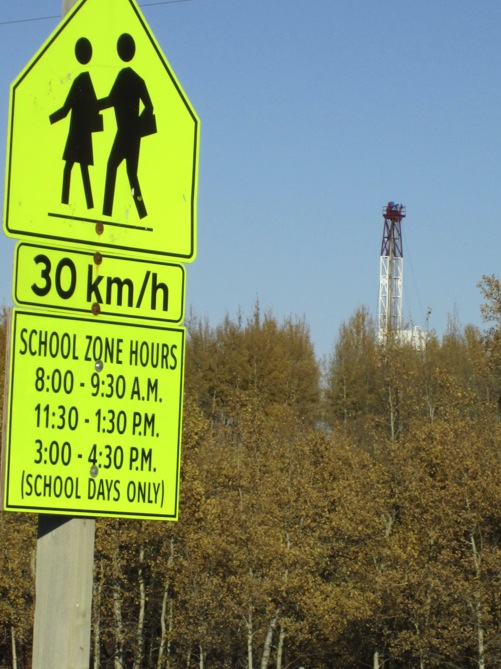
Reportedly, without consulting the community, Bonavista Energy drills near the community cornerstone of Westbrook School K-8 - Rocky View County, Alberta - October 2013
The LIPG donated $20 to one of four organizations for each survey completed. Cochrane SPCA received $360, Westbrook School, $540, 4-H, $420 and Cochrane High School, $140.
By Derek Clouthier, Aug 01, 2013, Cochrane Eagle
The Lochend Industry Producers Group (LIPG) is confident the majority of residents who reside in the Lochend area support oil and gas development in their backyard following a survey conducted by the group in May.
... The LIPG – consisting of Pengrowth Energy, Lightstream Resources, Tamarack Valley Energy and TriOil Resources – is a collection of four energy companies that operate in the Lochend area, located just northeast of Cochrane.
... “It gives us confidence that our neighbours agree that responsible development can take place without putting at risk the rural lifestyle they enjoy,” said Stewart.
One Lochend-area resident, however, is not so sure the LIPG tried as hard as it claimed to reach out to households.
“We did not receive a survey and question the effort made to deliver a survey to us,” said Neille Hawkwood. “An informal survey of our neighbours revealed that none of our acquaintances in the area received the survey. The suggestion that there were only 16 households which did not receive the survey appears to be an understatement.”
Hawkwood believes the LIPG should not have had any issues contacting her family, as they have had frequent visits from industry representatives and said they are very familiar with her land location and contact information.
Hawkwood also questions the size of the pool who responded to the survey.
“Results of any survey with a 23 per cent return rate does not represent a valid indication of overall opinion,” said Hawkwood. “The suggestion that results of this survey indicate Lochend area residents being ‘on board’ with the oil and gas companies working in the area seems to be a very far stretch of the imagination.” ... more.
A night frack in Rocky View County, Alberta, where companies are fracking for oil - 2011
Cochrane Residents Meet to Discuss Fracking Concerns
'We felt that we were living in a nice healthy area. We raised our children here. I'm glad my sons no longer live at home.'
NAL Resources Holds Open House
NAL Energy Corporation Announces Resignation
LIPG Toxic Waste Dumped in Rocky View County
... a charge the LIPG do not deny, but say it was an ‘isolated incident.’
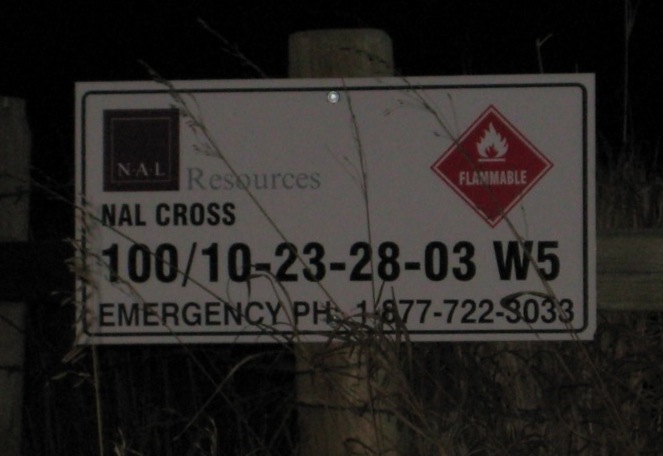 NAL well near toxic dumping site - Rocky View County, AlbertaCAUS Holds Second Meeting To Address Fracking
NAL well near toxic dumping site - Rocky View County, AlbertaCAUS Holds Second Meeting To Address Fracking
By Derek Clouthier, Oct 03, 2012, Cochrane Eagle
... Another claim brought to the attention of attendees during the CAUS meeting was the allegation that the group had caught an LIPG member company dumping frack fluid – water treated with a series of chemicals and pumped into the ground to fracture underlying rock to release oil and/or gas – onto the road and into a ditch…a charge the LIPG do not deny, but say it was an ‘isolated incident.’
“A trucking company driver, contracted by one of the member companies, did not follow proper company policy and government regulation,” said the LIPG. “The incident involved a truck driver stopping and draining what he thought was excess fresh water on the county road. Unfortunately, the driver was not aware that the tank had been used to transfer oil within the trucking company’s yard prior to being loaded with fresh water, and as a result, a trace of oil remained in the tank.”
... more.
Comment from resident who provided pictures of the dumping:
I realize, "we've been fracking for 60 years," so where has the dumper been working that he would think this was "fresh water?" After attending this site, it's hard to believe "the driver was not aware" of the black and foul smelling goop he laid out all the way to the intersection.
If this is how the LIPG defines "stopping and draining" and "trace," then to prevent any further surprises, perhaps they could provide more of their definitions, with pictures, and post them to their websites.
This was nasty, with a diesel-like stench permeating the air and it was rather challenging taking these photos with the regulator and company "emergency response plan" responders swarming the site. If you look really closely, you won't see them - perhaps due to their transparency.
These photos were taken almost two days after the dump, and with no responders or regulator present, no warning signs posted, nothing stopping people from driving or walking through it, thank goodness the dumper, or anyone else, didn't toss a cigarette or cause a spark. So why didn't our "world-class" regulations prevent this? And will we ever know what was actually dumped here? Pathetic.
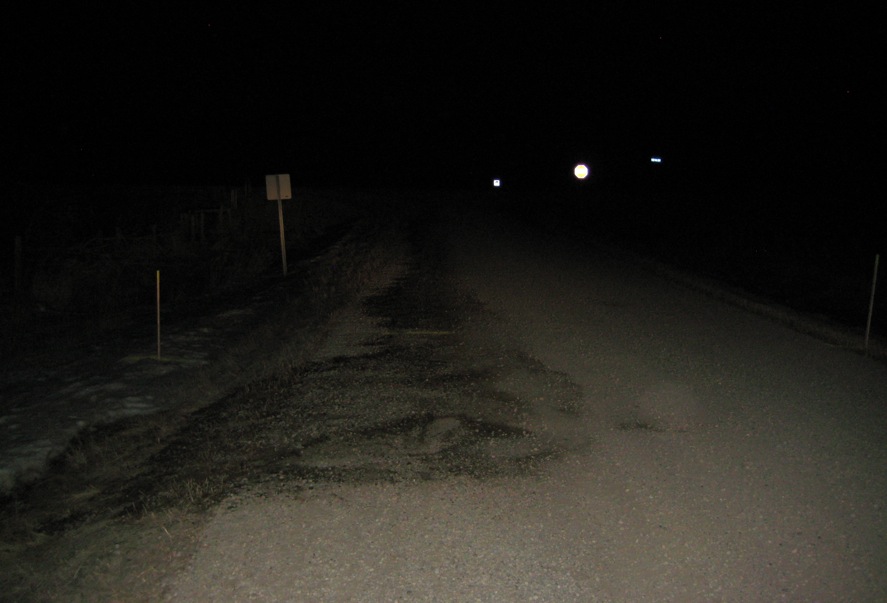
Oilfield Waste Dumping - Rocky View County, Alberta Canada - LIPG member company, NAL, attempted to clean it up as a 'good neighbor' gesture. - Feb. 2012
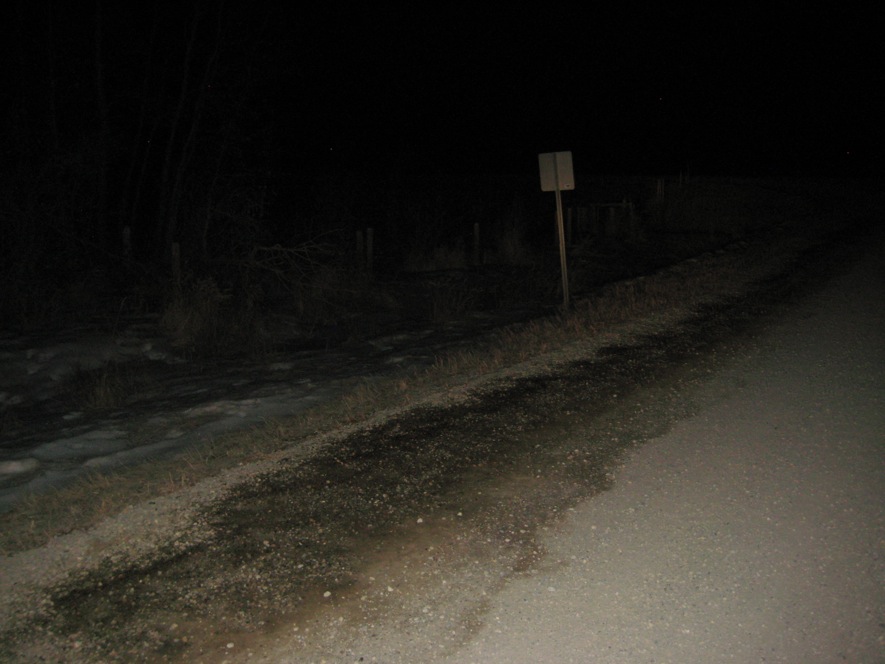
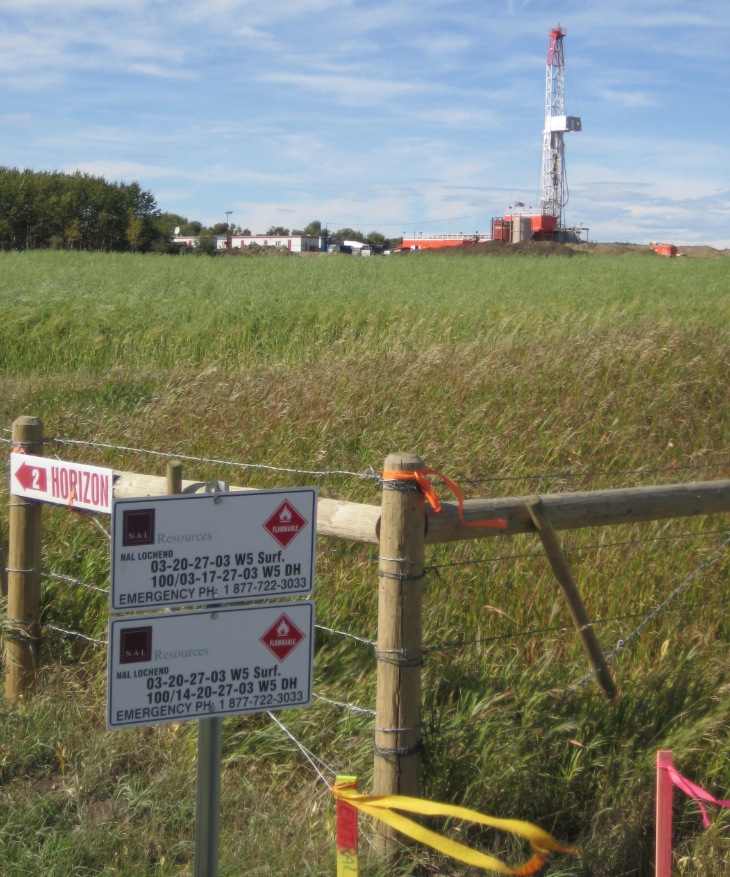 NAL Resources drilling up Rocky View County, Alberta
NAL Resources drilling up Rocky View County, Alberta
Pengrowth to Buy NAL Energy in Friendly Stock Deal
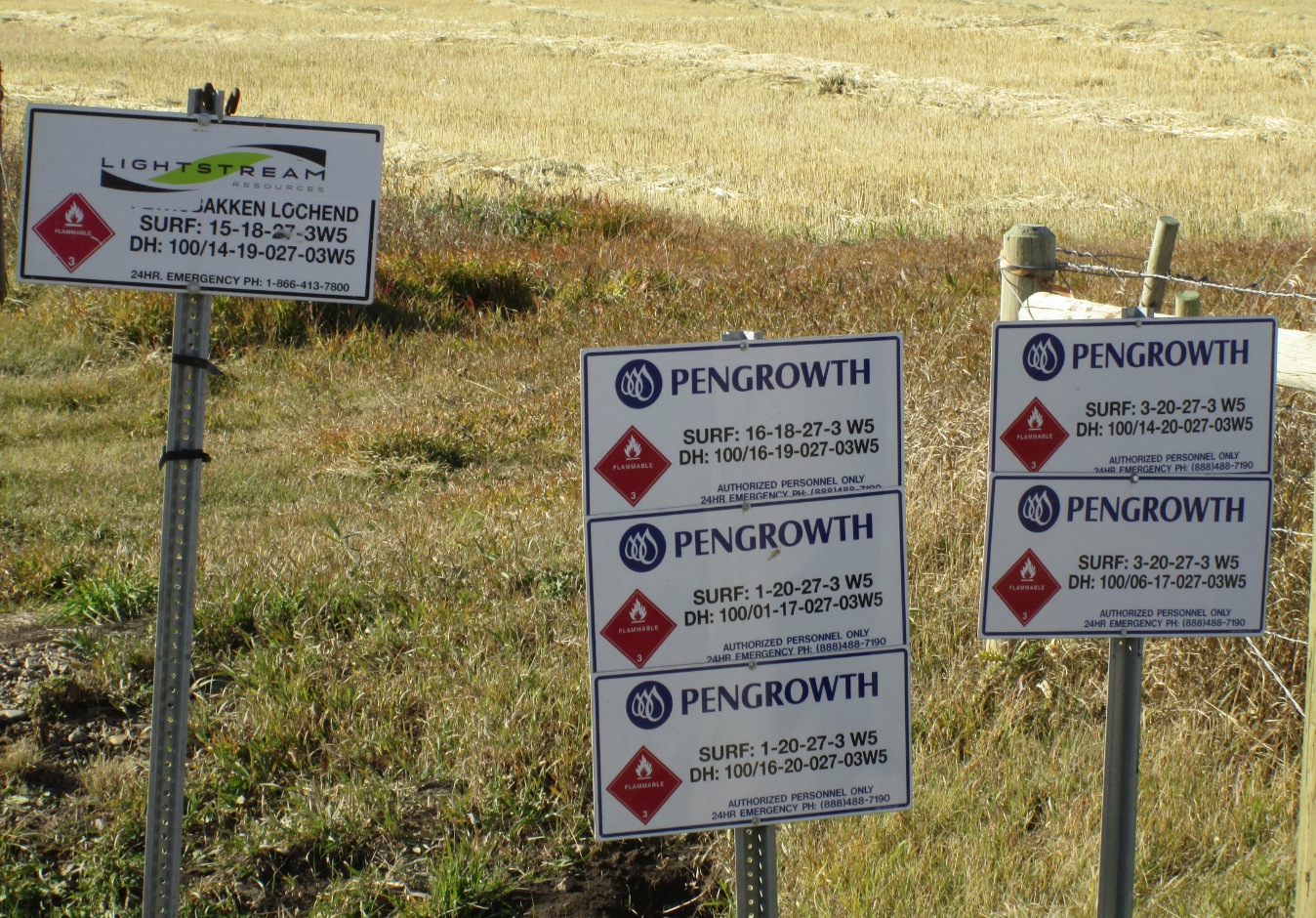
Clash Over Local Drilling
'We found it patronising and insulting to sit there listening to a lecture on how to maintain our water wells when they're actually making toxic soup in our communities'
By Sarah Junkin, November 30, 2011, p. 6, Cochrane Times
Tempers flared at an open house held Nov.23 after local residents concerned about the intensity of drilling in the area, felt they weren't being listened to by some oil and gas producers.
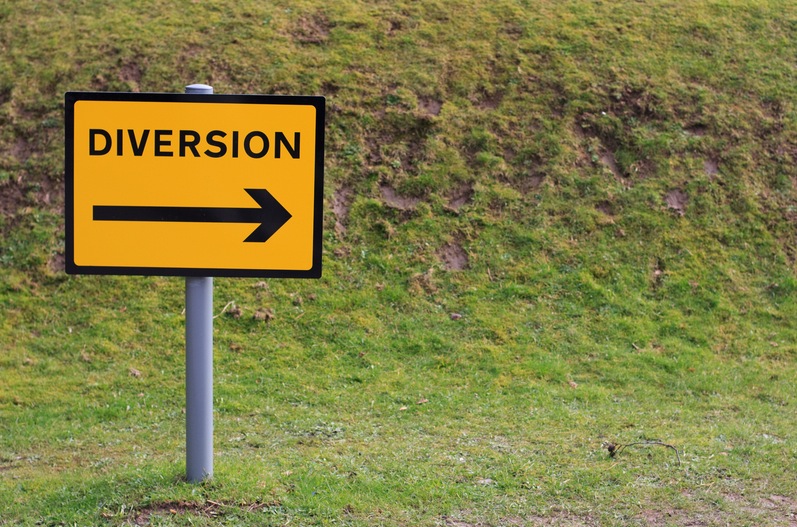 ... after keynote speaker, Grant Nielsen from Stantec Consulting made a presentation on the importance of maintaining water wells, a group known as POWERS Alberta took exception to the fact there was to be no public question and answer session.
... after keynote speaker, Grant Nielsen from Stantec Consulting made a presentation on the importance of maintaining water wells, a group known as POWERS Alberta took exception to the fact there was to be no public question and answer session.
'We found it patronising and insulting to sit there listening to a lecture on how to maintain our water wells when they're actually making toxic soup in our communities,' Pearsall-Pickup said, adding she didn't understand why there wasn't a question and answer session afterwards. 'Why did we have to go in secret to each of these booths?'
... she believes local residents should be wary of the fact that the oil company representatives wouldn't allow questions from the floor.
'This is our home, this is our land ... what do they have to hide? It's a typical manoeuvre by oil and gas to get us to shut up.' ... more.
Fracking Issue In Spotlight Once Again
“It’s all about those 40 questions. We did (it) to better understand (if) we were in a clear and present danger…and yes we were. These 40 questions were sent, not to the LIPG, (but) to individual oil companies, which have now formed as the LIPG. Until hours before the open house, we had received not one answer. We were completely ignored.”
“There was an empty chair in front of me, she came up,” explained Pickup, referring to a consultant representing LIPG, “in public, in front of everybody and slammed down a brown envelope and said, ‘now you have them.’ I was shocked.” ... more.
Task Force Urged To Repeal Four Land Bills
When he asked oil company reps whether they would supply him with water if his aquifer became contaminated, they dismissed his concerns
“Nobody’s looking at the impact and no one’s taking responsibility if I lose water from my place, or my so-called place. Oil companies are simply telling me not to worry and from what I’ve read, I’m worried, I really am worried, and that’s the only reason I’ll speak at an open session such as this.” ... more.
Alberta Energy Regulator Given Immunity In Landmark Fracking Suit
'I have no choice but to appeal', says plaintiff Jessica Ernst, who alleges industry polluted her water.
... 'If I let these rulings stand, companies and the Canadian Association of Petroleum Producers will push regulators across Canada to do unto others as the ERCB did unto me, when they breached my Charter rights and tried to intimidate me into silence by judging me a criminal without any evidence or trial.'
Oil Exploration Increasing in Springbank, Bernum Petroleum Holds Open House
... no blowouts have ever occurred in the province’s Cardium Zone
Oil Exploration Increasing In Springbank
By Derek Clouthier, October 19, 2011, Cochrane Eagle
Calgary oil and gas company, Bernum Petroleum Ltd., held an open house Oct. 11 in an effort to introduce itself to the community of Springbank and field any questions or concerns residents may have regarding the business’s proposal to launch a drilling initiative for sweet oil in the region.
In the days following the open house, Bernum chairman and chief executive officer (CEO) Marshall Abbott highlighted what his company is planning for the area, emphasizing several vital aspects of the fracking operation.
“Our initial activity would include drilling two wells,” he explained. “One is north of the river, just north of the highway (Highway 1). That well is planned to be a horizontal well drilled down to about 8,000 feet into a reservoir that is known. The second well would be just east of the airport . . . considerable distance away from any nearby residence. Those two wells are going to test the concept that we believe there’s a significant amount of oil in the reservoir.”
The two wells Bernum are proposing to drill will be in close proximity to existing wells that were drilled in the ’60s, ’70s and ’80s but were not as productive in past decades.
... The area Bernum is tapping into is known as the Cardium Formation and has been a major source for oil and gas production.
“This whole Cardium Play has been one of the marquee plays in Alberta for about the last 18 months. The Cardium Zone has been a prolific oil producer for over 50 years.”
When it came to safety concerns for both the Springbank region and environment, Abbott pointed to the fact that no blowouts have ever occurred in the province’s Cardium Zone and that the type of oil being extracted poses little to no danger. ... more.
Frack Communication Blowout Occurs in Province's Cardium Zone
'... something allowed the frack to carry into the same zone, 130 to 140 metres away (underground).'
Alberta Fracking May Have Led To Innisfail Oil Spill
By Lynn Herrmann, January 18, 2012, Digital Journal
Hydraulic fracturing’s impact on the environment received another mark this week when an oil well blowout occurred on a farm located about a kilometer away from a fracking well in Alberta, Canada.
Canada’s Energy Resource Conservation Board was alerted late last Friday about an oil spill in a field, about 25 kilometers west of Innisfail, after a neighboring landowner spotted a pumpjack gushing oil and chemicals onto the ground.
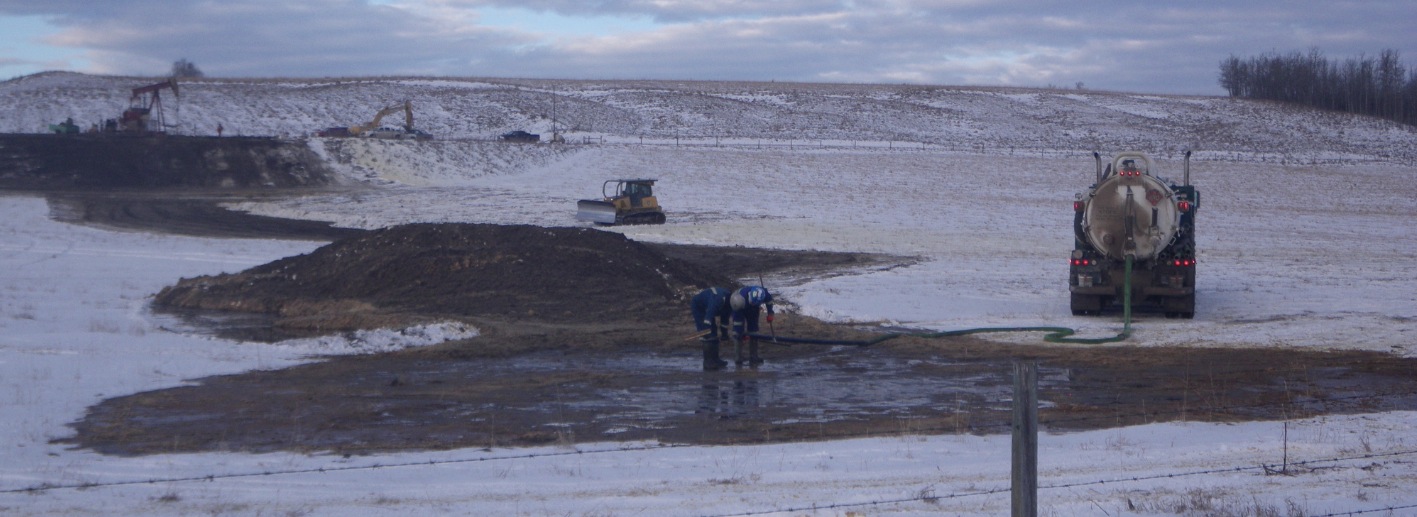
Workers stand in secret frack fluids after a frack communication blowout, Innisfail, Alberta. Photo - Alberta Surface Rights Group
Regulators believe a fracking well located about a kilometer away caused the pumpjack to rupture.
... “We're still not quite sure what happened,” said Scott Ratushny, chief executive for Midway Energy, according to the Herald. “We're still investigating it, but something allowed the frack to carry into the same zone, 130 to 140 metres away (underground).”
Calgary-based Midway Energy, working through Canyon Technical Services, had been finishing a 16-stage frack job at a depth of 1,400 meters when the blowout occurred. Oil, fracking fluid, nitrogen and sand were reportedly involved in the spill.
The spill took place as a result of oil producers working the Cardium oil formation ...
... The accelerated pace of multi-stage fracking in the Alberta area is beginning to draw attention to itself and may impact underground water resources. “We're concerned that these things are going to start damaging aquifers,” said Don Bester, president of the Alberta Surface Rights Group, the Herald notes.
“If they can hit another well, like this one here, what if they communicate and put all that frac fluid into an aquifer and destroy it.” ... more.
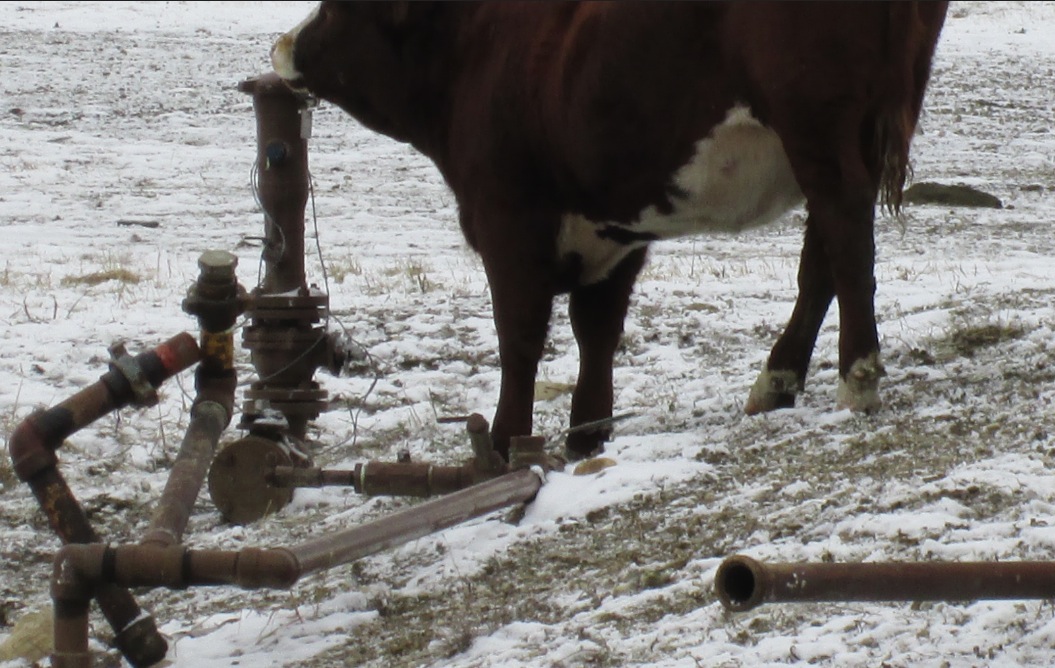
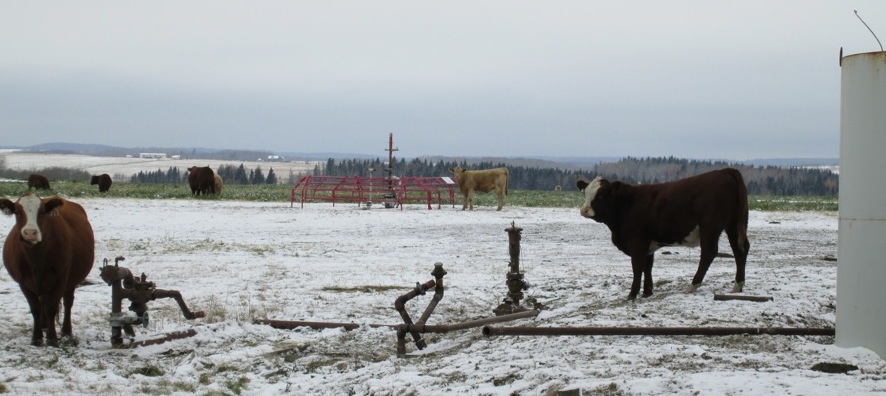
October 19, 2011 The Cochrane Eagle
'We understand the residents' concerns ... about the unsightliness of a pump jack and the possible precedent it sets for an industrial pathway. The last thing we want to do is litter the landscape with oil and gas activity ... that's not our intent.'
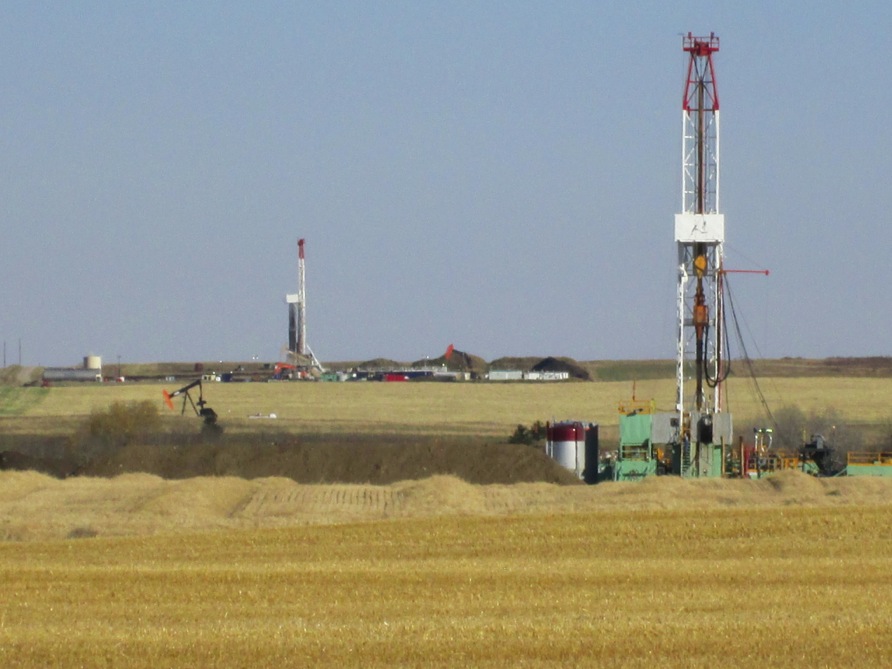
Transforming the countryside. Carpet bombing the Lochend, north of Big Hill Springs Provincial Park - Rocky View County Alberta, Oct. 2013

All that drilling waste has to go somewhere. Drilling waste spread on a food field in the Lochend - Rocky View County, Alberta, Oct. 2013
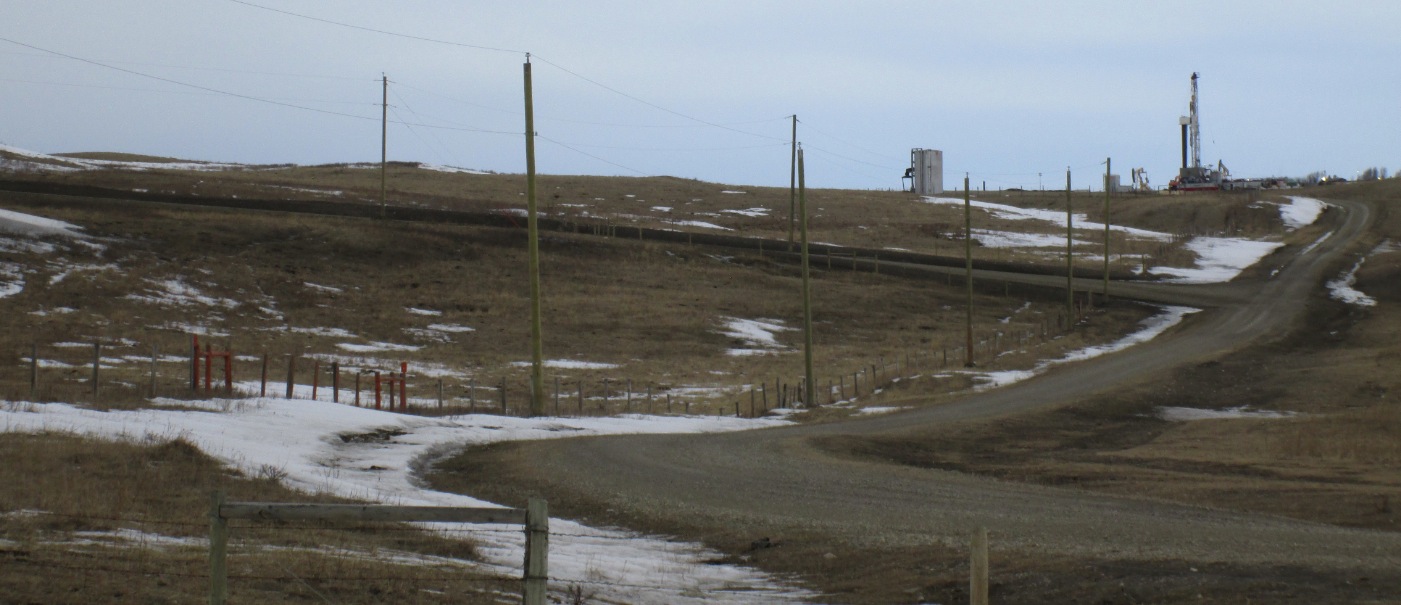
"An industrial pathway." Littering the Lochend with wells, roads and power lines. Rocky View County, Alberta
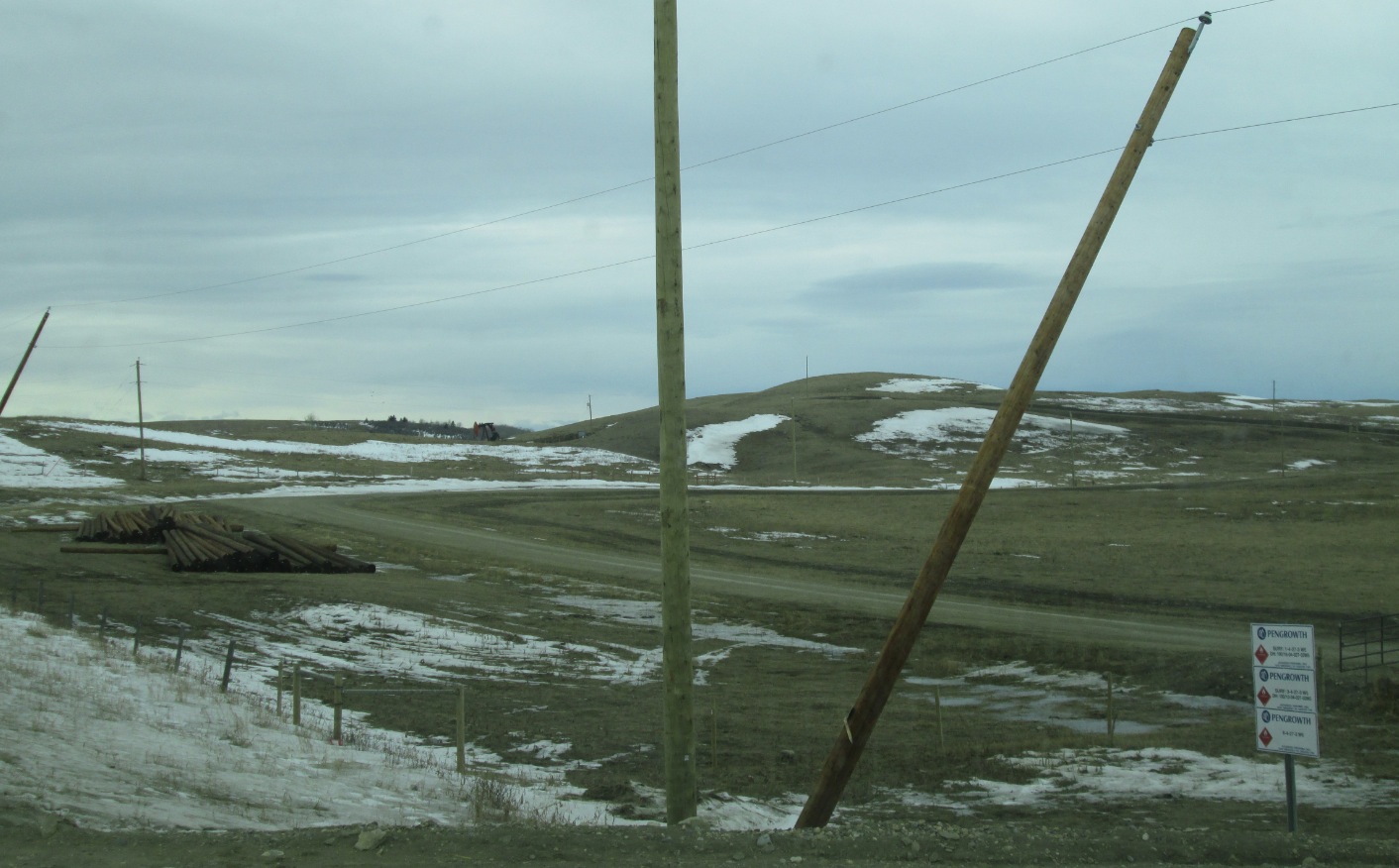
Upgrading the power lines and more power poles and lines to accommodate pumpjacks in the Lochend. Rocky View County, Alberta

Another "industrial pathway" in the Lochend. Rocky View County, Alberta
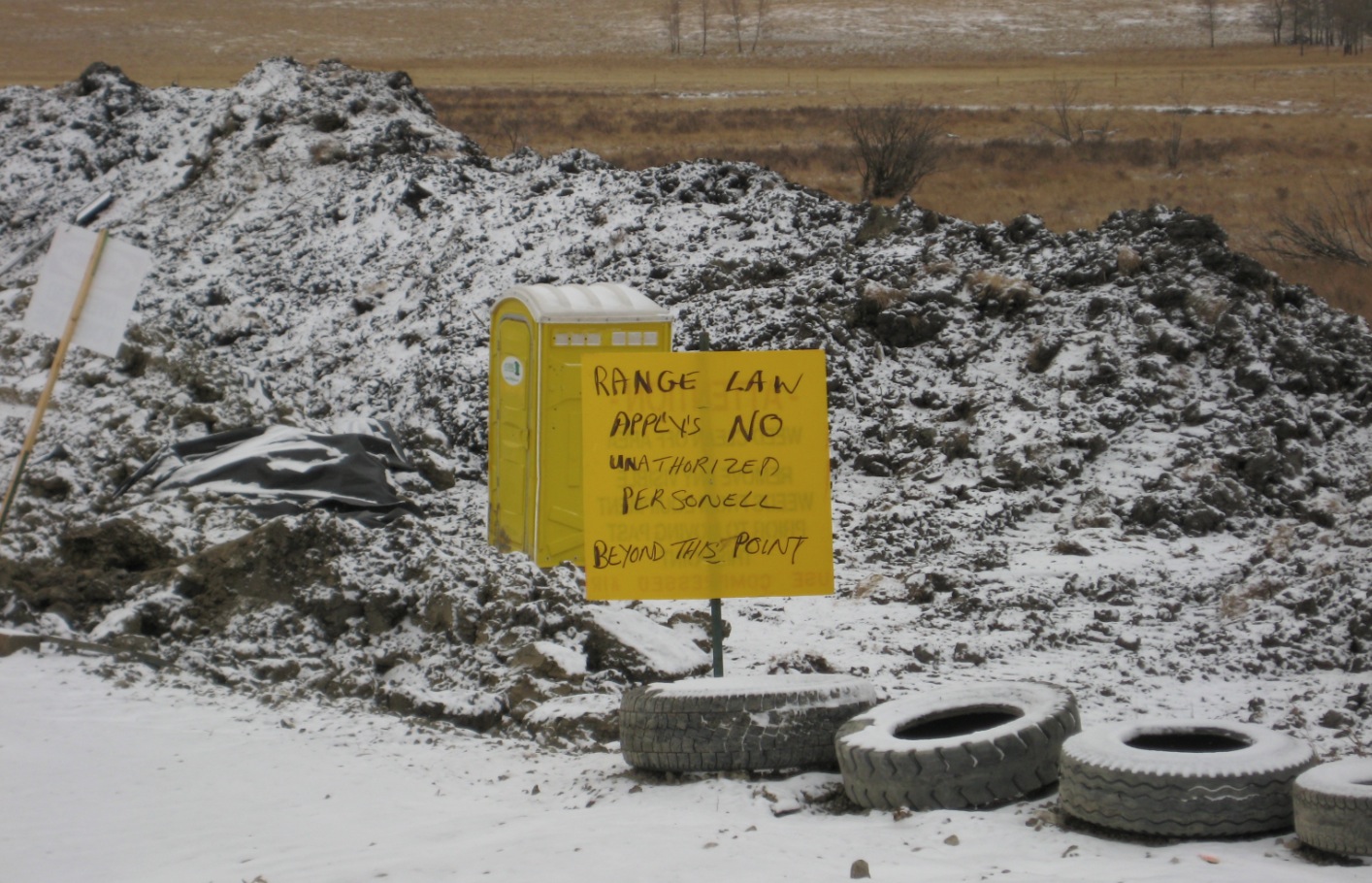
And then there's the pipelines and gathering lines ... . Rocky View County, Alberta
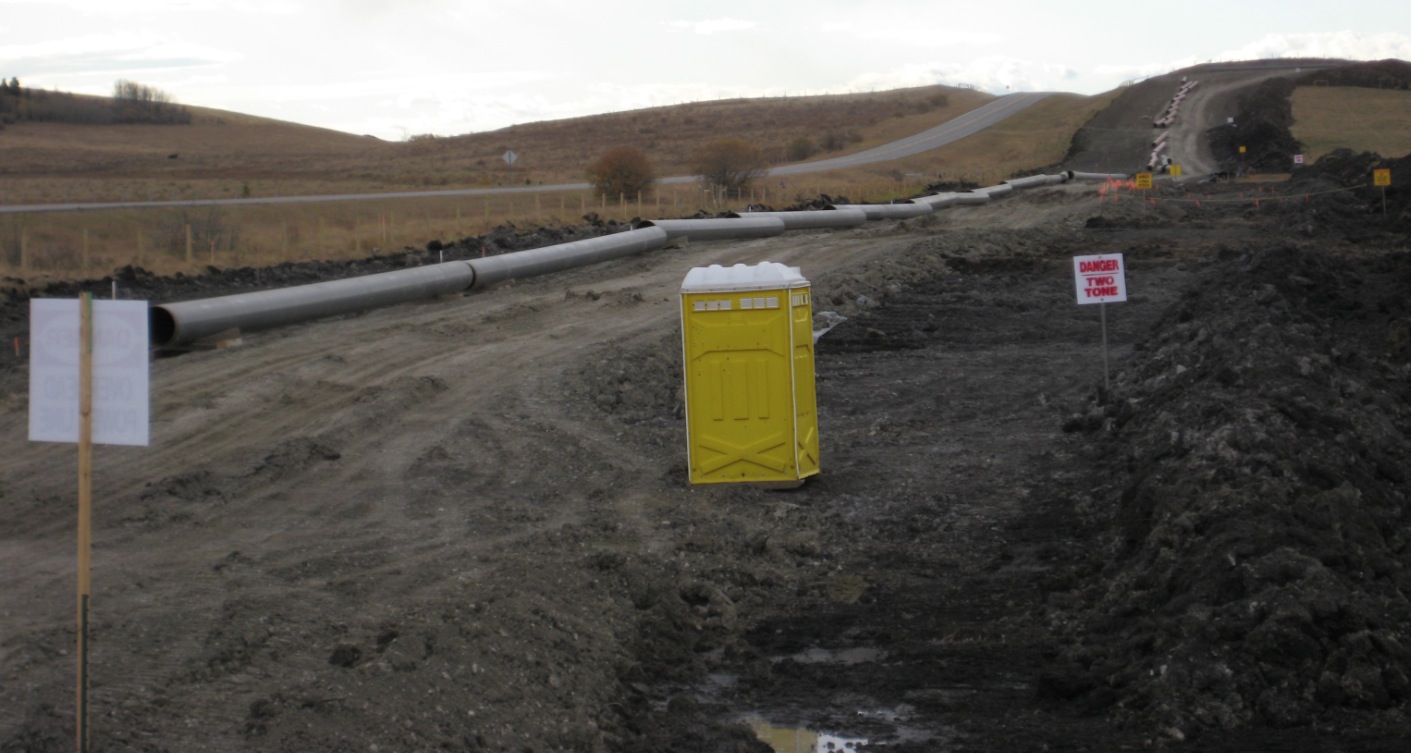
Another "industrial pathway." Rocky View County, Alberta
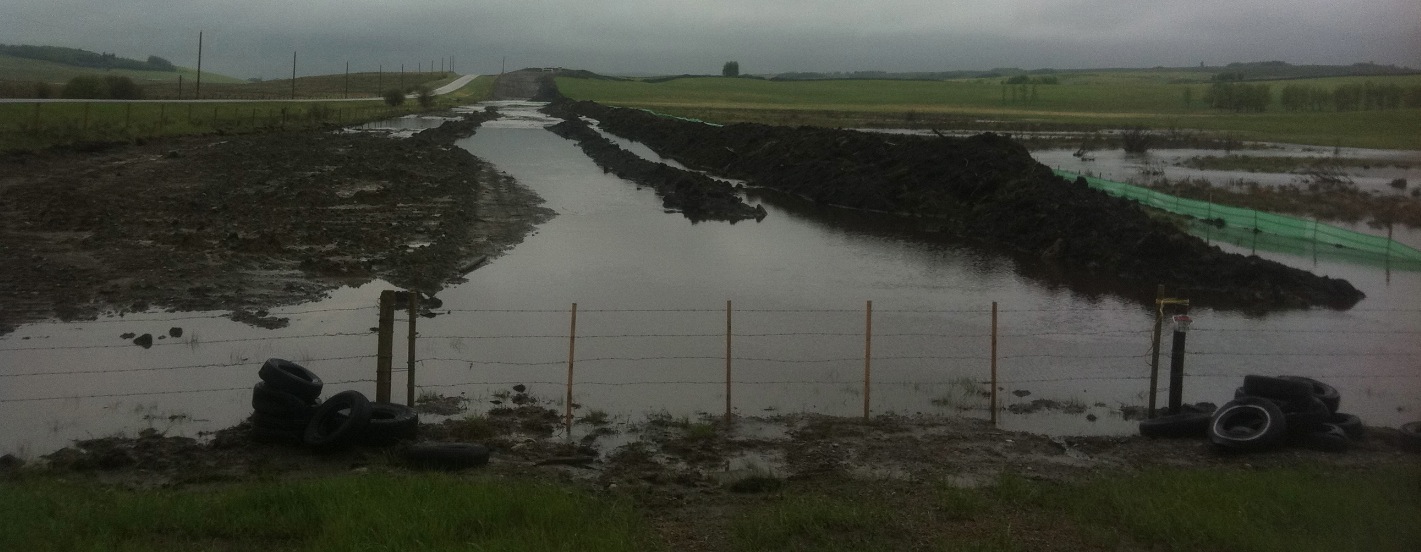
Sometimes it rains on "industrial pathways." Rocky View County, Alberta
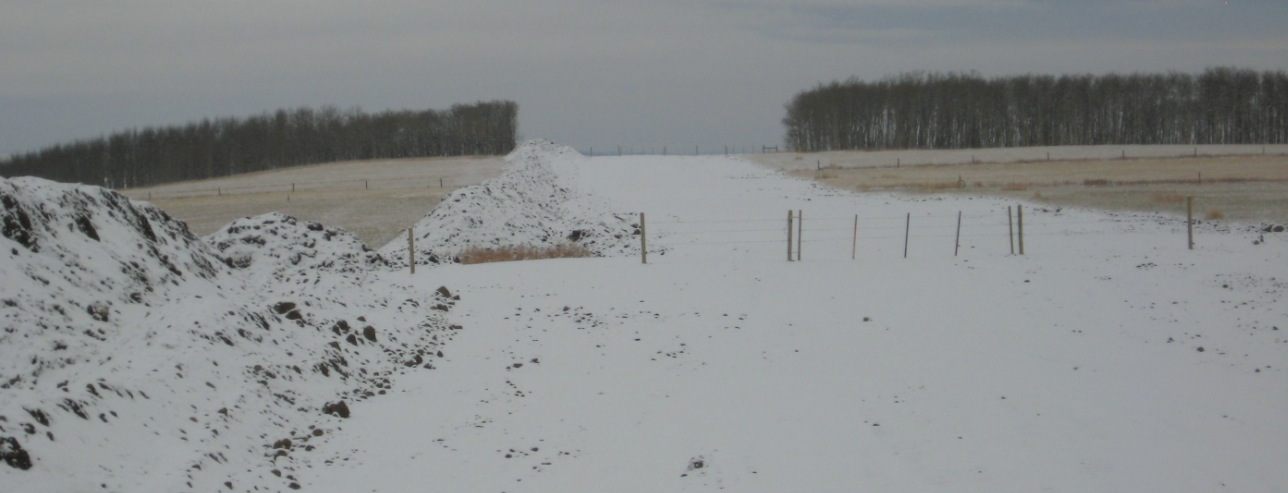
Can't see the forest for the pipeline. Rocky View County, Alberta
'... I think I can safely say the ERCB (Energy Resources Conservation Board) has been quoted as saying that there's never been an incident of a well being fracked in Alberta where it impacted water wells ... or otherwise caused any surface disturbance.' ... more.
Marshall Abbott, CEO Bernum Petroleum
Company Fracks And Contaminates Freshwater Aquifer Near Grande Prairie, Regulator Sits On It For Over A Year Before Going Public - All The While Publicly Stating There Has Never Been A Case Of Groundwater Contamination From Fracking
By Various Sources, December 21, 2012
On Sept. 22, 2011, workers from Crew Energy and service company GasFrac Energy Services attempted to frack a well in a liquids-rich gas reservoir near Grande Prairie in northern Alberta but what happened could be described as a comedy of errors. Except – with the heightened awareness of the environmental concerns with fracking – nobody is laughing. Workers on the well site failed to heed a number of warning signs and inadvertently perforated the well at about 137 metres below surface and delivered high-pressured shots of water, sand and toxic chemicals into the water table rather than the intended gas reservoir more than a kilometre further underground.
... Neither the ERCB nor Alberta Environment intends to fine Crew or GasFrac.
... ERCB released an investigation report that cites inadequate management of risks as one of the main causes of a September 2011 accident that contaminated groundwater with toxic hydraulic fracturing chemicals, including the cancer causing agent known as BTEX (benzene, toulene, ethylbenzene, and xylene). ... more.
LIPG Member Company TriOil Resources, Experiments With Propane Fracks In The Lochend
Newswire, September 19, 2011
TOL successfully executed its first liquid propane gas ("LPG") fracture stimulation in one of our existing cased vertical wells at Lochend. ... Early production rates are encouraging and we are in the planning stages for a second LPG fracture stimulation in another one of our 30 vertical wellbores. ... more.
"Propane butane gas fracs may appease opposition to hydraulic fracturing but only if the dangers are kept from the public" ... more.
Huge Polish Refiner Bids $184M For TriOil
Calgary junior the second this month subject to foreign takeover
By Dan Healing, September 16, 2013
CALGARY — A Polish refiner is the mystery suitor for Calgary-based TriOil Resources Ltd., the second oil and gas junior this month to agree to be sold to an “unlikely” state-controlled foreign company.
On Monday, TriOil announced it had struck a deal to be acquired for $184 million by Orlen Upstream, a subsidiary of PKN Orlen S.A., the largest petroleum and petrochemical corporation in Poland.
The deal is the first step into North America by Orlen and has similarities with the $223-million agreement by Calgary junior Novus Energy Inc. two weeks ago to be purchased by Chinese state-owned Yanchang Petroleum International Ltd., also its first North American venture.
Both companies have substantial stakes in prolific unconventional oil plays — the Cardium for TriOil and the Saskatchewan Viking for Novus — and both deals resulted from the companies putting themselves up for sale last winter. ... more.
October 19, 2011 The Cochrane Eagle
“From what we know,” added Pickup “there has been no study on the cumulative effects of these oil wells being placed so close together.”
... Pickup described the area near Big Hill Springs Provincial Park as just the beginning of what’s coming. “It is ugly.”
Highway 567 and 34 is what Pickup calls ‘frack ally.’ “They’re putting up rigs beside houses; they’re putting in a six multi-well pad. We are so saturated it’s absolutely frightening.
“With the federal government now saying that they are going to study hydraulic fracturing…they know what’s happening throughout the rest of the world. Put a moratorium on it now.” ... more.
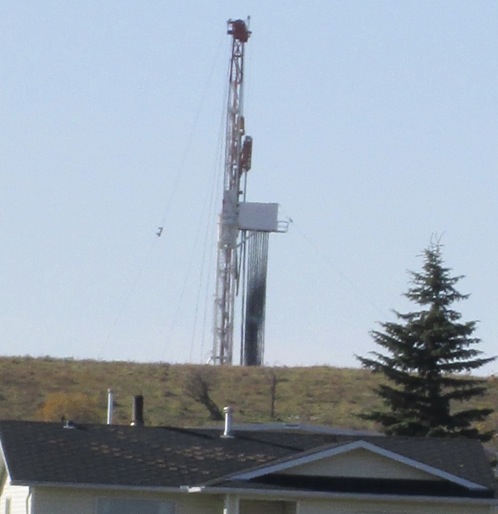
Lochend Drilling near homes. Rocky View County, Alberta
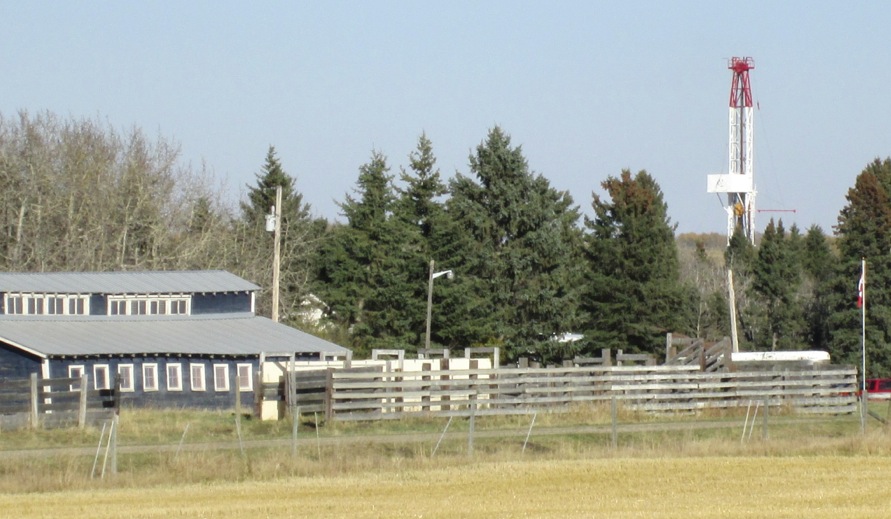
Lochend drilling near homes. Rocky View County, Alberta
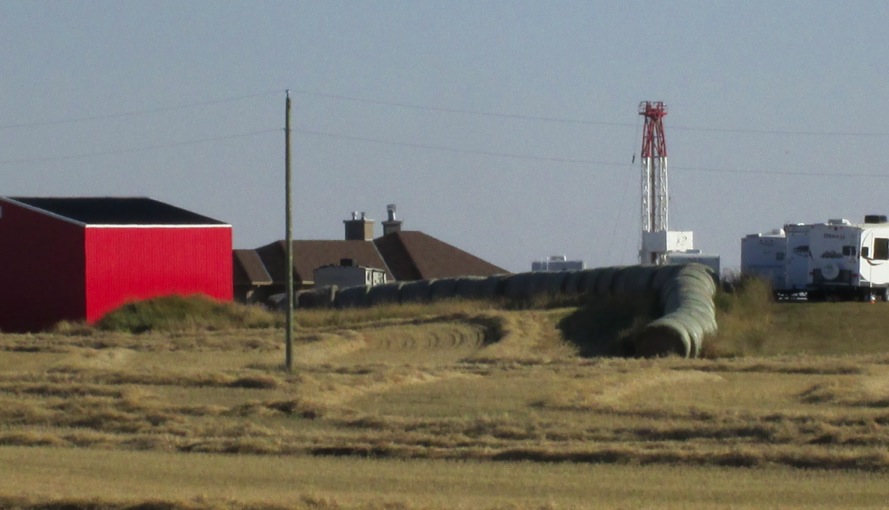
Lochend drilling near homes. Rocky View County, Alberta
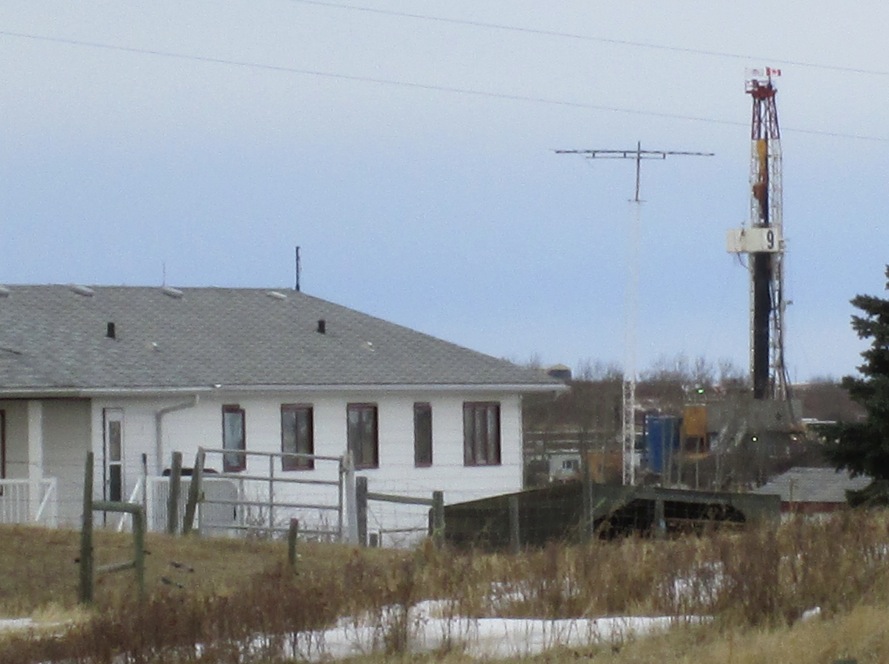
Lochend drilling near homes. Rocky View County, Alberta
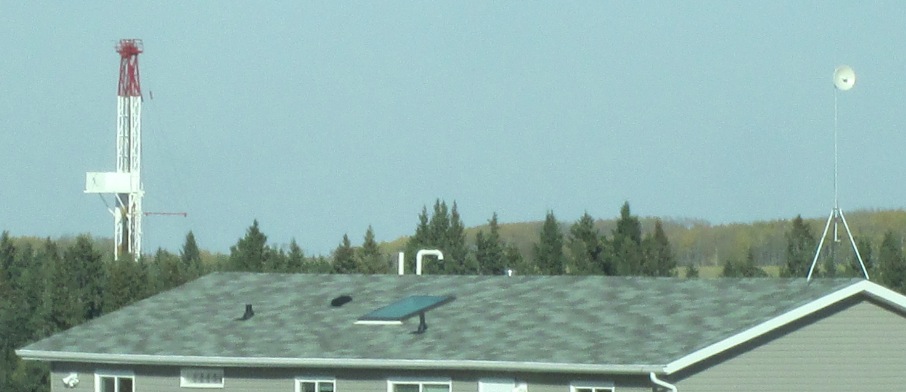
Lochend drilling near homes. Rocky View County, Alberta
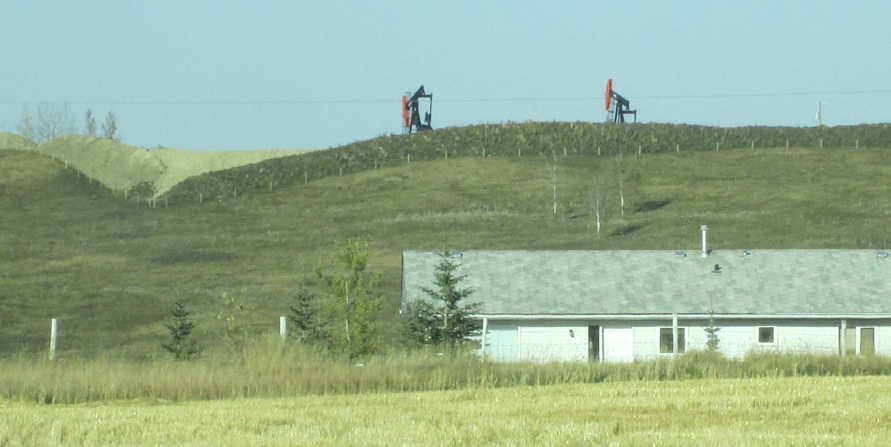
Multi-well pads near homes in the Lochend. Rocky View County, Alberta

After a frack job near homes in the Lochend. The blurry bit in the middle of the photo is the burning off of waste gases and chemicals. Rocky View County, Alberta

Fracked wells near homes in the Lochend. Rocky View County, Alberta.

Drilling near homes in the Lochend. Rocky View County, Alberta.
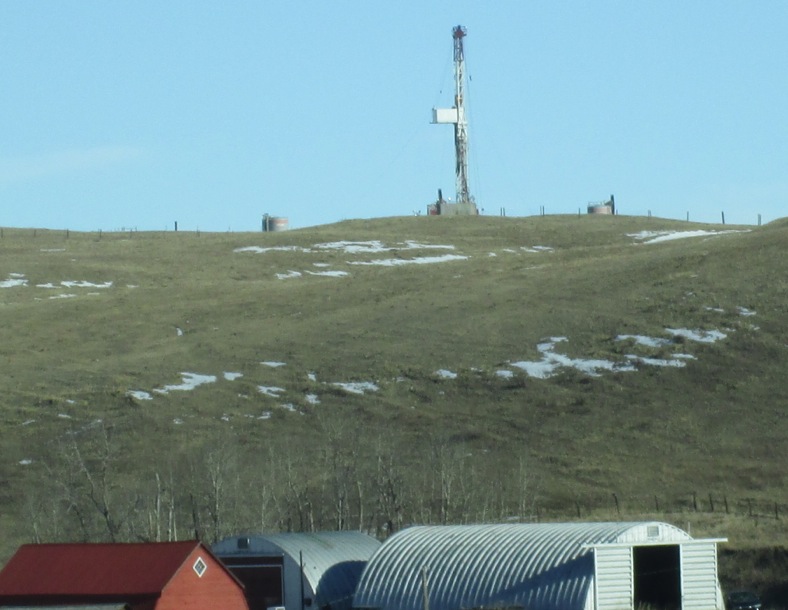
Lochend drilling near homes. Rocky View County, Alberta
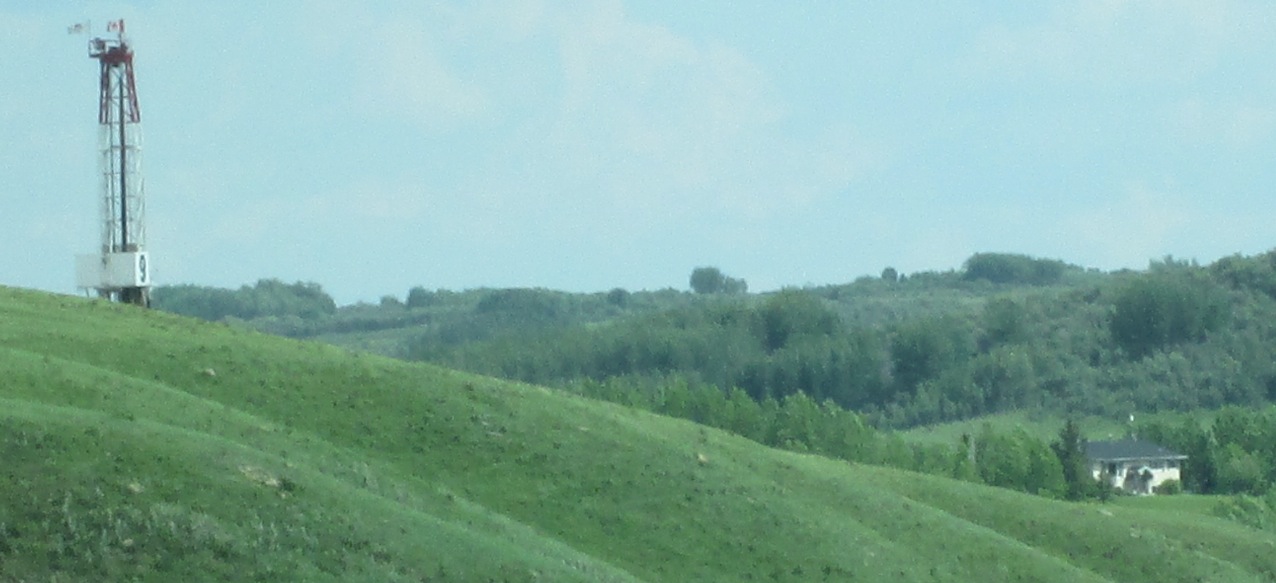
Lochend drilling near homes. Rocky View County, Alberta
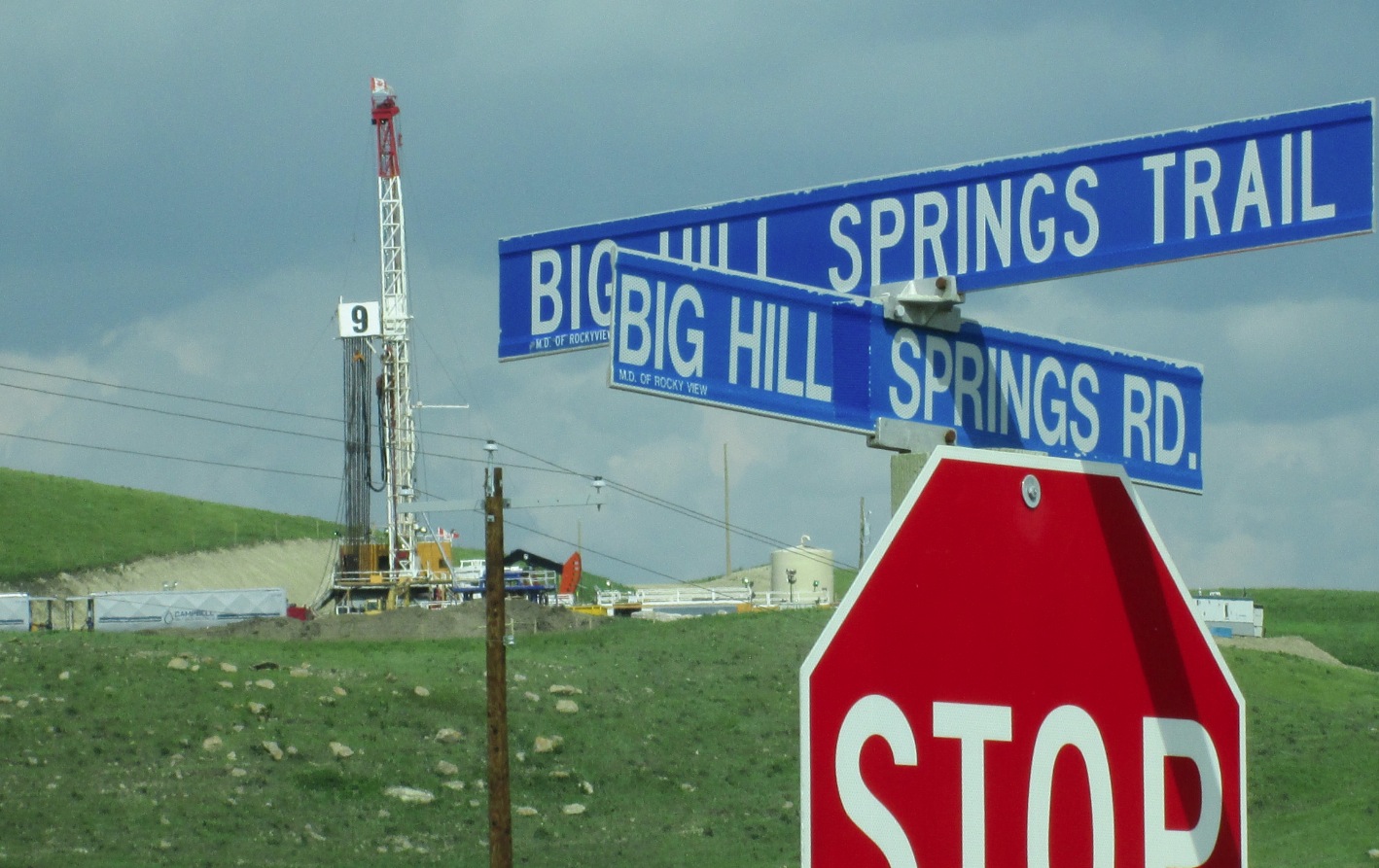
Carving out the hills. Drilling across from Big Hill Springs Provincial Park, Rocky View County, Alberta
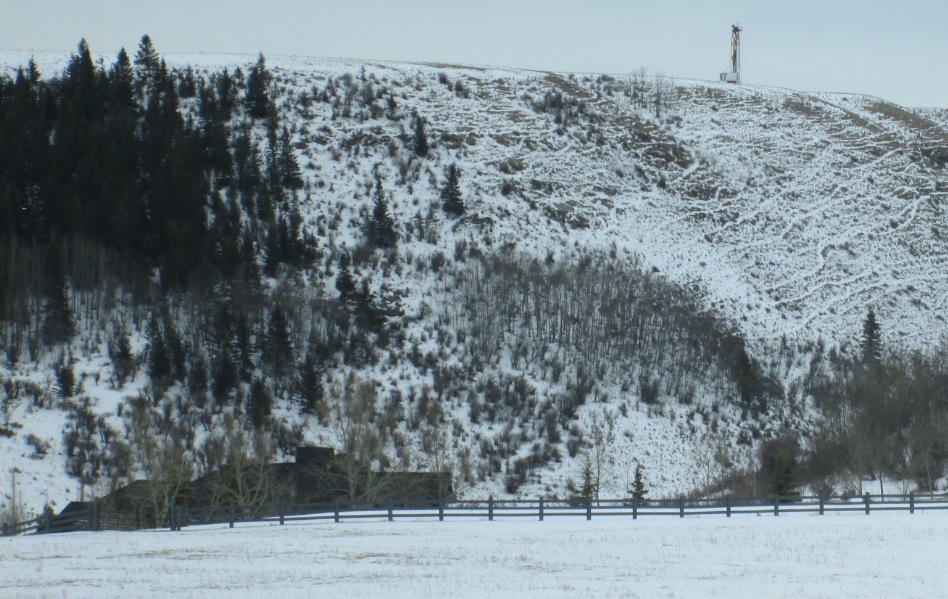
Drilling rig overlooking Big Hill Springs Provincial Park and a home. Rocky View County, Alberta
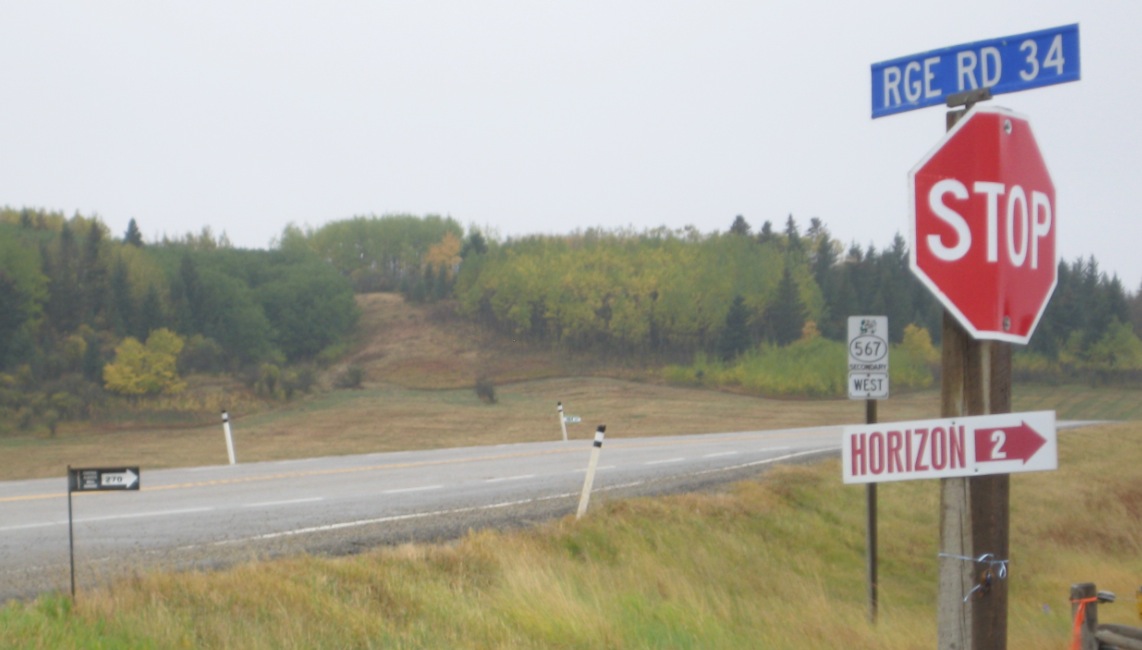
Why bother pounding in a little stake for that rig sign, when you can use a stop sign. Across from Big Hill Springs Provincial Park, Rocky View County, Alberta.
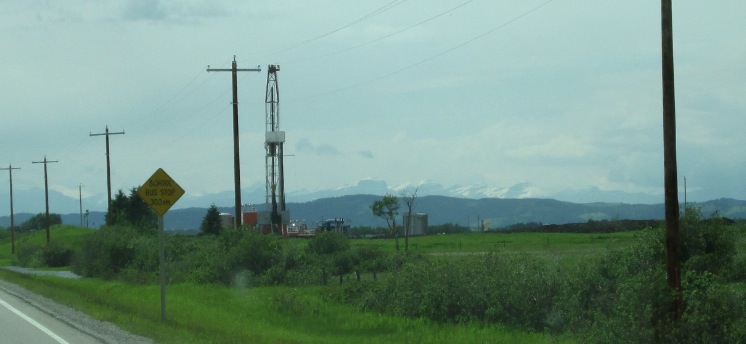
Drilling rig near homes in the Lochend. Rocky View County, Alberta.
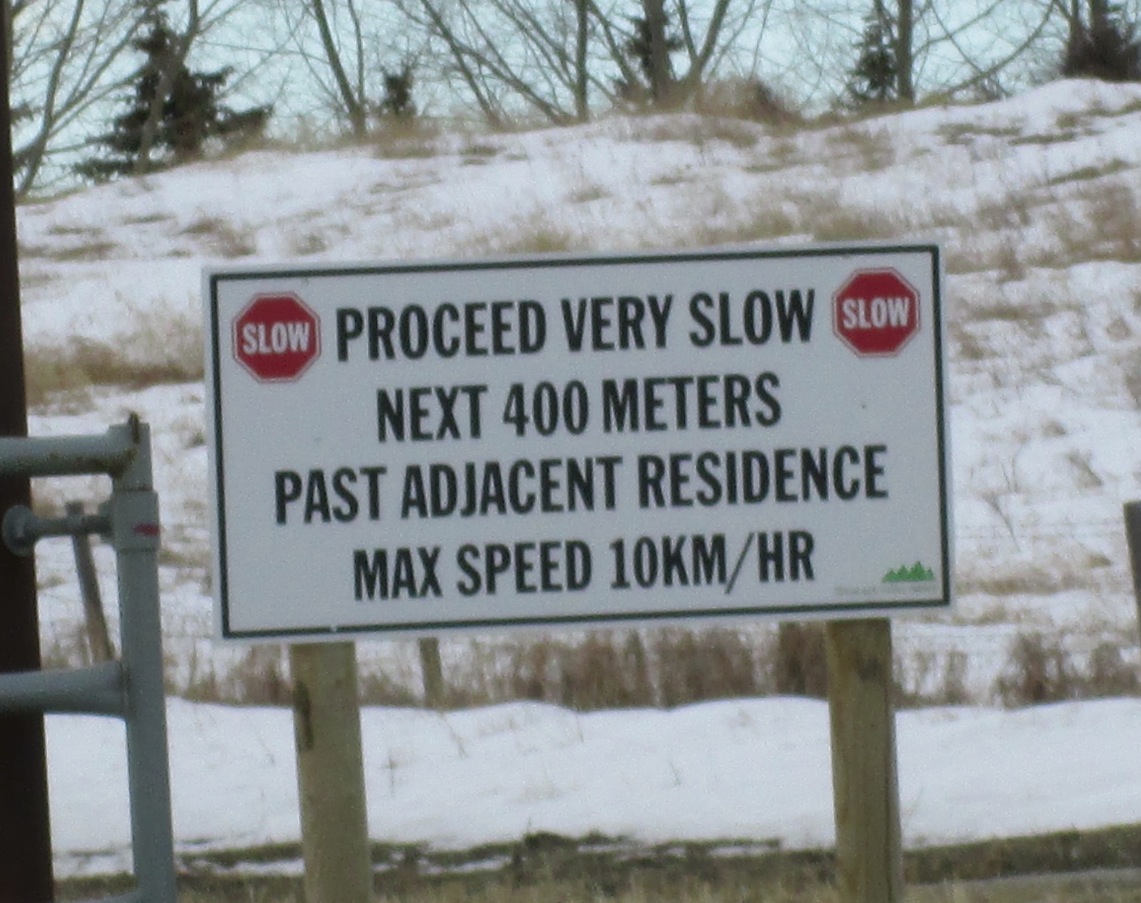
An oil company posts a sign for their drivers in the Lochend and a resident responds. - "Yes, please go slow past our homes with all your secret chemicals, toxic wastes, explosive and radioactive materials. Rocky View Fire Fighter jobs have been decimated and response times are expected to be longer. Thank you."
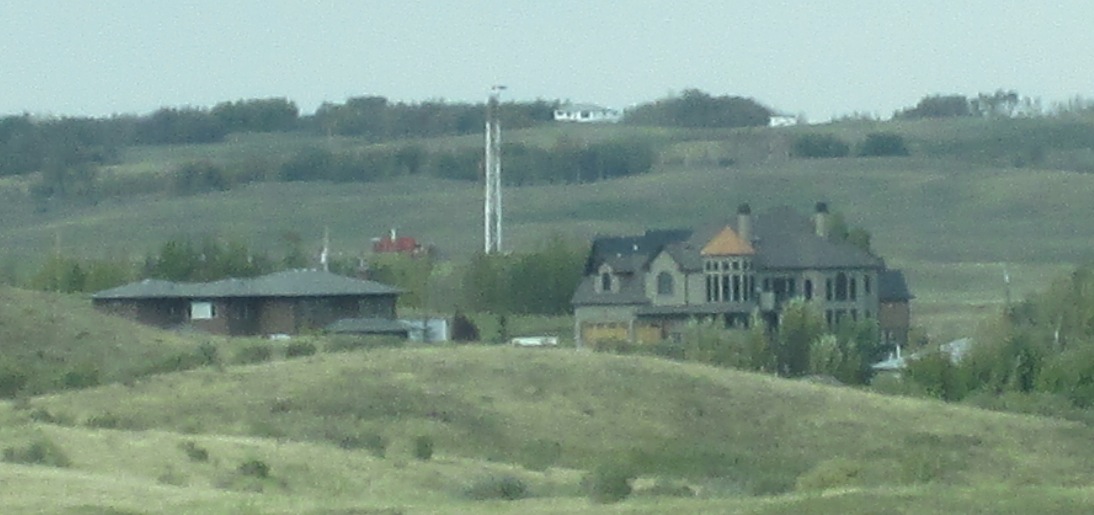
After a frack job in Bearspaw, a service rig towers behind homes. Rocky View County, Alberta
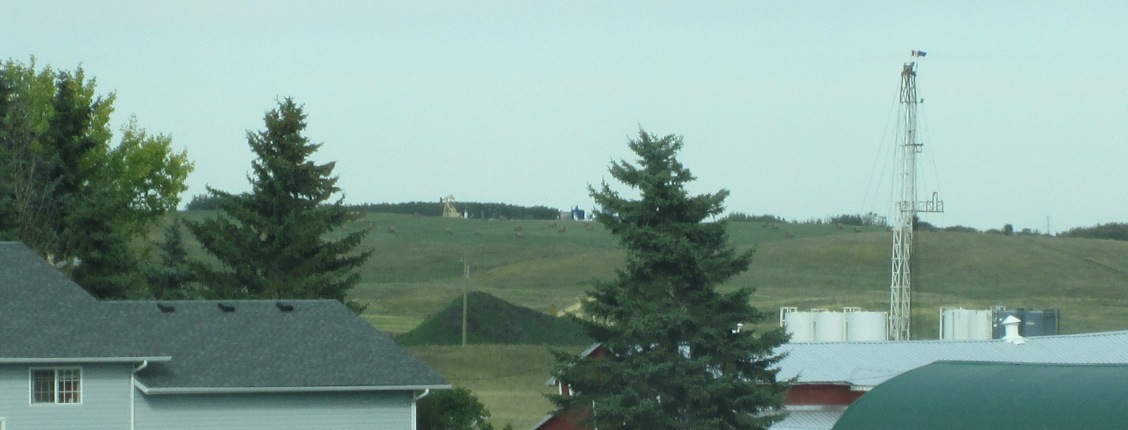
A service rig and tanks fill a multi-well pad near a home, after a frack job in Bearspaw. Rocky View County, Alberta
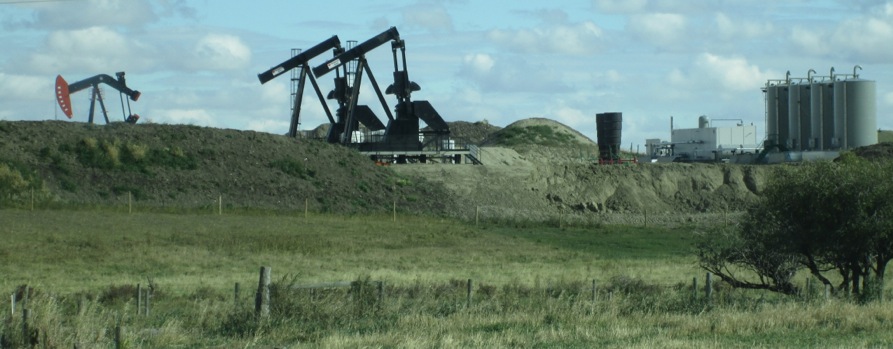
Fracked wells on a multi-well pad on Twp Road 262, east of Bearspaw Road in Bearspaw, Rocky View County, Alberta
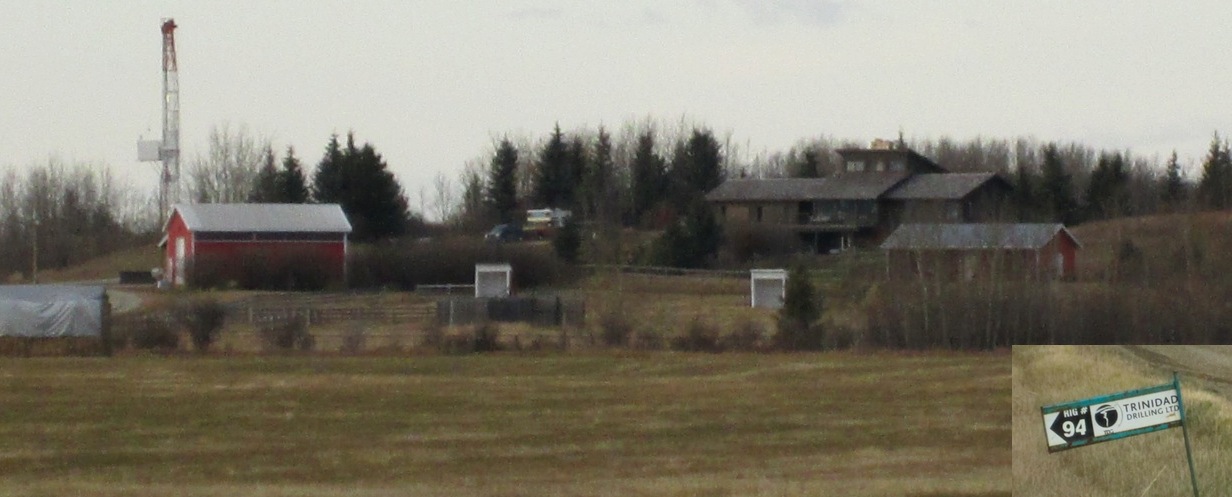
Drilling near homes off Horse Creek Road and Twp. Road 274 - Rocky View County, Alberta

Service rig on a well pad after a frack job near homes between Camden Lane and the Town of Cochrane, Alberta
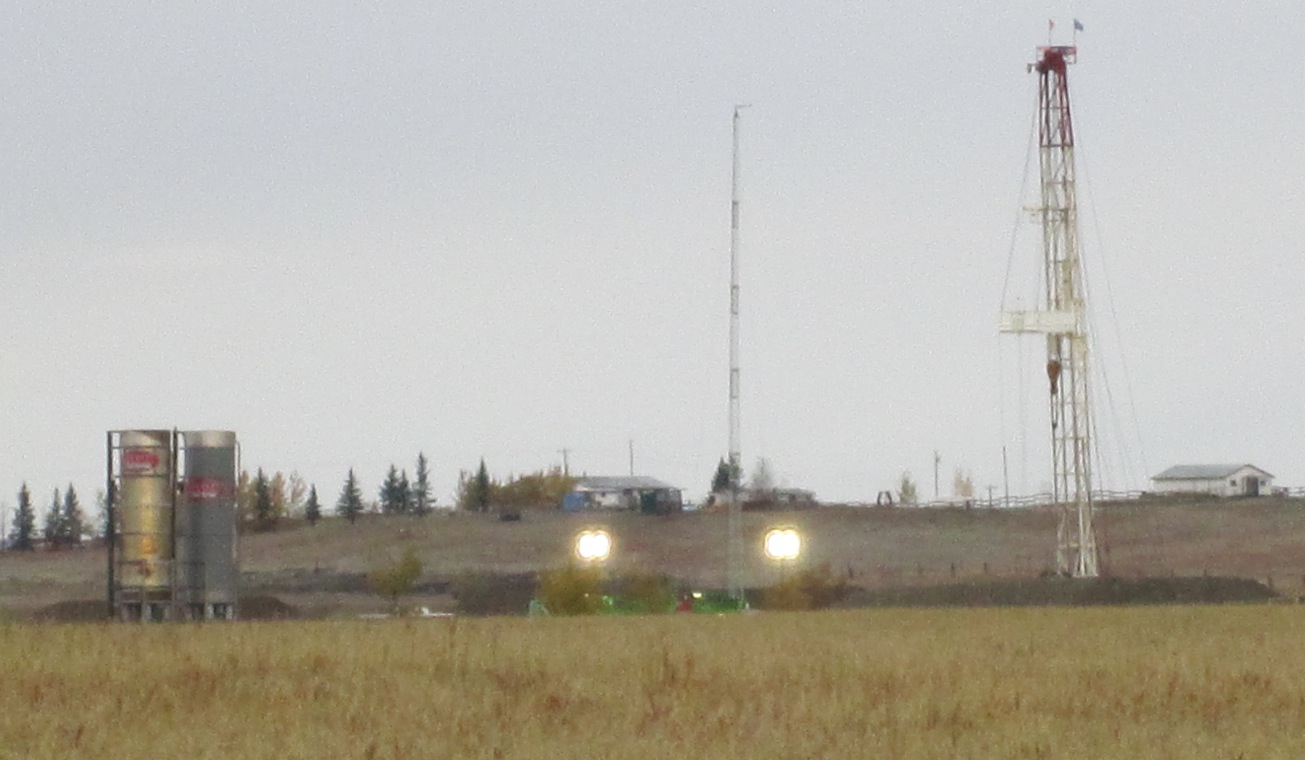
Two 'flare shields' stand on the well pad after a frack job near homes between Camden Lane and Cochrane, Alberta
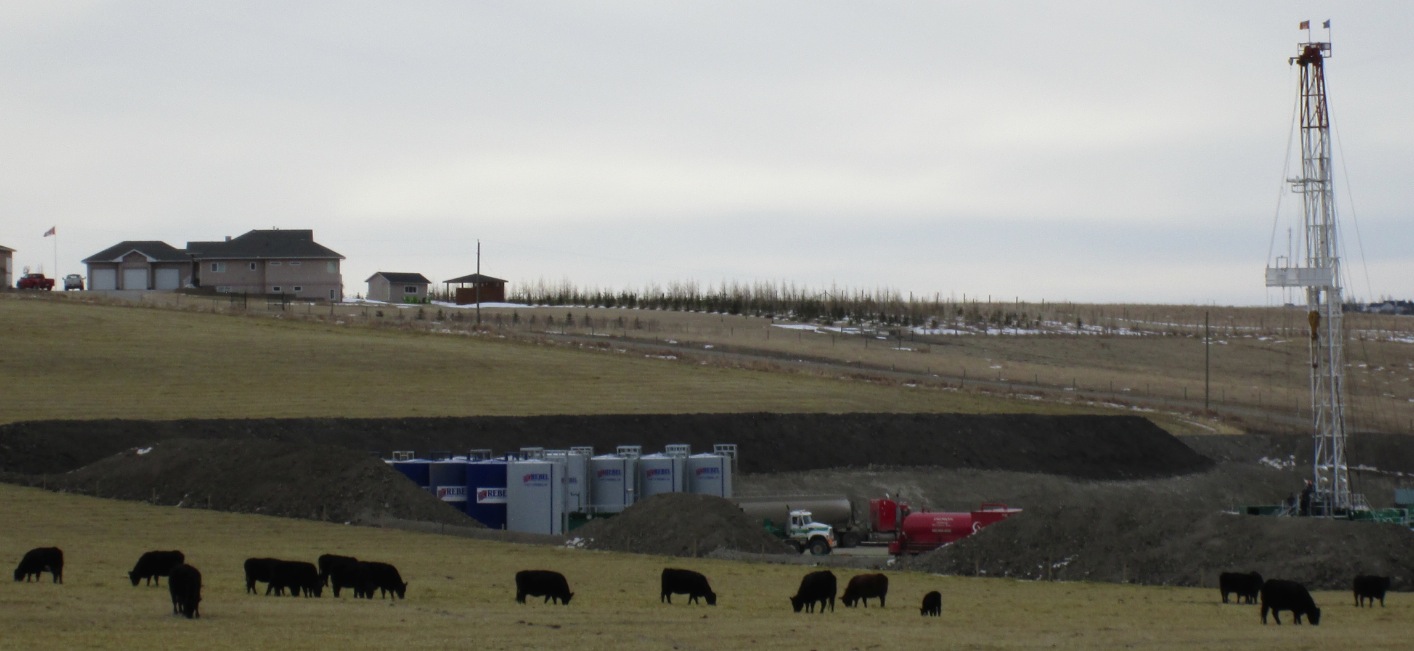
Flow-back tanks stand on a well pad after a frack job near homes and the Town of Cochrane's new residential development of Sunset Ridge.
Oil Executive Unable To Dodge Own Industry "Bullets":
Exxon Mobil Chairman and CEO Rex Tillerson, his wife and neighbours - launch lawsuit citing “unreasonable discomfort,” “annoyance to persons of ordinary sensibilities,” “fear,” “apprehension,” “offence,” “loss of peace of mind,” “emotional harm,” etc.
Exxon CEO Joins Suit Citing Fracking Concerns
"I cannot stay in a place," he said, "where I do not know who to count on and who not to count on."
As stated in the lawsuit:
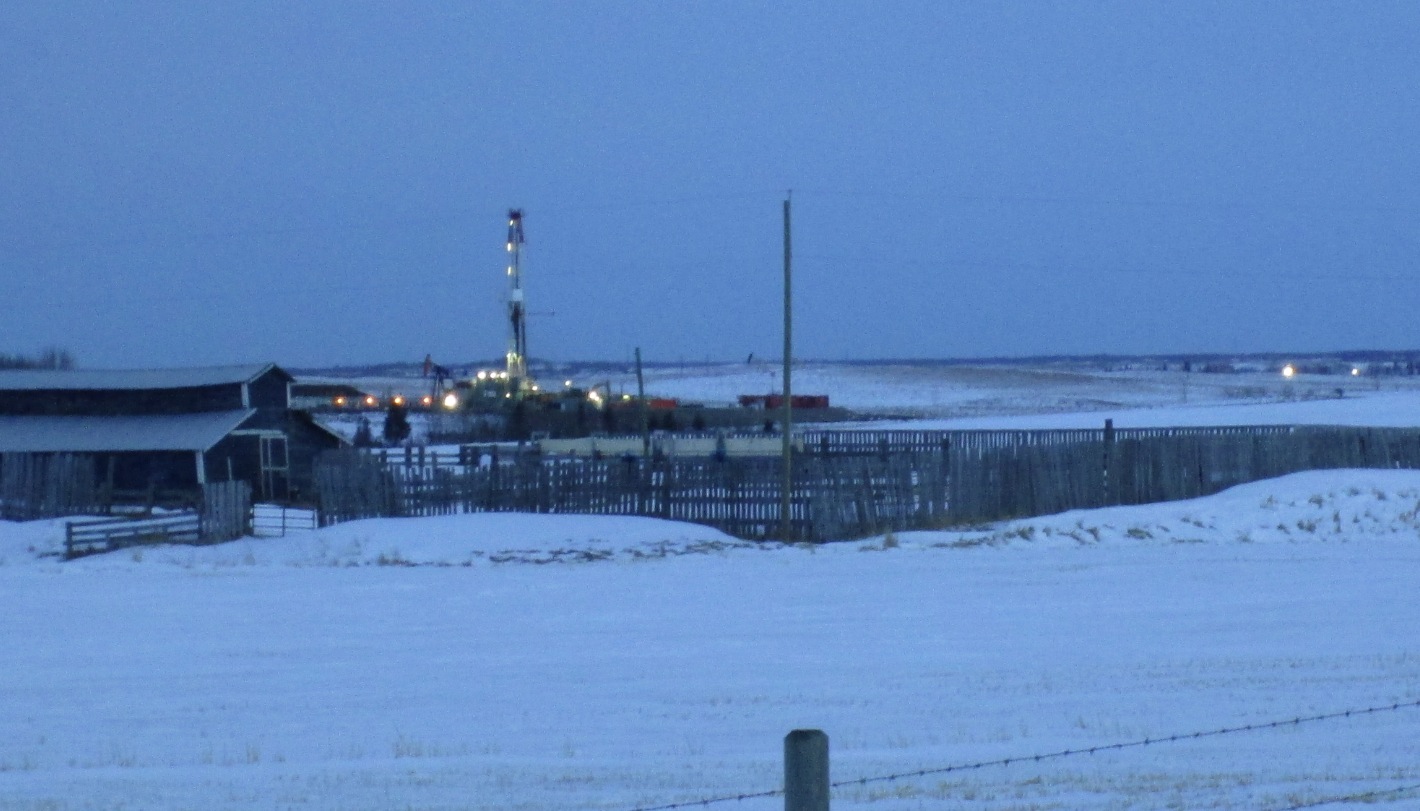
This is not a water tower, it's a drilling rig in the Lochend area of Rocky View County, Alberta. The lights to the right of this drill site is a frack job being performed at another site nearby. 2014
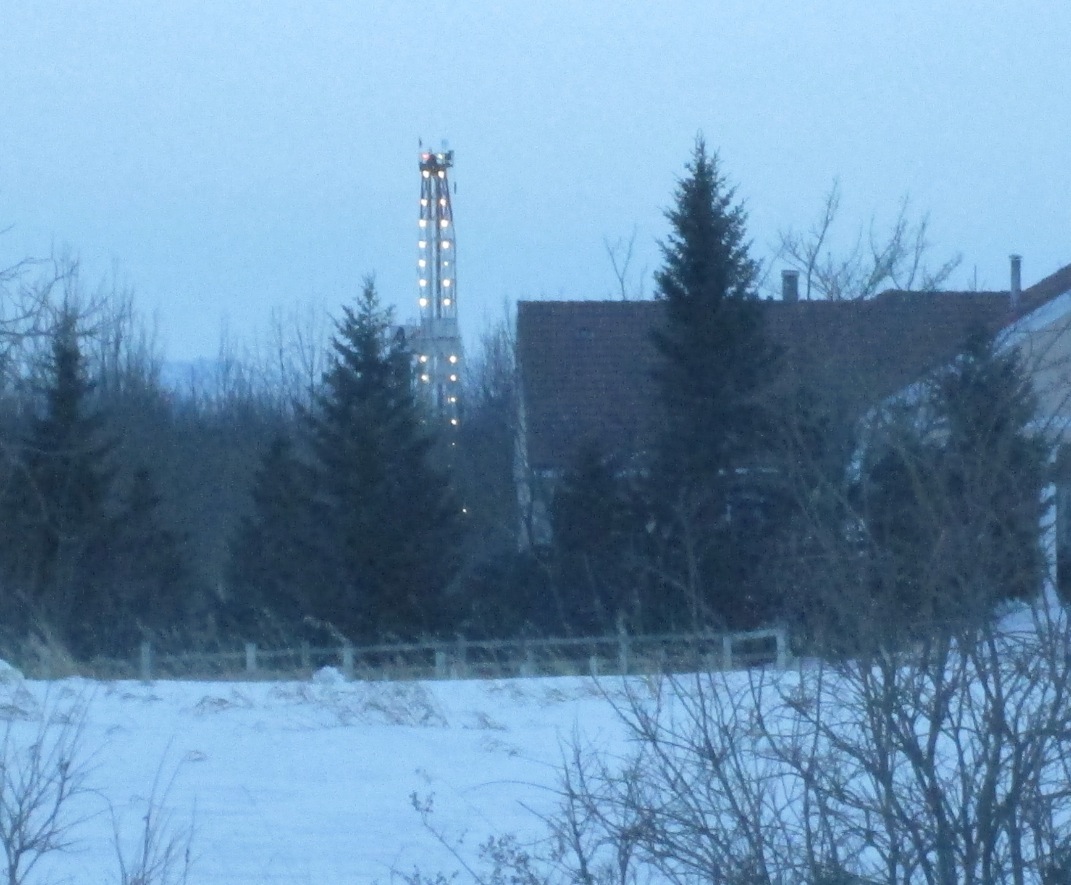
Nope, not a water tower. Drilling the Lochend Area at night. 2014

Lochend area. Rocky View County, Alberta
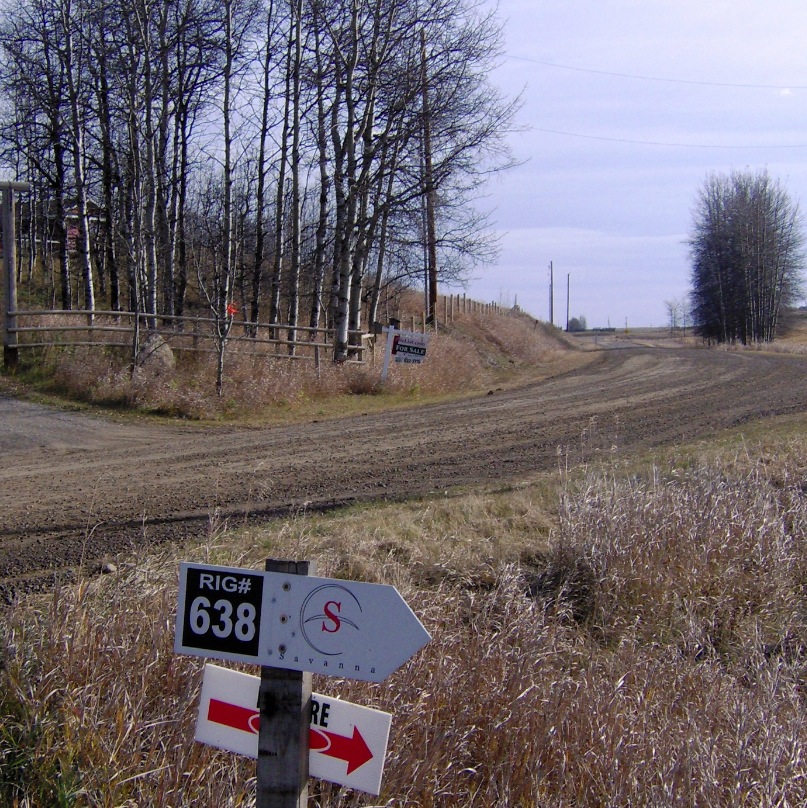
Lochend area. Rocky View County, Alberta
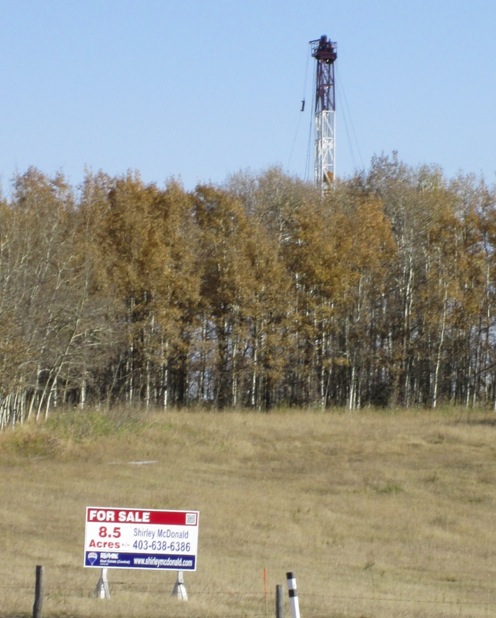
Lochend area. Rocky View County, Alberta
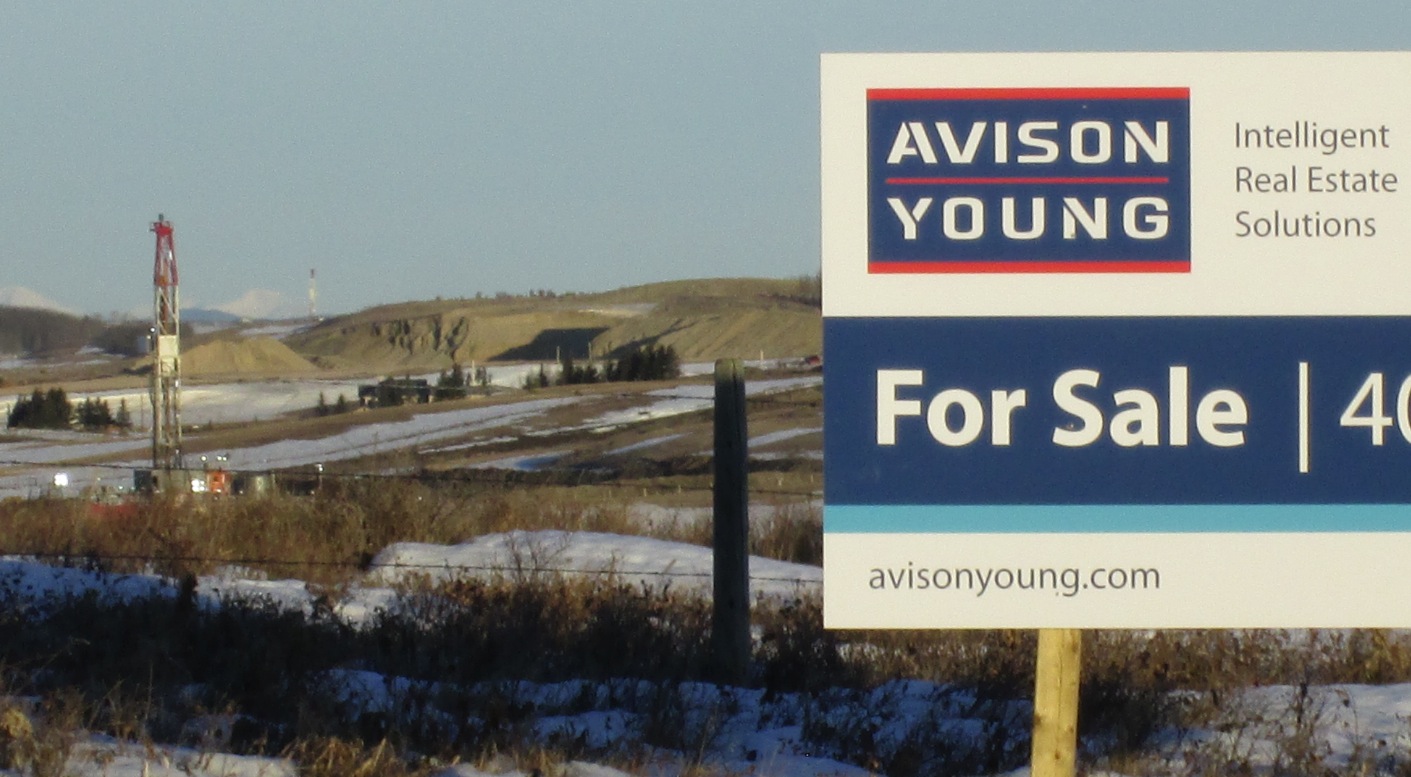
Bearspaw Area. Rocky View County, Alberta
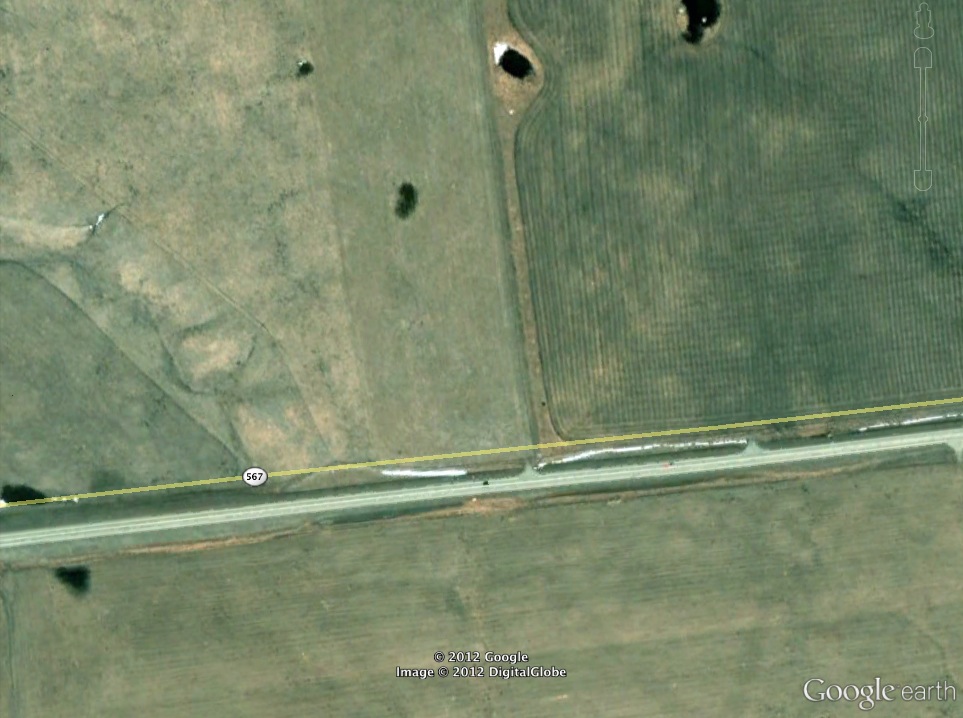
Highway 567 to Big Hill Springs Provincial Park - Rocky View County, Alberta - Before the frack invasion.
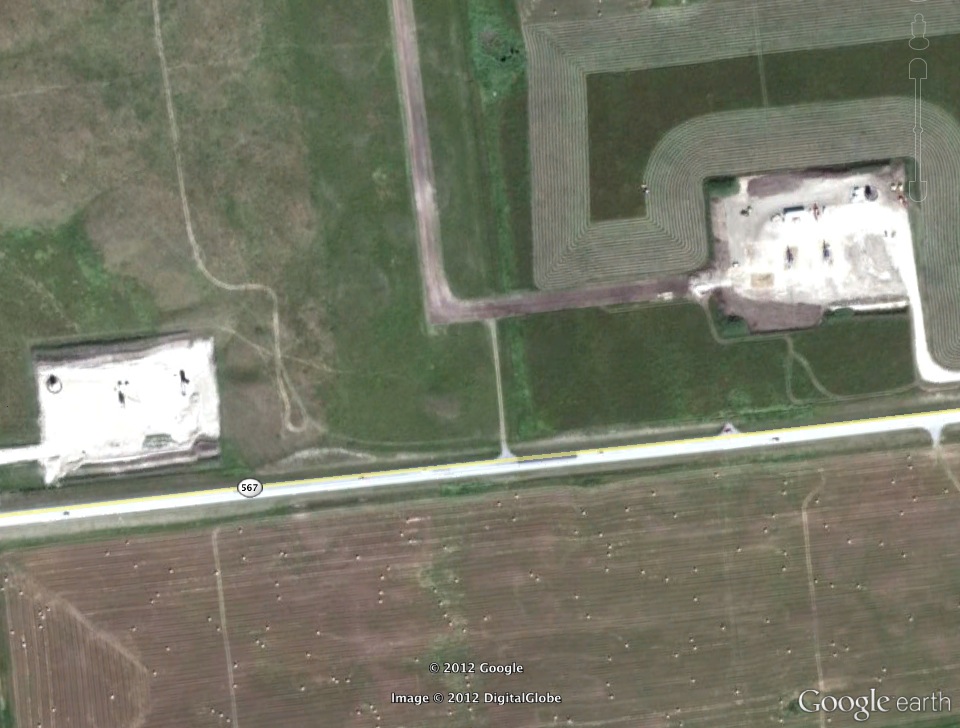
After - The fracking footprints are immense
Bernum to Frack One of "Canada's Richest Postal Codes"
The company recently made a financial contribution to the Glenbow Ranch Provincial Park
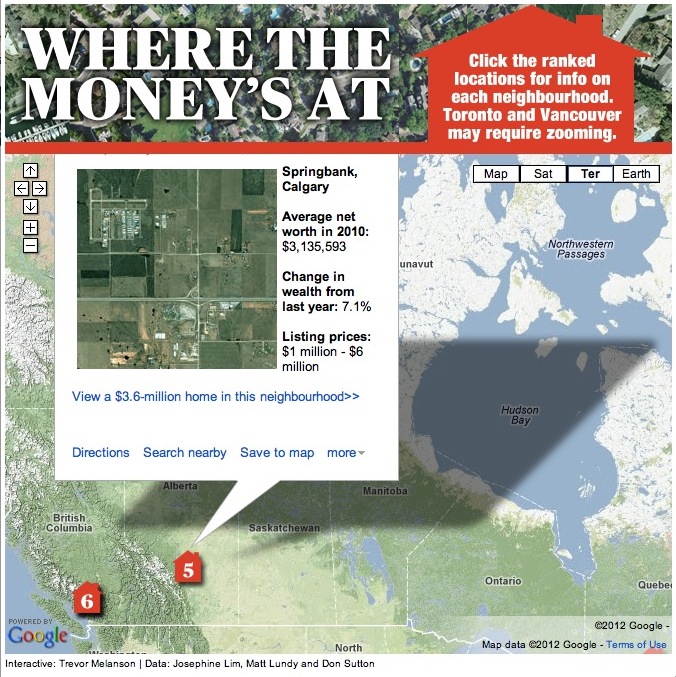 Canada's 10 Richest Postal Codes - Source: Canadian Business.comTwo new drilling sites have been approved in north Springbank, tapping into the area’s popular Cardium zone formation.
Canada's 10 Richest Postal Codes - Source: Canadian Business.comTwo new drilling sites have been approved in north Springbank, tapping into the area’s popular Cardium zone formation.Birch Lake Energy , Bernum Petroleum and a Petrobakken Cochrane well featuring a 2 mile horizontal.
"The 2-mile horizontal well licensed at 4-11-26-4 W5 may lead a new technological improvement."
Please Be Patient While They Try To Figure Out The “Kinks” ... And Have A Go At Each Other
 Birch Lake announces claim commenced by Bernum Petroleum
Birch Lake announces claim commenced by Bernum Petroleum
Scandinavian Oil.Gas Magazine, March 28, 2013
Birch Lake Energy Inc. says that Bernum Petroleum Ltd. has filed a statement of claim against Birch Lake regarding the Company's Lochend Assets, being the non-operated working interest of 40% in certain petroleum and natural gas rights underlying 7,760 gross acres (2,718 net) in the Lochend-Bearspaw area of Alberta. ...
... The Company has taken immediate steps to vigorously defend this claim and preserve its rights in the joint venture assets including a detailed review of the completion operations on the initial well which led to the apparent collapse of the production casing string during the frac operation and the resulting loss of more than half the productive well bore.
The Corporation is also conducting a detailed review of the drilling operations of the second well during which intermediate casing was not able to be successfully run to depth drilled, resulting in drilling difficulties during the horizontal section and the eventual loss of the horizontal section after nearly reaching total depth. ... more.
... Several residents want to know where these companies get the millions of gallons of water they use for their ‘fracking’ activities.
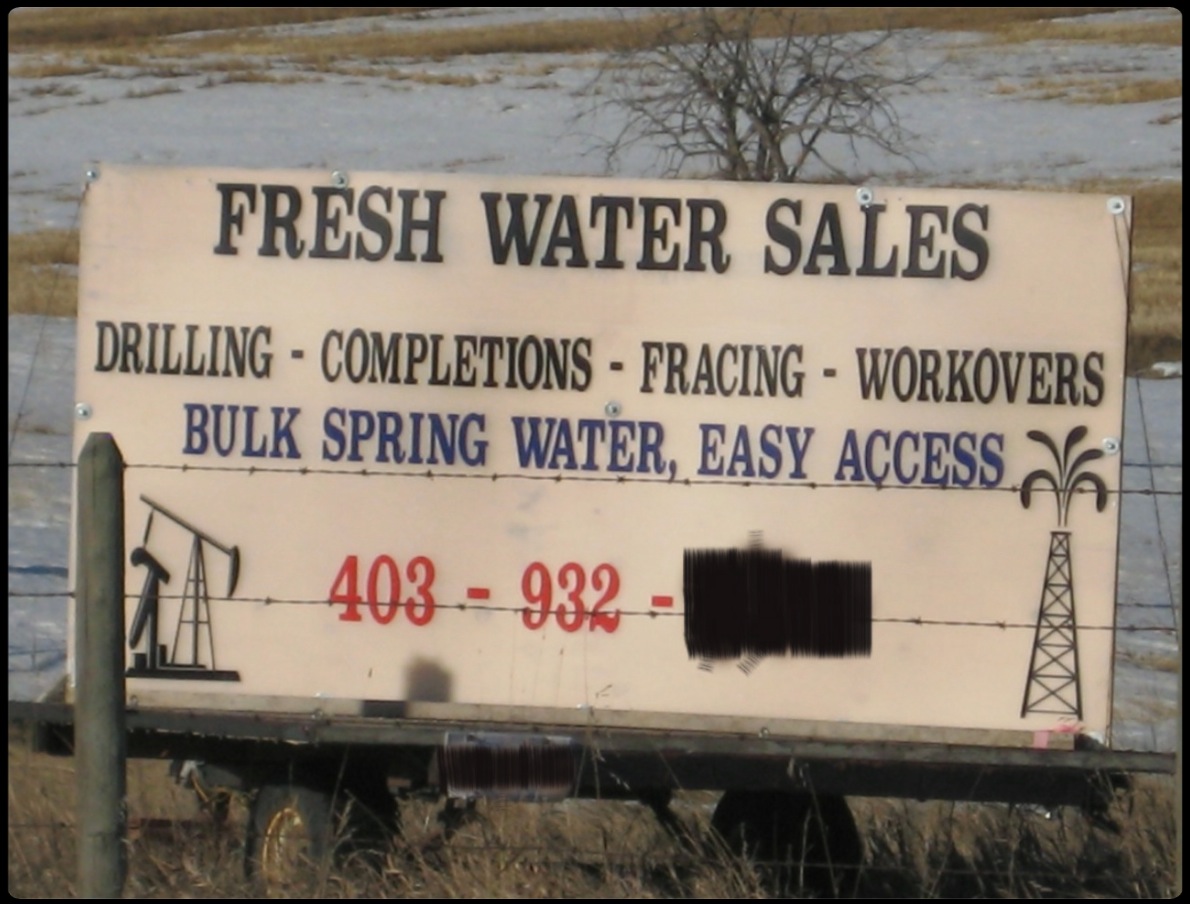 Water for sale sign as seen in a field from Hwy 22 North of Cochrane, Alberta - *We have blocked out last digits of phone number and plate number, as sign has now been removed or moved.With a slew of oil and gas companies operating in the Cochrane area, many just to the north of town in what is called the Cardium formation – which is believed to have approximately 84 million cubic metres of untapped oil along with 58 million cubic metres of remaining gas – several residents want to know where these companies get the millions of gallons of water they use for their ‘fracking’ activities.
Water for sale sign as seen in a field from Hwy 22 North of Cochrane, Alberta - *We have blocked out last digits of phone number and plate number, as sign has now been removed or moved.With a slew of oil and gas companies operating in the Cochrane area, many just to the north of town in what is called the Cardium formation – which is believed to have approximately 84 million cubic metres of untapped oil along with 58 million cubic metres of remaining gas – several residents want to know where these companies get the millions of gallons of water they use for their ‘fracking’ activities.Five companies with fracking operations in the Cochrane area form the Lochend Industry Producers Group (LIPG), and consist of Equal Energy, NAL Resources, PetroBakken Energy, Tamarack Valley Energy and TriOil Resources. ... more.
A Lochend Long-Reach Horizontal - Featuring 40 Fracks
... We are encouraged by the early results of this well and plan to drill 2 additional long-reach horizontal wells in the first half of 2013. ... more.
Cochrane Reviews Environmental and Social Policies on Water Use for Hydraulic Fracturing
McBride said the amount of water used by the fracking operation is actually quite small
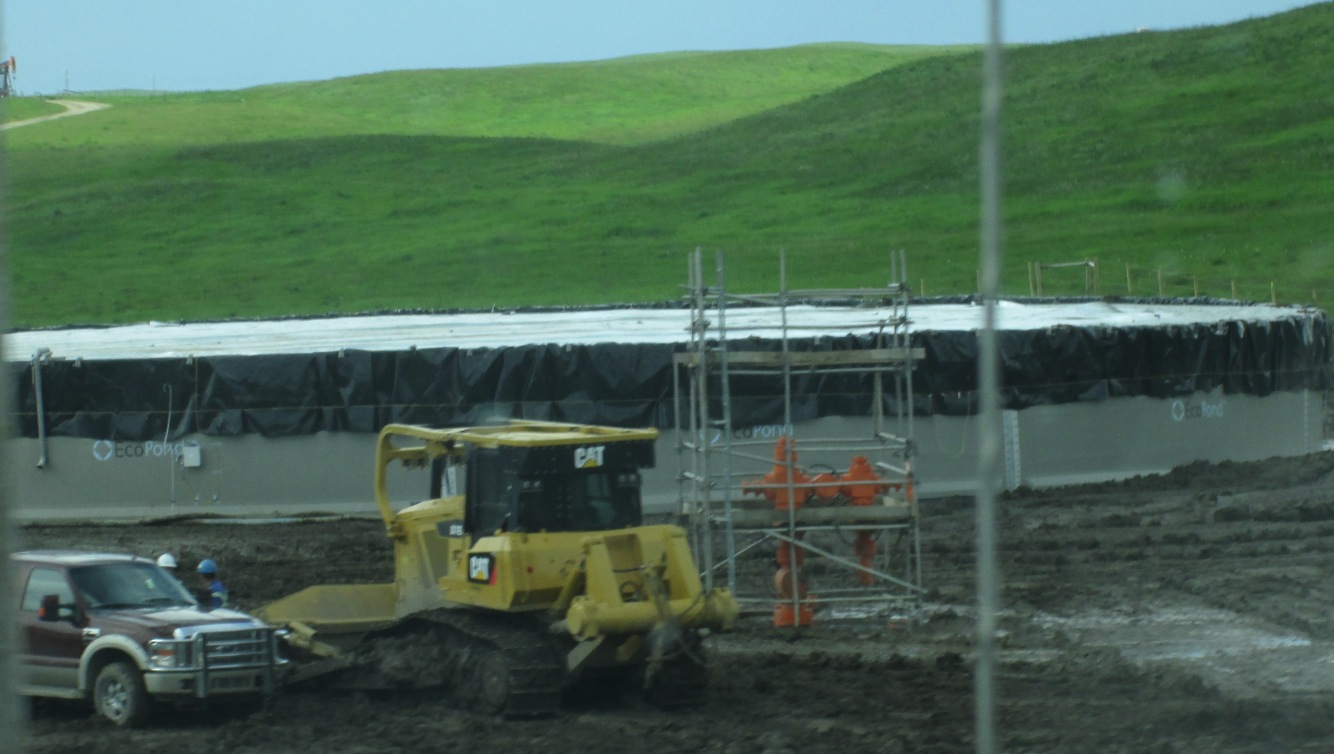
Sources of Water for Fracking Troubles Some in Community
Present policy states that water is to be reused whenever possible. Water for the purposes of ‘frack’ fluid, however, is not reused due to the various chemicals that are added to the fluid.

Cochrane's Bulk Water Supply ‘Secondary’ Source for LIPG
The LIPG did not have an exact amount of water they have purchased from the town during the past year
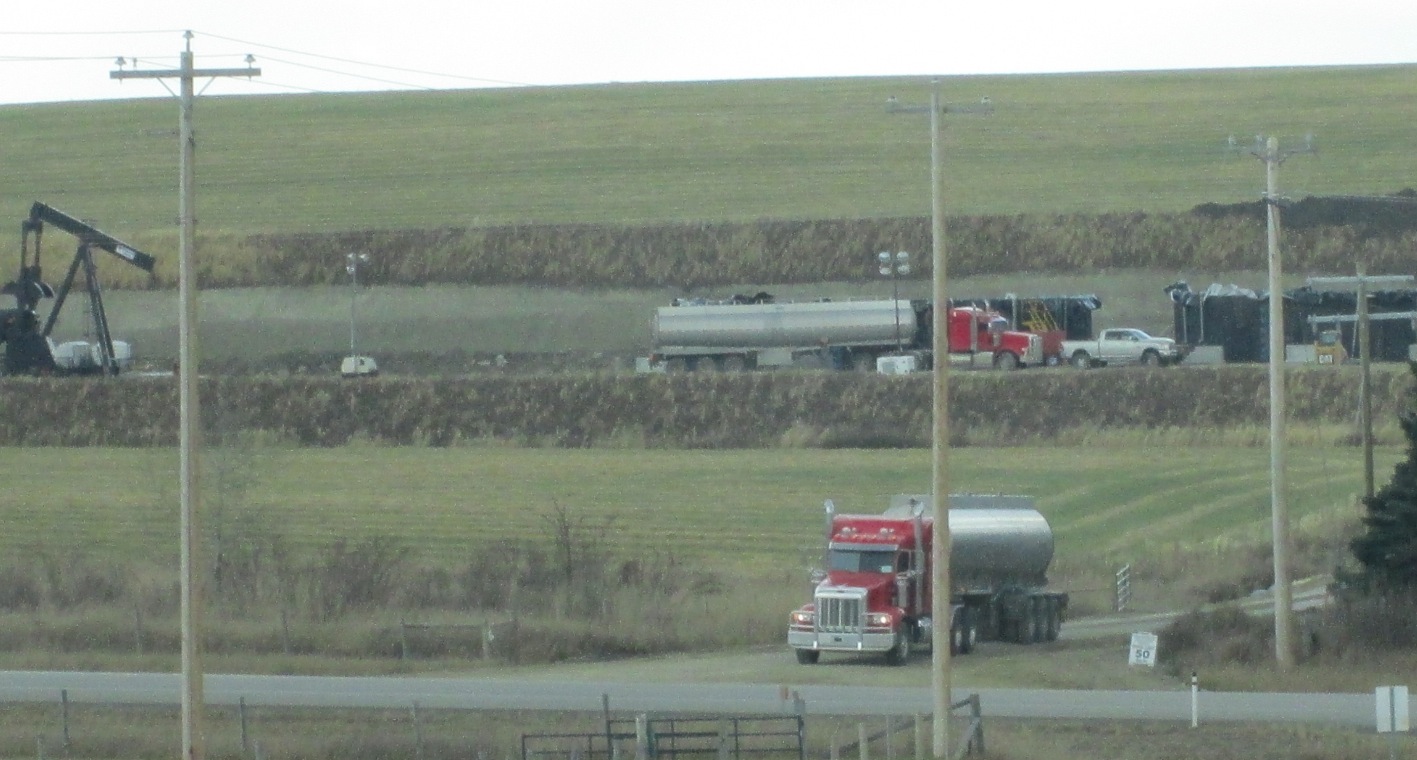
Town Should Take Steps to Fix Water Management Policy
'We are out of balance and our priorities, policies and practices for water management and use are unsustainable'
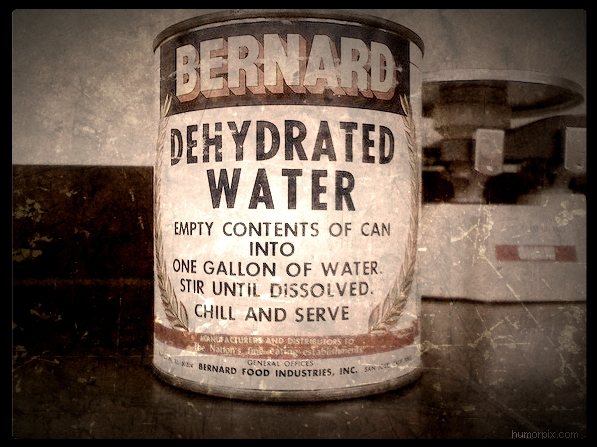 … Our regional water management system is out of balance in epic proportions with respect to promoting the economic interests of a few entrepreneurs and their shareholders in the oil and gas industry over the social and environmental interests of people and non-human nature in the Cochrane area.
… Our regional water management system is out of balance in epic proportions with respect to promoting the economic interests of a few entrepreneurs and their shareholders in the oil and gas industry over the social and environmental interests of people and non-human nature in the Cochrane area.Dogpound Creek, Premier Trout Stream Loses Water To Fracking
What was really surprising, was that 37,000 cubic metres [37,000,000 litres] was allotted for the months of February and March, when the trout eggs from the previous spawning season were still incubating in the spawning habitats along the creek
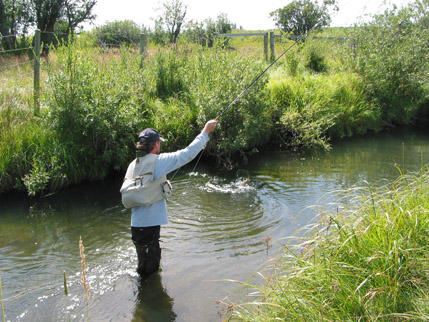 Feb 13, 2012 – 8,000 cubic metres
Feb 13, 2012 – 8,000 cubic metres- Mar 26, 2012 – 8,000 cubic metres
- Mar 26, 2012 – 3,500 cubic metres
- Mar 26, 2012 – 10,500 cubic metres
- Mar 26, 2012 – 7,000 cubic metres
- June 11, 2012 – 6,500 cubic metres
- July 18, 2012 – 3,500 cubic metres
- July 26, 2012 – 15,000 cubic metres
- Aug 1, 2012 – 7,000 cubic metres
Bow River Becomes A Lifeline For Frackers
Companies taking water from the Bow River for drilling and fracking
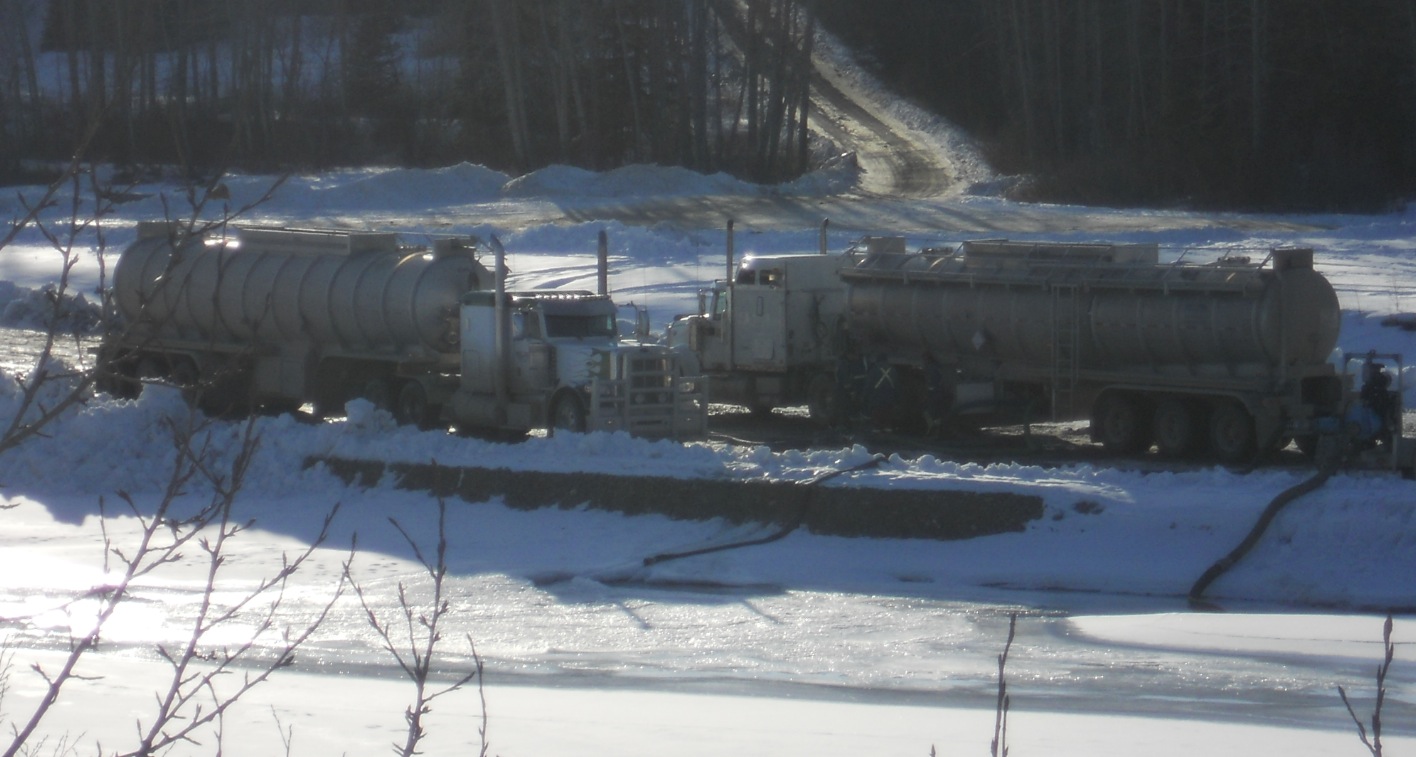
Bow River ... Red Deer River ... who's keeping track? Companies taking water from the Red Deer River for a frack job.
'Excess' Stormwater to be Pumped Out, Laced with Secret Chemicals, and Injected into Rocky View County's Future
'It's a win-win situation'
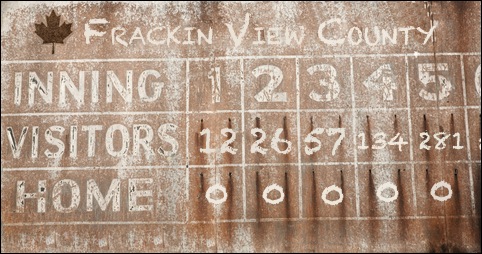 Areas in Rocky View drowning in excess stormwater will soon get some help from one company drilling for oil in the area.
Areas in Rocky View drowning in excess stormwater will soon get some help from one company drilling for oil in the area.The idea came from county Coun. Paul McLean.
'It’s a win-win situation,' he said.
Berg has been in meetings with other oil companies to see if the idea can be expanded and credits Mclean for his work.
NAL has been using locally sourced water since its operations started up in 2009, including water from Cochrane’s water treatment plant. ... more.
New Study Predicts Frack Fluids Can Migrate to Aquifers Within Years
Both scientists agreed that direct evidence of fluid migration is needed, but little sampling has been done to analyze where fracking fluids go after being injected underground.
Myers’ research focused exclusively on the Marcellus, but he said his findings may have broader relevance. Many regions where oil and gas is being drilled have more permeable underground environments than the one he analyzed, he said. ... more.
Reader Questions Hutchinson Drilling
What has our province come to?
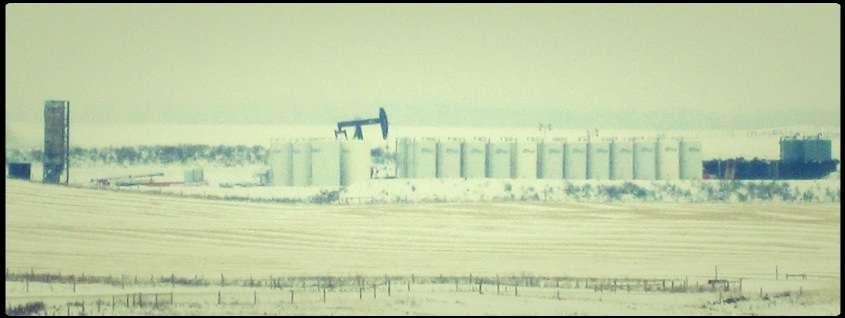
Cochranite Reminisces of Years Gone By
'I have a passion for planting trees. I planted 600 trees at the Oxyoke Ranch'
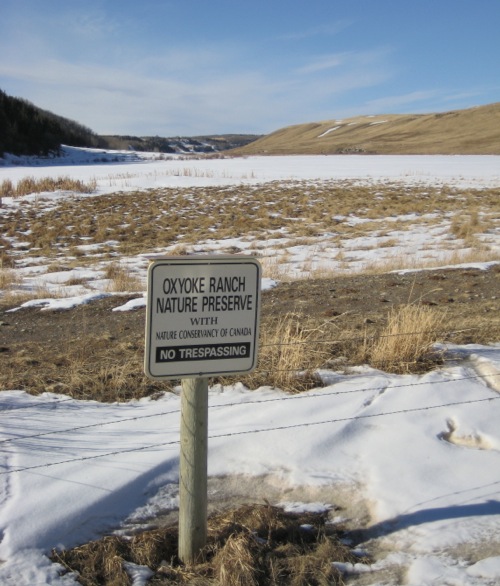 By Karla Reinhard, Cochrane Eagle, June 13, 2012
By Karla Reinhard, Cochrane Eagle, June 13, 2012Drilling Letter ‘Misleading’
These protocols provide strategies to reduce impact and avoid sensitive areas and all companies to date have worked with us to implement them.
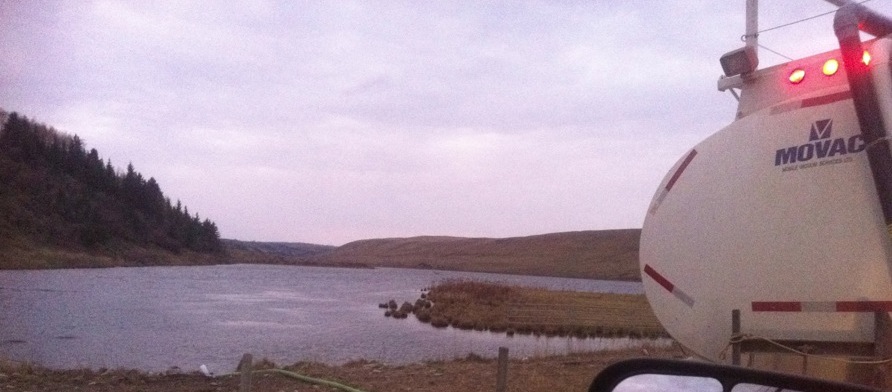
Given this, NCC chooses to work proactively to engage resource companies in our planning and conservation activities. To be clear, our preferred option is to redirect any development away from our properties — but that is not always a workable option. In cases where avoidance cannot be achieved, we have developed detailed protocols that encourage resource companies to follow responsible practices when they have the right to access property. These protocols provide strategies to reduce impact and avoid sensitive areas and all companies to date have worked with us to implement them.
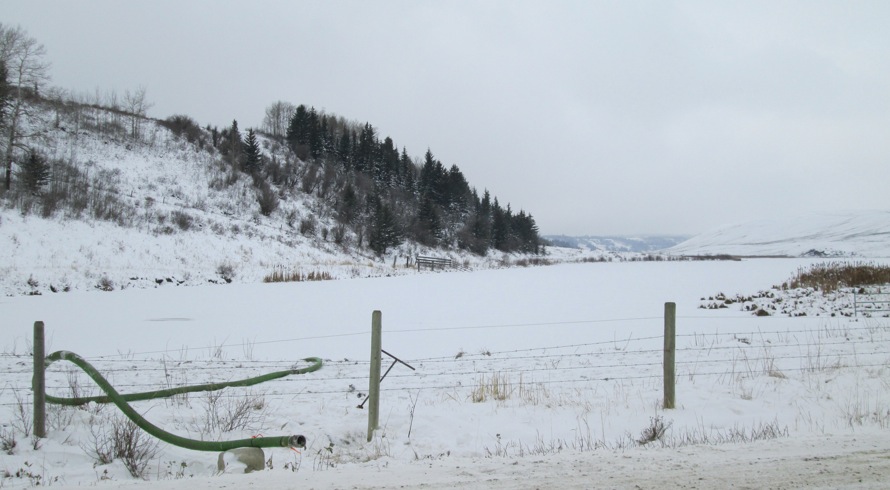
Here for the taking - a hose used by the oil companies to remove water from the Oxyoke Nature Preserve remains for the next tanker to hook up. Rocky View County, Alberta
Historic Land Deal Between Alberta Ranchers, Nature Conservancy Seeks To Keep The Wild In Wild Rose Country
There are currently no oil or gas wells, but gas drilling remains a possibility
By Kelly Cryderman, Sept. 11, 2013, The Globe and Mail
Against a cloudless blue sky, the grassy Alberta foothills of the Waldron Ranch seem limitless. A herd of cattle grazes on a distant plain that ranchers say looks the same as it did a century ago, without a single road or building in sight.
To preserve this view for generations to come, a co-operative of 72 ranchers has struck a deal with the Nature Conservancy of Canada to protect 12,357 hectares of postcard-perfect ranchlands under a conservation easement. The $75-million piece of private property about 175 kilometres southwest of Calgary will be the largest parcel of land in Canada ever covered under a land easement agreement, the deal’s backers say.
... “I’m going to be honest – we don’t really want [the easement], 100 per cent,” rancher Tim Nelson said of giving up some control over the land. “But we want it to preserve the land. . . . We don’t know about the next generation. And we’re worried. What happens in 20, 30, 40, 50 years, and they start developing it?”
... “What makes this place special is it’s such a vast expanse of grass that is pretty much undisturbed,” said Mike Roberts, manager of Waldron, where more than 10,000 cattle graze every year.
... No one is calling the land pristine. The Cowboy Trail intersects the ranch, a power line crosses a small part of it and a natural-gas pipeline runs underground. There are currently no oil or gas wells, but gas drilling remains a possibility – most Alberta landowners do not have the final say on what happens on their property beneath the surface.
However, the huge expanse remains ecologically and historically significant. Wild animals, including bears and cougars, use it as part of their range, and the land represents one of Alberta’s last intact blocks of nutrition-dense rough fescue grass – which cattle, elk and deer need for year-round sustenance. Dozens of teepee rings left by Blackfoot travellers are still in the ground near the Oldman River, and every year during the spring melt, several buffalo skulls are found – remnants of a time when vast herds wintered in the area.
Mr. Simpson said the road from Longview, Alta., a village closer to Calgary, south to the ranch is one of the most beautiful drives in Canada.
“If this was all carved up some day, wouldn’t that be a loss – not just for Alberta, but for the whole country?” ... more.
Nature Conservancy Sells 69,000 Acres in Adirondacks to New York State
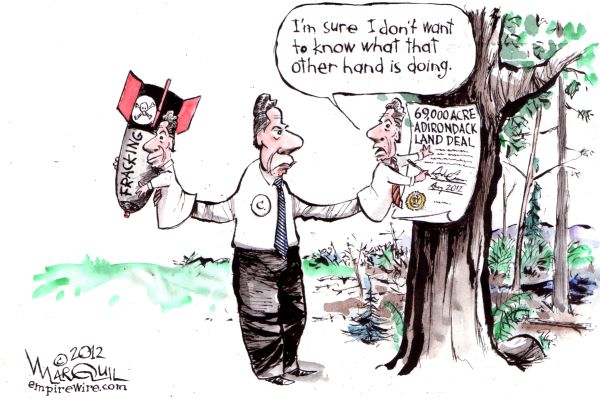 Long Island Newsday - An editorial cartoon by Mark Wilson about Andrew Cuomo's policy on fracking in the Adirondacks. Mark Wilson is a New York political cartoonist and illustrator who lives in the Adirondacks. He publishes under the pen name Marquil.By The Associated Press, August 5, 2012, The New York Times
Long Island Newsday - An editorial cartoon by Mark Wilson about Andrew Cuomo's policy on fracking in the Adirondacks. Mark Wilson is a New York political cartoonist and illustrator who lives in the Adirondacks. He publishes under the pen name Marquil.By The Associated Press, August 5, 2012, The New York TimesDollars, Politics Force Officials to Ignore Alberta Wetlands: Study
Alberta Environment routinely and increasingly disregards its own guidelines on protecting and conserving wetlands
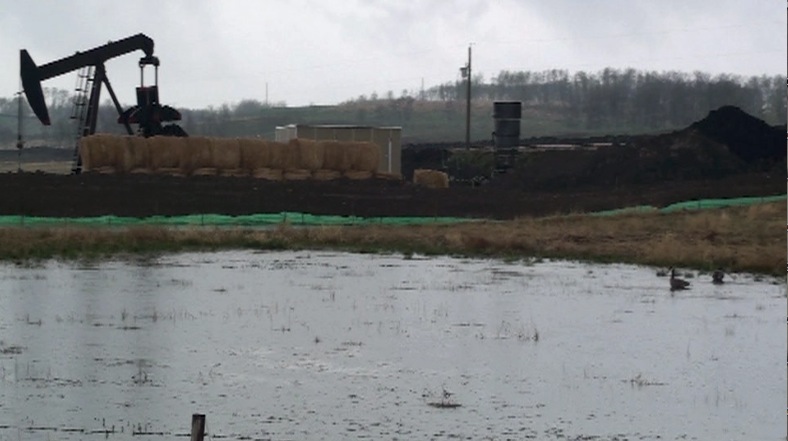
Equal Energy Sells Cardium Assets
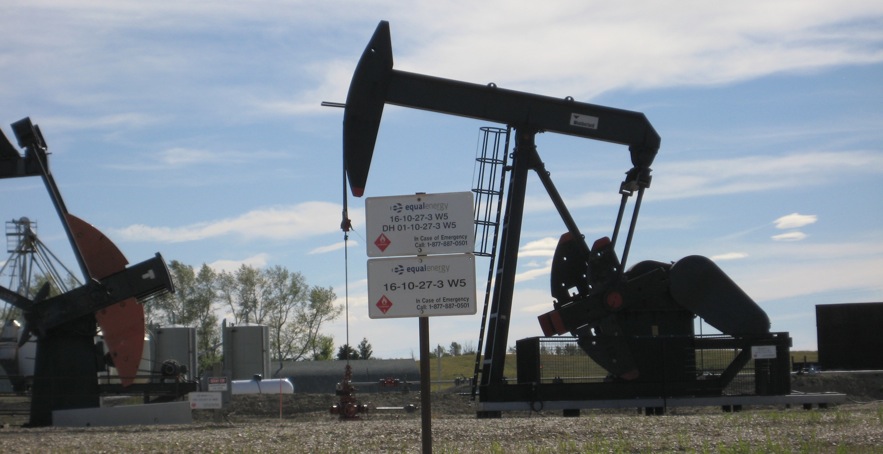
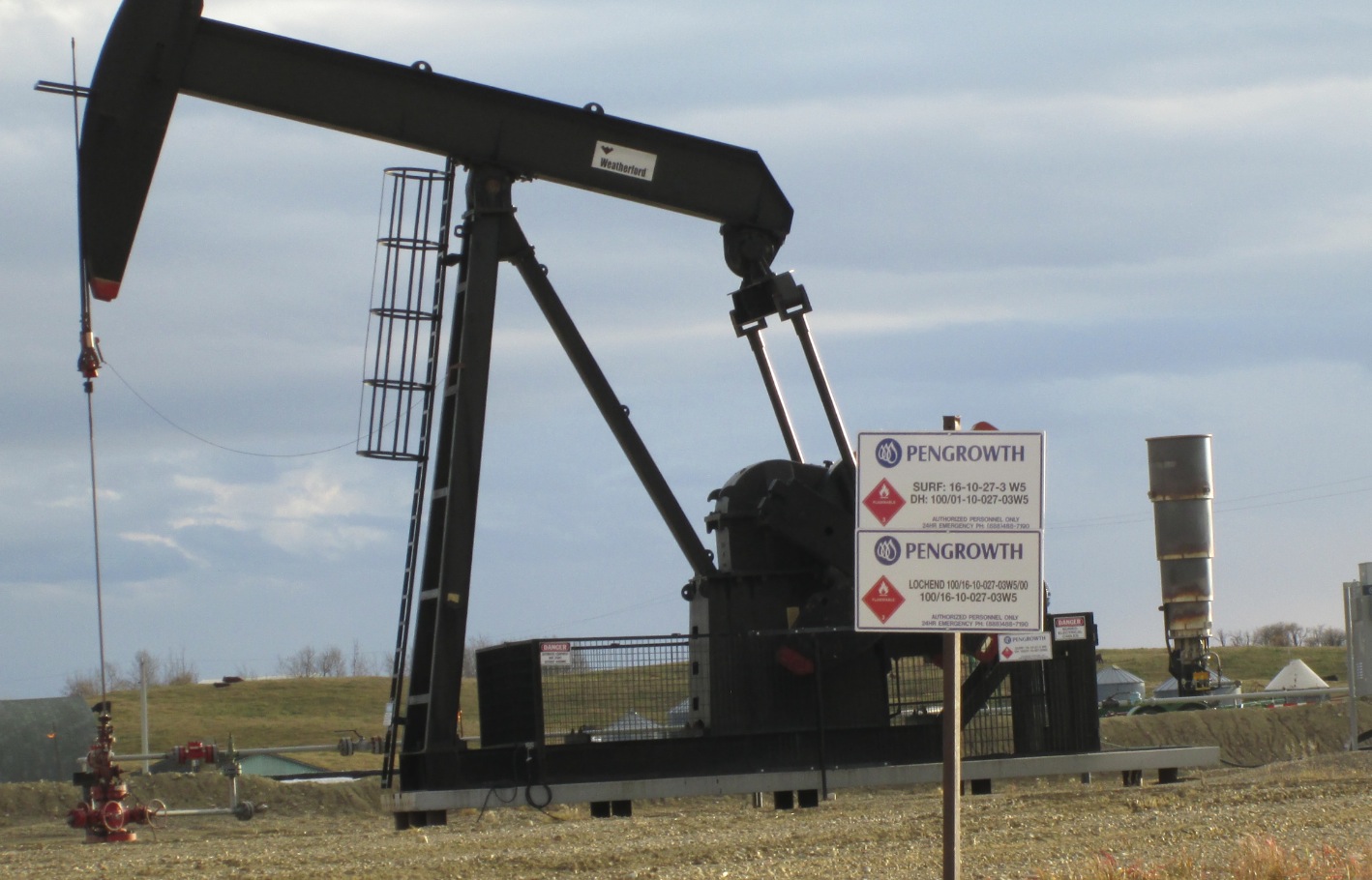
The Big Boys Can Sit Back And Rake It In
... The company owns more than three million hectares of "fee lands," on which it holds subsurface rights. In those areas, which were originally granted to the Canadian Pacific Railway in the late 1800s, Encana pays no royalty to the Crown. Instead, it can charge royalties to other companies ...
Encana has agreed to allow other companies to explore some of its lands in exchange for a royalty of anywhere between 30 and 38 per cent.
... "They'd have to do a lot of drilling on that many sections to hold it all - and we encourage it because we make good royalties," Mr. Knull said.
Encana also benefits by having someone else shoulder all the risk for finding oil. If it likes what it sees, it can then make a decision to drill for oil itself - an option it is open to, Mr. Knull said. "We're definitely interested to see where this goes." ... more
"Shale oil wells reach peak output almost immediately but quickly decline, so new wells are constantly needed."
He noted that the Bakken-Three Forks region in North Dakota required 90 new wells per month to maintain production of 770,000 barrels per day.
... Maugeri said the number of American shale oil wells in North Dakota and Texas could soar from the current 10,000 to more than 100,000 working wells by 2030.
... A key distinction between shale oil production and conventional oil wells is the intensity of drilling required to extract shale oil. Maugeri said this drilling intensity required for shale oil will limit production in densely populated areas, especially in Europe. He noted that the Bakken-Three Forks region in North Dakota required 90 new wells per month to maintain production of 770,000 barrels per day. ... more.
"It's The Last Gasp"
... this incessant need to drill is known as the Red Queen, after the character in Through the Looking-Glass who tells Alice, “It takes all the running you can do, to keep in the same place."
U.S. Shale-Oil Boom May Not Last as Fracking Wells Lack Staying Power
By Asjylyn Loder, October 10, 2013, Bloomberg Business Week
Chesapeake Energy’s (CHK) Serenity 1-3H well near Oklahoma City came in as a gusher in 2009, pumping more than 1,200 barrels of oil a day and kicking off a rush to drill that extended into Kansas. Now the well produces less than 100 barrels a day, state records show. Serenity’s swift decline sheds light on a dirty secret of the oil boom: It may not last. Shale wells start strong and fade fast, and producers are drilling at a breakneck pace to hold output steady. In the fields, this incessant need to drill is known as the Red Queen, after the character in Through the Looking-Glass who tells Alice, “It takes all the running you can do, to keep in the same place.”
... Whether current production can hold up is the subject of debate. David Hughes, a geoscientist and president of Global Sustainability Research, has examined the life span of shale wells. “The Red Queen syndrome just gets worse and worse and worse,” he says. “The higher production goes, the more wells you need to offset the decline.”
... In North Dakota’s Bakken shale, a well formally known as Robert Heuer 1-17R put out 2,358 barrels in May 2004, when it went live. The output proved there was money to be made drilling in the Bakken and kicked off an oil rush in North Dakota. Continental Resources (CLR), the well’s operator, built a monument to it. Production declined 69 percent in the first year. “I look at shale as more of a retirement party than a revolution,” says Art Berman, a petroleum geologist who spent 20 years with what was then Amoco and now runs his own firm, Labyrinth Consulting Services, in Sugar Land, Tex. “It’s the last gasp.”
... Global Sustainability’s Hughes estimates the U.S. needs to drill 6,000 new wells per year at a cost of $35 billion to maintain current production. His research also shows that the newest wells aren’t as productive as those drilled in the first years of the boom, a sign that oil companies have already tapped the best spots, making it that much harder to keep breaking records.
... The cost of drilling a horizontal shale well ranges from $3.5 million in the Mississippi lime to $9 million or more in the Bakken. That’s far more than the cost of a similar vertical well, which goes from $400,000 to $600,000, according to Drillinginfo.
In September, Steve Slawson, vice president for Slawson Exploration, sat in a trailer about 35 miles north of Oklahoma City, watching monitors as his crew shattered the Mississippi lime thousands of feet below. The well, known as Begonia 1-30H, will cost about $3.7 million.
One-third of that is the cost of fracking: First, thin pipes loaded with explosives are threaded into the hole to blast the ancient reef. Then, at a cost of about $80,000, the Begonia will consume 50,000 gallons of hydrochloric acid to dissolve the limestone; another $68,000 will pay for 1,000 gallons of antibacterial solution to kill microorganisms that chew up the pipes; $110,000 goes for a soapy surfactant to reduce friction; $10,000 covers a scale inhibitor to prevent lime buildup; and $230,000 purchases 2 million pounds of sand to prop the fractures open so the oil and gas can flow into the well.
Then there’s $300,000 in pumping charges, plus the cost of equipment rental, pipe, and water, which brings the price tag for fracking the well to $1.2 million.
A host of other things, from cement to Porta Potty rentals, accounts for the rest of the cost.
... Companies that borrow heavily to pay for drilling will be hit especially hard if prices decline. Since natural gas prices started falling, Chesapeake has been forced to sell off assets to pay for drilling. It’s also started cutting jobs. Chesapeake would not comment for this story. ... more.
In Cochrane, Area Landowners Have Reported Broken Windows and Cracked Foundations After Extensive Fracking Operations for Shale Oil
'We [ERCB] don't have any correlation between hydraulic fracturing and clusters of earthquakes you can feel.'
By Andrew Nikiforuk, 23 Feb 2012, TheTyee.ca
... Hill said that there had been reports of earthquakes associated with hydraulic fracturing near Cochrane, Alberta but no definitive correlation.
"We don't have any correlation between hydraulic fracturing and clusters of earthquakes you can feel." In Cochrane, area landowners have reported broken windows and cracked foundations after extensive fracking operations for shale oil.
Hill said there are approximately 100 fluid injection wells that pump fracking waste water from oil and gas site two miles into the earth. These facilities have been associated with strong earthquake activity in British Columbia, Ohio, Arkansas and Texas. But not in Alberta, said Hill.
... Despite a major increase in horizontal multi-stage fracking in oil shale formations (some 3,300 wells since 2008), the province has not allotted more money for earthquake, groundwater, gas migration or wellbore integrity monitoring. (The Alberta Geological Survey recently beefed up seismic monitoring after dozens of earthquakes a decade in the province turned into hundreds after 1985.)
"Nothing specific" has been set aside for additional monitoring admitted Hill. ... more.
CAPP Trots Out Voluntary Guidelines For Members Following Media Coverage Of 272 B.C. Fracking Earthquakes In A 2 Year Span and Numerous Fracking Earthquake Complaints From Cochrane Area Landowners Since 2011
Alberta's Energy Minister Ken Hughes isn't too concerned the guidelines were written by industry.
"While they've developed guidelines, clearly the Energy Resources Conservation Board is the ultimate authority and the new energy regulator will be looking at this”
Cochrane Resident Worries New Fracking Guidelines Too Weak
CBC News Posted: Nov 30, 2012
A Calgary-area rancher says Canada's oil and gas producers' new guidelines for hydraulic fracking don't go far enough.
The rules — which are voluntary — are supposed to address the risk of earthquakes.
On his ranch near Cochrane, Howard Hawkwood said he’s experienced many tremors on his property.
Hawkwood said they started after oil and gas companies started fracking not far from his property.
"I was in my horse barn, all of a sudden the horse barn started to tremble, I had a horse in there and he spooked," said Hawkwood.
This week, the industry unveiled voluntary guidelines for fracking and earthquakes. They call for procedures to be in place to monitor and mitigate seismic activity.
Alberta's Energy Minister Ken Hughes isn't too concerned the guidelines were written by industry.
"While they've developed guidelines, clearly the Energy Resources Conservation Board is the ultimate authority and the new energy regulator will be looking at this,” said Hughes.
For his part, Hawkwood says he’s disappointed.
"I'm really worried because they're going to write their own rules and that's it, they will just absolutely ignore the rest of us, they don't care, they're just after the almighty dollar,” he says.
Hawkwood expects the tremors will continue.
He's been told the number of wells in the area is set to triple to 150.
LIPG Strives to put Fracking Concerns to Bed
'There’s a lot of fear and hysteria that’s been created to a certain extent for really no reason'
By Derek Clouthier, February 29, 2012, Cochrane Eagle
... During a time that has seen a surge of drilling activity in the region, it is understandable that local residents could feel some apprehension and confusion toward the ever-increasing presence of oil and gas companies rolling into their backyards.
The majority of the incoming companies make up the Lochend Industry Producers Group (LIPG), which consists of five energy businesses; Equal Energy, NAL Resources, PetroBakken Energy, Tamarack Valley Energy and TriOil Resources.
On Feb. 24, four representatives from the LIPG and its affiliated companies made themselves available to address several concerns floating around in the public with regards to hydraulic fracturing, commonly known as ‘fracking.’
One of the main areas of distress stems from a fear that fresh water supplies are being put at risk by the chemicals found in the fluid that is being used for fracking operations – a fear they would like to put to bed.
... The actual chemicals used in frack fluid along with the air of secrecy that surrounds them has been paramount to the public criticism voiced thus far.
'There’s a lot of fear and hysteria that’s been created to a certain extent for really no reason,' said Berg.
The ERCB, Alberta’s regulating body for the oil and gas industry, is working to launch an initiative to disclose what chemicals are being used by all frack companies, and the LIPG is prepared to reveal that list when the time comes, which, according to NAL’s drilling and completions worker Clive Mountford, is expected to be by the end of the year.
'We will go through the disclosure process once the board gets it organized in terms of how to do it,' Berg indicated. 'The recipe itself is proprietary in terms of there are some advantages (and) competition between different frack companies in terms of what the recipe is, and that’s why people don’t want to disclose that to all their competitors, so there’s some element of competition involved in that.'
In order for a fracking operation to be carried out, certain chemicals, such as a jelling agent, must be used to thicken the water – guar beans being the most commonly used ingredient.
'It has ten times the thickening property of cornstarch,' said Trican’s VP of Marketing, Dave Browne. “That’s the primary thing we use in the frack fluid and at one time we had a few additives in there that we don’t need so we removed those.
'One of the common additives that we’ve removed in the last few years is either methanol or glycol that was used to stop the product from freezing. We’ve got heated chemical carriers now, so we’ve eliminated a lot of those chemicals.' ... more.
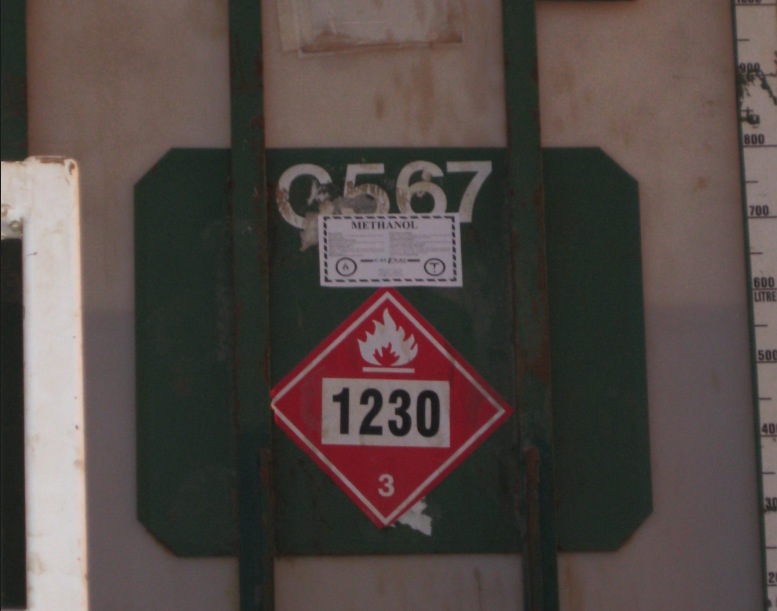
600 litres of methanol sits on a frack truck near Cochrane, Alberta - November 2011
Roads Concern Rocky View County Residents
Overall, roads are the top priority for just about everybody
By Derek Clouthier, September 26, 2012, Cochrane Eagle
The first phase of development for the Rocky View County (RVC) Plan is now complete, and the upkeep of the region’s roadways tops the priority list for most county residents.
'Overall, roads are the top priority for just about everybody,' said County Plan project manager Richard Barss.
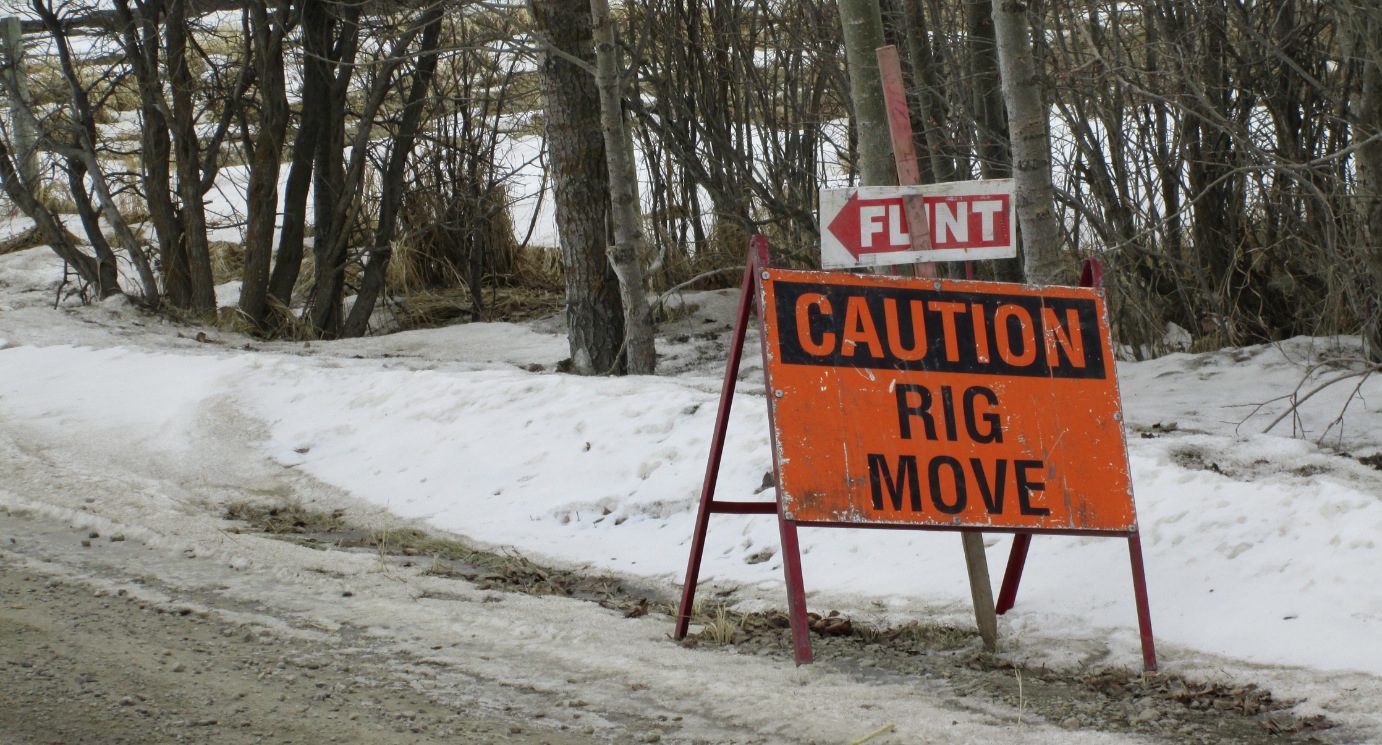 Rocky View County, Alberta
Rocky View County, Alberta
'But when you do break it down to some of these sub areas, some communities, like Bearspaw, fire protection ranked number one and roads came out number two.'
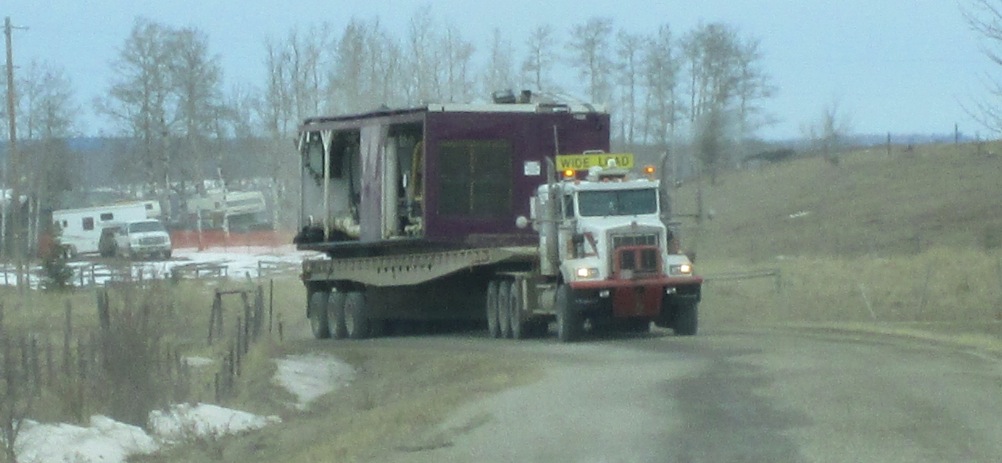 Rocky View County, Alberta
Rocky View County, Alberta
Barss said that although roads came out on top in the northwest quadrant where Cochrane is located, agriculture and food came in at a close second.
 Rocky View County, Alberta
Rocky View County, Alberta
'There are definite differences amongst our various communities and areas,' said Barss, 'so that also might help us when we write the County Plan.'
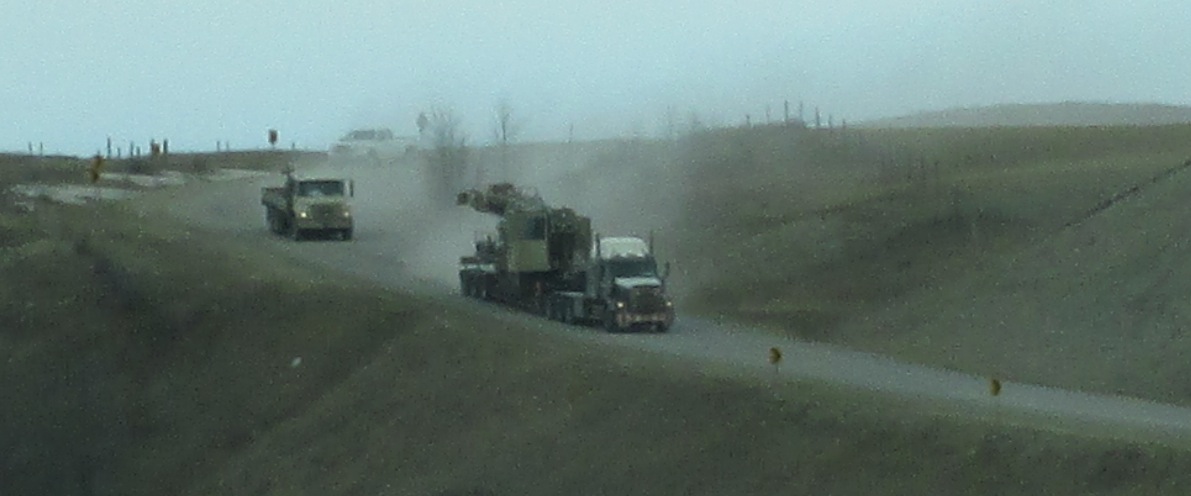 Rocky View County, Alberta
Rocky View County, Alberta
Phase one of the public engagement for the RVC Plan included a survey for county residents to fill out and, in total, 1,276 RVC residents partook. Fire protection and prevention came in second on the precedence list, followed by agriculture and food, sewage, stormwater and garbage and watershed management rounded out the top five.
'We’re really pleased with the response,' said Barss. 'It showed some cross the county trends, but it also brought out differences. The county is very big…so we would recognize there’re also different needs and different ways of thinking in the county.'
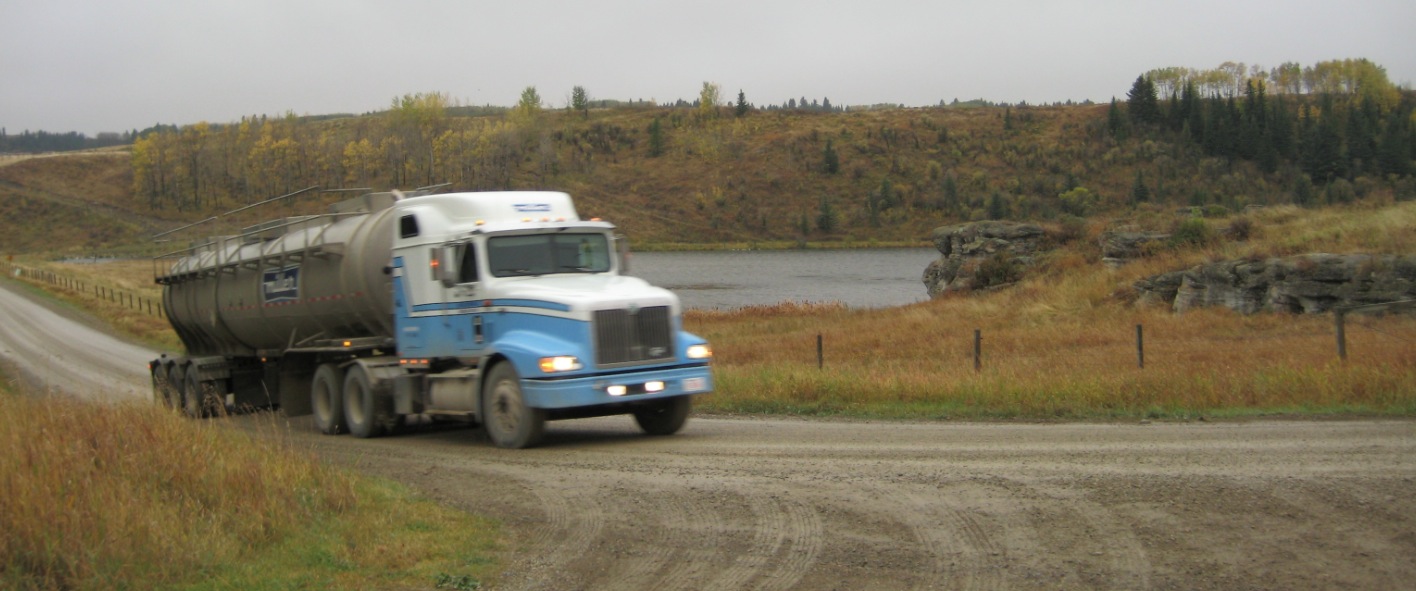 Rocky View County, Alberta
Rocky View County, Alberta
Barss said the county will model the new RVC Plan based on these differences to reflect the various needs depending on whether one lives in Langdon, Cochrane or in a more rural area of the county. The plan will determine a set of guidelines for the county over the next 10 years, prioritizing the various projects residents want to see completed during that timeframe.
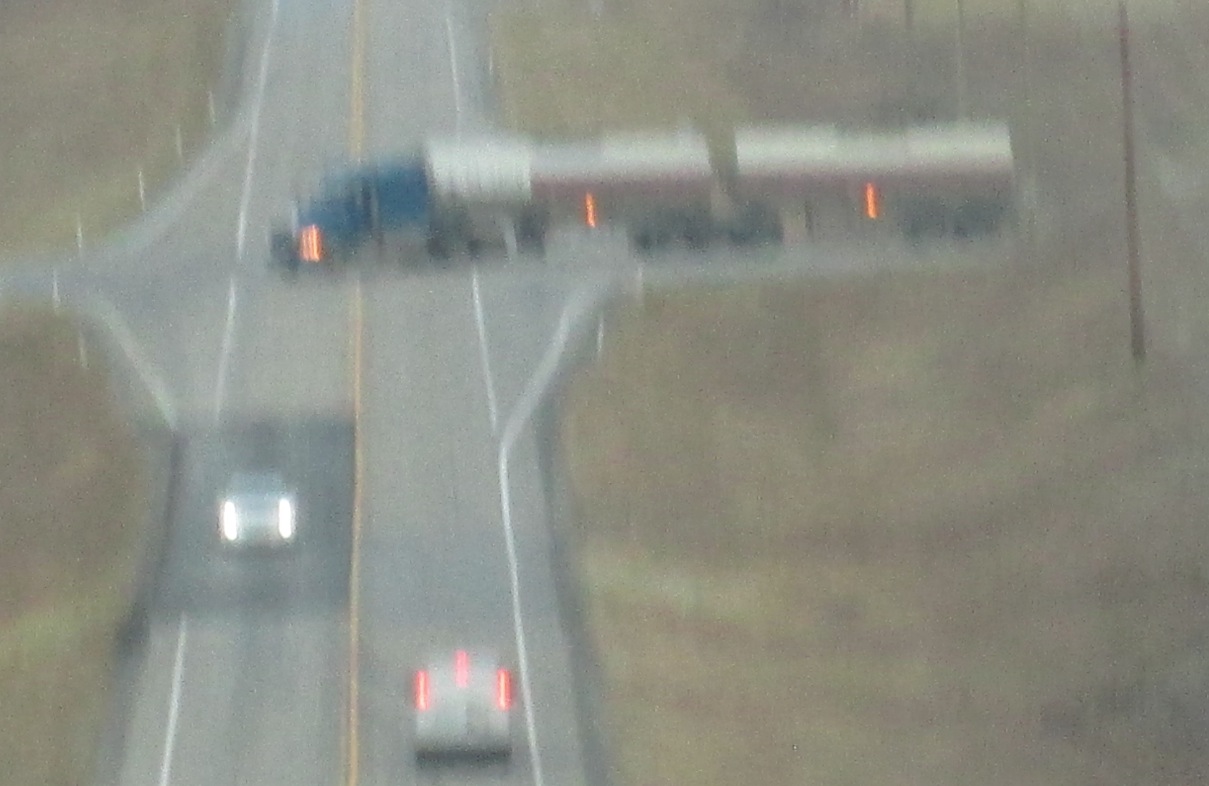 Rocky View County, Alberta
Rocky View County, Alberta
... The next step in the process of creating the RVC Plan is a series of workshops, seven in total, that will dig deeper into what county residents want to see happen over the next decade. ... more.
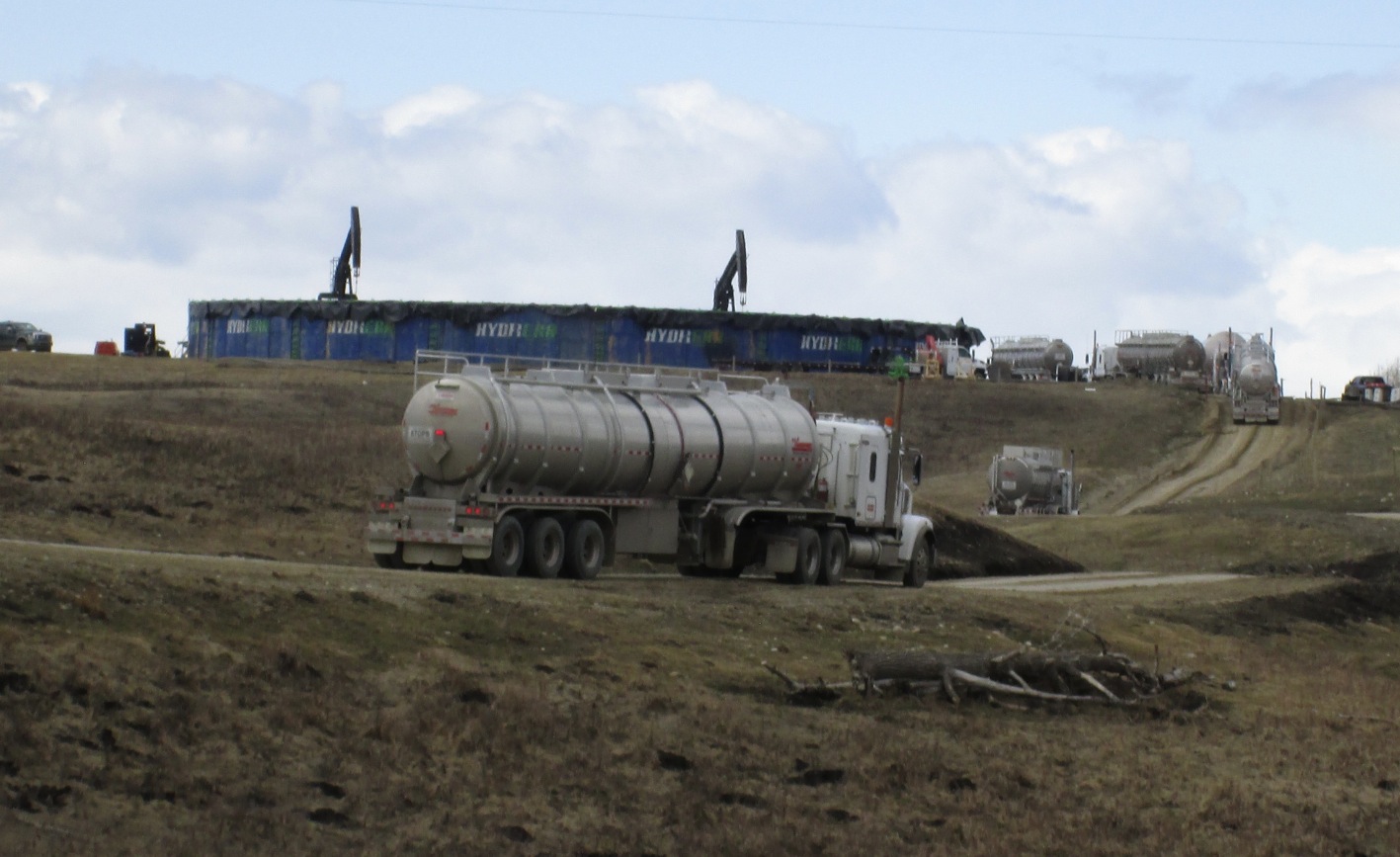
Tankers haul fresh water in preparation for another frac job on the multi-well frac sites near the community of Willow Way, Bearspaw, Rocky View County, Alberta. 2014
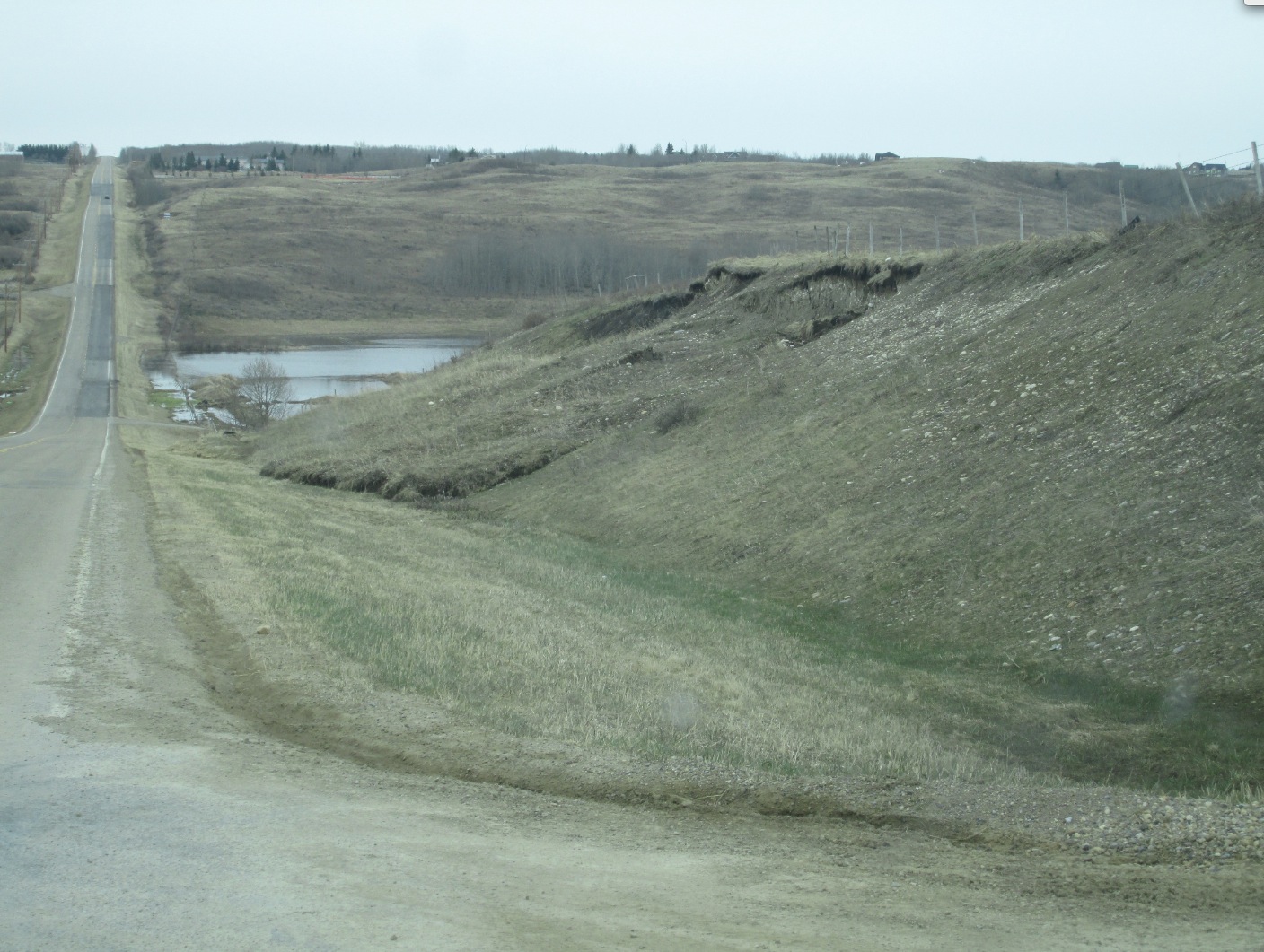
The local "landscaping" slumps near the lease road to the multi-well frac sites by the community of Willow Way, Bearspaw, Rocky View County, Alberta. 2014
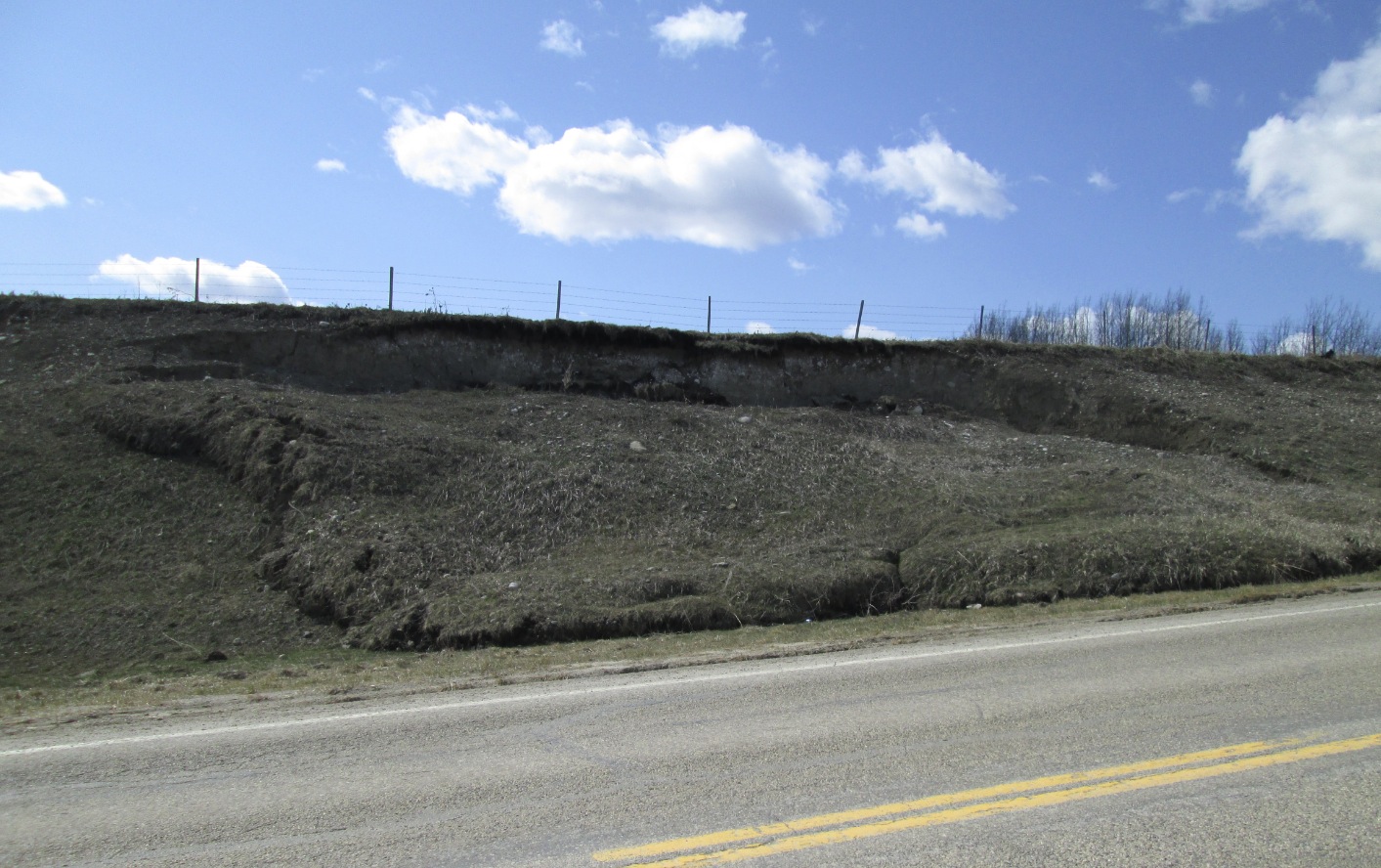
A different view of the slump near the lease road to the multi-well frac sites by the community of Willow Way, Bearspaw, Rocky View County, Alberta. 2014
CAUS Holds Second Meeting to Address Fracking
By Derek Clouthier, October 3, 2012, Cochrane Eagle
Road damage was also addressed during the meeting, particularly who pays for the repairs. Despite a previous assertion that an energy company has donated $500,000 to RVC for road repairs, CAUS said that after their own research, no such payment had ever been made. ... more.
Rocky View County Councillor Speaks Out On Recent Council Decisions
Other concerns raised in his announcement stated the transportation levy is too low and the reserve account can only pay to build six kilometres of road.
By Sylvia Cole, Nov 12, 2012, Rocky View Weekly
... When contacted, Sacuta said it’s important for him to put these ads out so people in the county knows what’s going on. He said the news stories don’t necessarily cover everything and he “owes it to the people” who elected him to get the information out.
This isn’t the first time Sacuta has placed an ad — he said he’s been doing it for quite some time and finds the feedback from residents in Rocky View County has generally been positive so he continues with it.
Other concerns raised in his announcement stated the transportation levy is too low and the reserve account can only pay to build six kilometres of road. ... more.
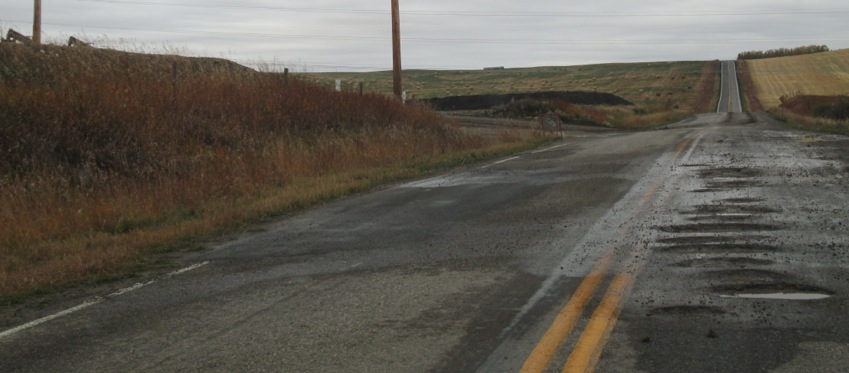
Road damage in front of Petrobakken's (Lightstream Resources) multi-well pad in Bearspaw. Twp Road 262 east of Bearspaw Road, Rocky View County, Alberta
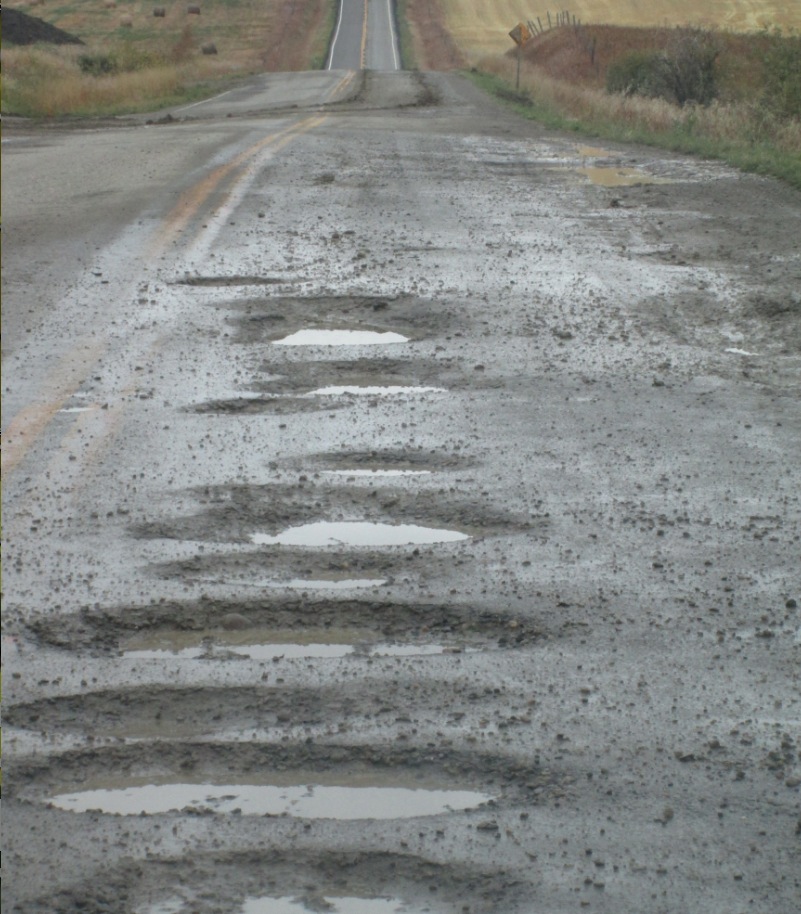
Road damage in front of Petrobakken's (Lightstream Resources) multi-well pad in Bearspaw. Twp Road 262 east of Bearspaw Road, Rocky View County, Alberta
Study: $7 Billion Bill for North Dakota Road Upkeep Over 20 Years
The study was limited to county and township roads, and did not include state-maintained highways, North Dakota's two interstates or the cost of maintaining bridges.
By DALE WETZEL, Associated Press – September 21, 2012
BISMARCK, N.D. (AP) — North Dakota's county and township roads, which have been pounded by truck traffic amid a flourishing state economy, will cost $7 billion to maintain over the next two decades, a new study estimates.
The survey, done by the Upper Great Plains Transportation Institute at North Dakota State University, says $834 million is needed during the next two years alone. About two-thirds of that should be used in western North Dakota's booming oil-producing region, the study says.
... It shows that legislators will have plenty of spending demands on the state's oil-driven budget surplus, which is expected to reach $1.6 billion by June.
In 2010, the institute did a similar survey of county and township road construction and repair needs. It recommended spending $654 million on road upkeep during the following two years, including $356 million for roads in North Dakota's oil region. Lawmakers responded by boosting spending on the state's road network.
Denver Tolliver, the transportation institute's director, attributed the 28 percent rise in recommended support for roads in the last two years to skyrocketing construction costs and an 80 percent increase in the number of oil wells that state regulators expect will be drilled in western North Dakota.
North Dakota had about 7,300 producing oil wells in July, according to the state Department of Mineral Resources. The agency has upped the number of wells it expects to be drilled in the next two decades from 21,000 to about 46,000, Tolliver said.
'There have been some very significant changes since we did the (earlier) studies,' Tolliver said.
The study was limited to county and township roads, and did not include state-maintained highways, North Dakota's two interstates or the cost of maintaining bridges. ... more.
Residents Want Testing Of Excessive Amounts Of Fluids Being Sprayed On Local Roads By Oil Companies
Thomas said he believes that at this point, Lightstream is lying to area residents about what is being put on the roads near the company’s 14-25 site, and that the black stuff being used came from the well.
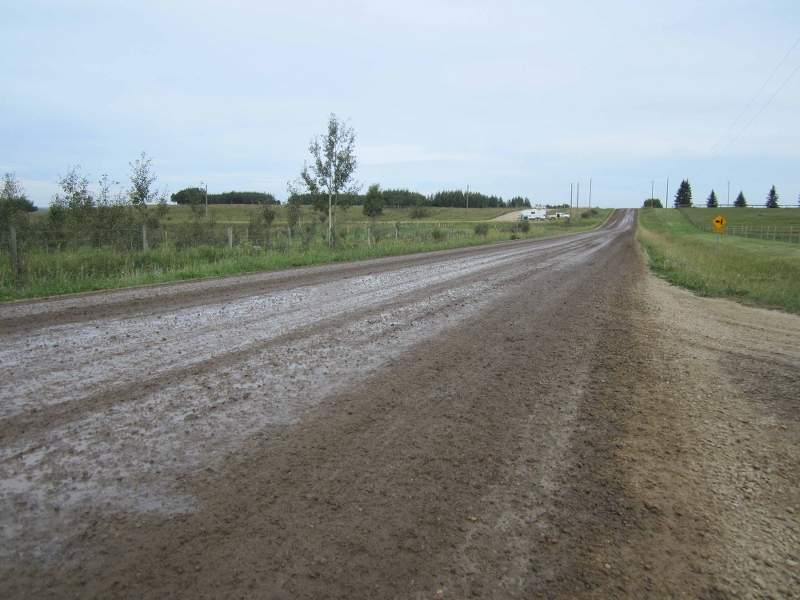
Oil companies spray a road in the Lochend area. Rocky View County, Alberta
Residents fret over fluid used for dust control
By Derek Clouthier, Sept. 05, 2013, Cochrane Eagle
A pair of residents who dwell north of Cochrane have voiced concern over how a section of road has been maintained by a Calgary energy company operating a hydraulic fracturing site in the area, more specifically, what is being used to treat the roadways.
Dan Thomas and Mike Ross have both expressed unease over what they have referred to as ‘very dark, brown or black-looking stuff’ being spread on Township Road 274 and Range Road 40 as a means of dust control.
Thomas, who is a member of the local coalition Cochrane Area Under Siege (CAUS), an organization that has voiced apprehension over the practice of ‘fracking’ in the region, said he approached one of the truck drivers last year who was spreading water on the road during a rainfall, and that the driver admitted that putting water on a gravel road while it was raining ‘did not make any sense,’ but that ‘they’ were making him do it.
Thomas said he did not know whom the driver meant by ‘they’, but that he later contacted Lightstream Resources (formerly PetroBakken Energy), the energy company operating in the area, to voice his displeasure over what he believed to be an abundance of water on the road, but to no avail.
Fast forward a year, and Thomas said not only has the dumping continued, but also he is now unsure what kind of substance is being put on the roads.
“It appears the haulers were trying to confuse the residents by dumping well fluids under the guise of water-based dust control,” Thomas claimed.
“It’s a heck of a mess out here,” echoed Ross, who owns an equestrian centre in the area. “The stuff coming out of the back of the truck is brown to black…it’s not just water.”
Chas Filipski of Lightstream said that his company uses calcium to control dust on the roads around site 14-25, which is near Township Road 274 and Range Road 40.
“This is an approved procedure by the Rocky View (County) Roads department,” said Filipski. “It is part of our mandate under our road-use agreement with (the county) that we keep the roads maintained as we work.”
Filipski said they use calcium as a stabilizer for dust control as a courtesy to the county and its residents.
“It works and lasts longer than water,” he said, “which we don’t want to waste, as it allows us to use less water.”
Filipski also pointed out that Lightstream does have a permit from the county to use the roads in question, and that they are inspected by the county to make sure they are being properly preserved.
Rocky View County (RVC) concurred, indicating that Lightstream does possess a permit, and that the county has inspected both the roads.
“The county does inspect the roads regularly to ensure compliance,” said Stacy McGuire, RVC communications coordinator, “and yes, we have inspected Township Road 274 and Range Road 40 and we have full compliance with the road-use agreement.”
McGuire also pointed out that to control dust, the county, and companies that sign the road-use agreement, use calcium chloride, which is like highly concentrated salt water.
“This is an environmentally friendly product,” said McGuire, adding that molasses is used as a ‘major ingredient.’
Thomas, however, believes that it is unlikely that molasses would be a primary ingredient in the liquid being used on the roads, and questions why the county or a company would use a product so high in salt content, as it would be quite corrosive on vehicles that utilize the road.
Thomas, who is a former energy sector employee, added that produced water from a well site would certainly be highly saline, but he questions whether using it on the roads is legal, saying it often has trace or significant amounts of hydrocarbon in it.
Hydrocarbon naturally occurs in crude oil and is an organic compound mixture of hydrogen and carbon.
Thomas said he believes that at this point, Lightstream is lying to area residents about what is being put on the roads near the company’s 14-25 site, and that the black stuff being used came from the well.
“These guys will do anything to look ‘green,’” said Thomas. “Ultimately, someone should test the material…that means the Alberta Sustainable Resource Development.” ... more.
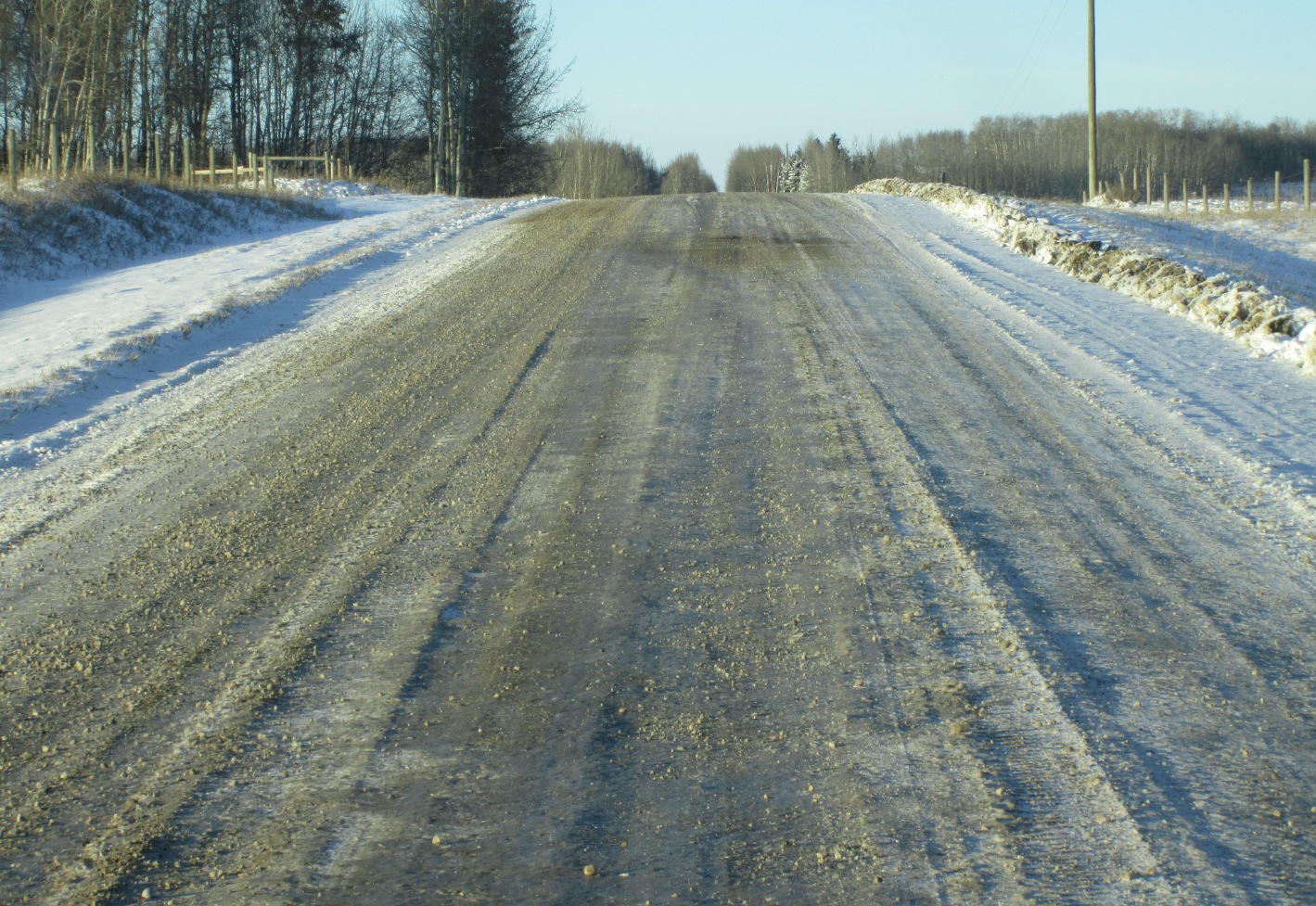
Do snow-packed gravel roads require "dust control?" This and photos below taken minutes apart. October 2013 - Lochend, Rocky View County, Alberta
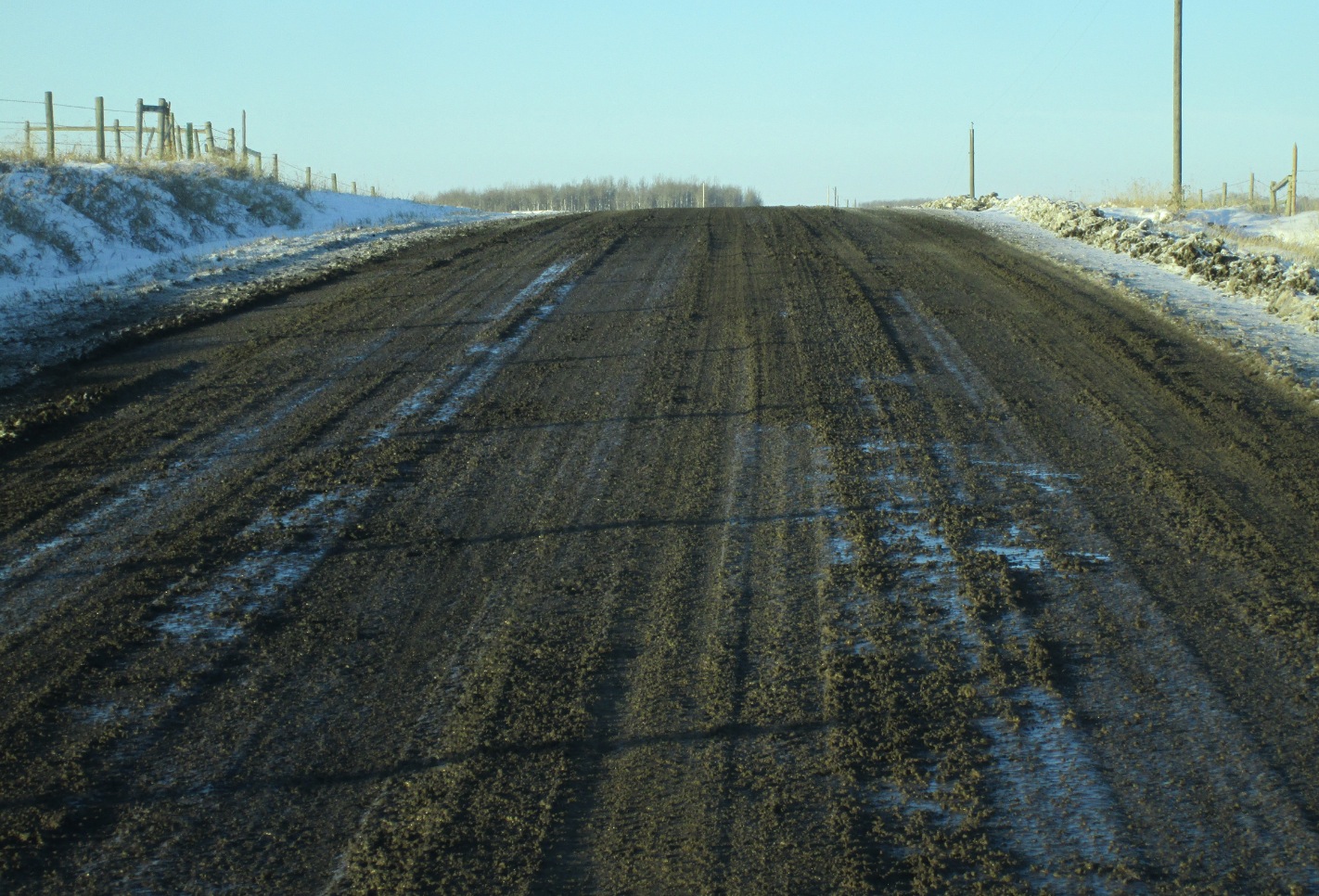
Someone seems to think so. This is the same road, closer to the fracked well sites.
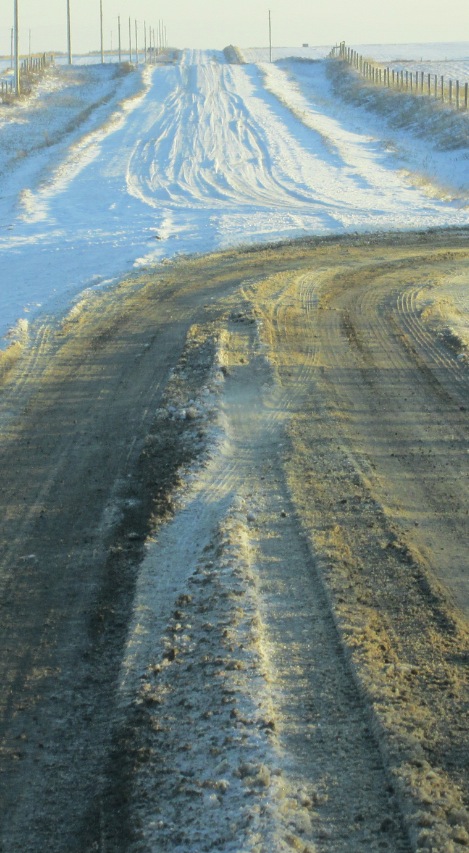
Which way did they go? Lochend, Rocky View County, Alberta
APPROVED: Encana's Frack Waste Spread On Roads In Michigan
The total was over 40,000 gallons.
By Ban Michigan Fracking, Jan. 14, 2013
... Documents and emails originally obtained last fall showed the state agency permitted spraying of flowback on roads early last summer for 30 days. The total was over 40,000 gallons.
"Newly-released documents now show the frack wastes were sprayed in a state forest between two horizontal frack wells in Kalkaska County. In Cheboygan County flowback was spread on roads abutting Paradise Lake, on camp roads at Mill Creek Campground, and in an industrial yard. They also show the spraying was permitted for 94 days, not just 30.
The source wells were drilled and fracked in 2011 by Encana Oil & Gas. They are three miles apart on Sunset Trail, in the Mackinaw State Forest in Kalkaska County.
Paul Brady lives near Sunset Trail, the most heavily frack-sprayed road. Last spring he noticed the heavy spraying of Sunset Trail between the two Excelsior Township frack wells and took photos.
'Discovering the wastewater that was dumped on Sunset Trail was disturbing,' Brady said. 'Sunset Trail is a popular road for all types of recreation including hunting, gathering morels, or just walking the dog. The North Branch of the Manistee River is also very close and is a huge part of what makes this area unique.'
... DEQ field operations chief Rick Henderson stated in an email that 954 barrels of flowback had been spread from two wells for 15 days starting on May 30.
BMF responded in September with a formal demand for more documentation about the incident through the Freedom of Information Act. BMF headlined the story on the group’s website: 'Michigan Frack Disaster – Over 40,000 gallons of frack fluids approved by Michigan DEQ for use on roads.'" ... more.
CAUS Holds Second Meeting to Address Fracking
"This is in our backyard,” said Tresidder, "and it’s not going to go away unless we say something."
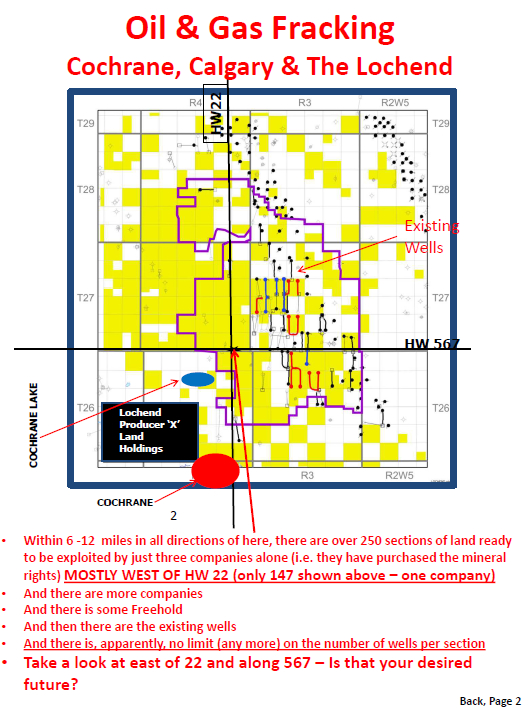
By Derek Clouthier, October 3, 2012, Cochrane Eagle
The local coalition Cochrane Area Under Siege (CAUS) held a second open house to address their concerns over hydraulic fracturing (fracking) in the Lochend area.
The meeting, which saw approximately 20 people attend, touched upon several issues CAUS believes poses a threat to residents of the Cochrane region.
One of such threats was the claim that oil and gas companies with fracking operations in the area – which primarily consists of the six Lochend Industry Producers Group (LIPG) companies – are not employing the use of incinerators to properly burn off excess gas.
Gary Tresidder, who spoke during the CAUS open house, alleged that the use of flare stacks were being used instead of incinerators, and that these flare stacks (which he also claimed utilized what is referred to as a ‘flare shield’ to mask the height of the flame that can be seen during burn off) do not reach a high enough heat to entirely dissipate excess gas.
'They’re very ineffective and inefficient,' said Tresidder, 'and do not burn off the chemicals.'
He added that when there is a northerly wind, all those unburned chemicals get swept directly into Cochrane.
'This is in our backyard,” said Tresidder, 'and it’s not going to go away unless we say something.'
The LIPG, on the other hand, contend that their companies are making every attempt to not only discontinue the use of flare stacks, which they say they ceased using a year ago, but to be as efficient as possible. ... more.
Residents Concerned About Fracking Rally In Cochrane
'A fellow drove by one of those flare shields — he came to me the next day he had a bubbling red rash.… He had boils on his forehead. One of my other neighbours had to shoot six cows that had rampant cancer'
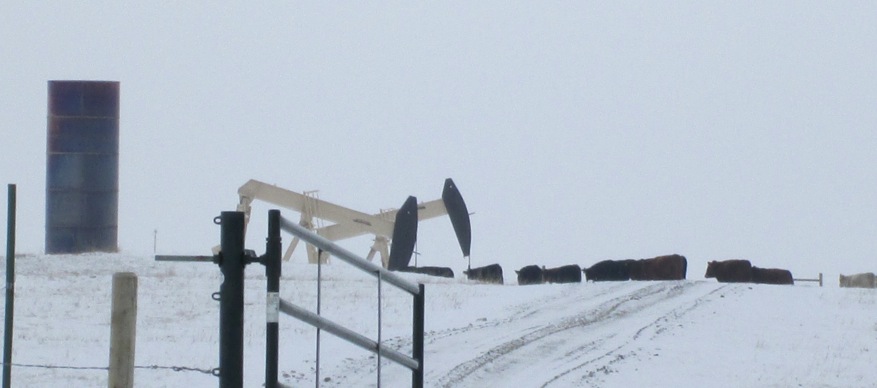
Another bovine well site inspection? Giant 'flare shield' on multi-well pad in the Lochend. Rocky View County, Alberta
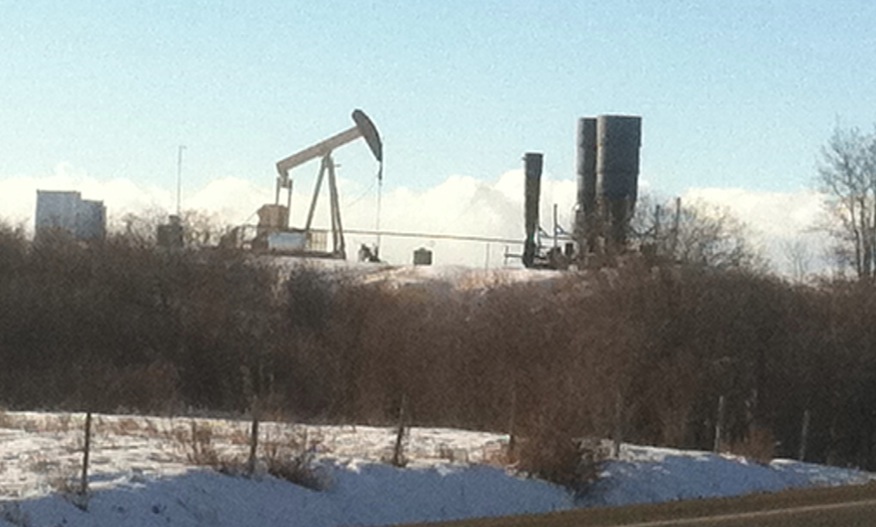 3 'flare shields' on a well pad. How many do they need for one well? Rocky View County, AlbertaCBC News Sep 15, 2012
3 'flare shields' on a well pad. How many do they need for one well? Rocky View County, AlbertaCBC News Sep 15, 2012
About 40 people living in and around the Cochrane area west of Calgary gathered Saturday to rally against fracking.
... Many people, including Karen Faulk, are concerned about air and groundwater contamination.
“When you start taking random stories, you start to see patterns and for me I ask why?” Faulk explained.
Her concerns are echoed by many who showed up to the rally including.
“A fellow drove by one of those flare shields — he came to me the next day he had a bubbling red rash.… He had boils on his forehead. One of my other neighbours had to shoot six cows that had rampant cancer,” said Gary Tresidder at the rally.
Local residents say people living near the wells are losing their hair and they worry cancer rates are higher in those areas. ... more.
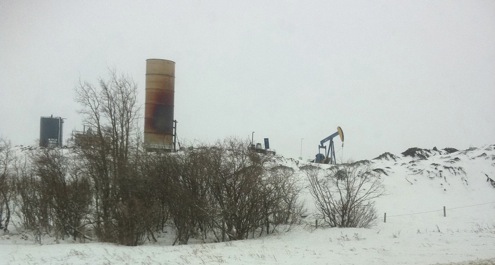
Blackened 'flare shield'. This one looks a little hot. Rocky View County, Alberta
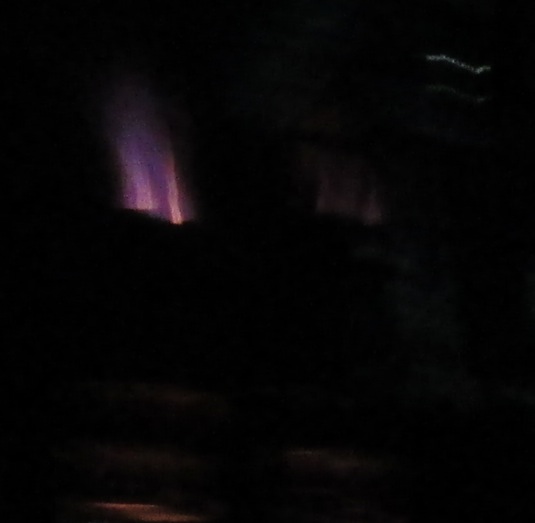
Interesting colours, what's cooking? Two 'flare shields" on a multi-well pad at night. Rocky View County, Alberta
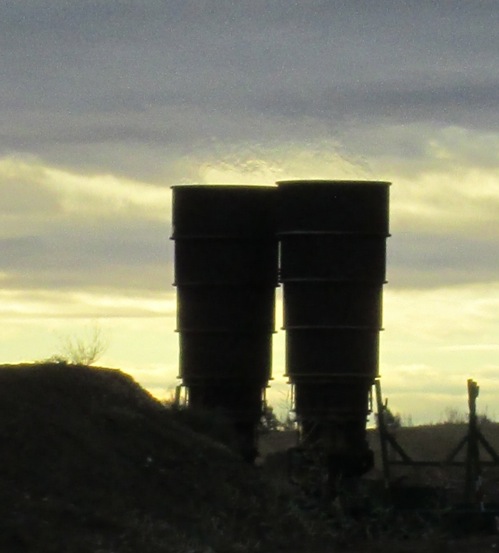
Two 'flare shields' on a multi-well pad in Bearspaw, Rocky View County, Alberta
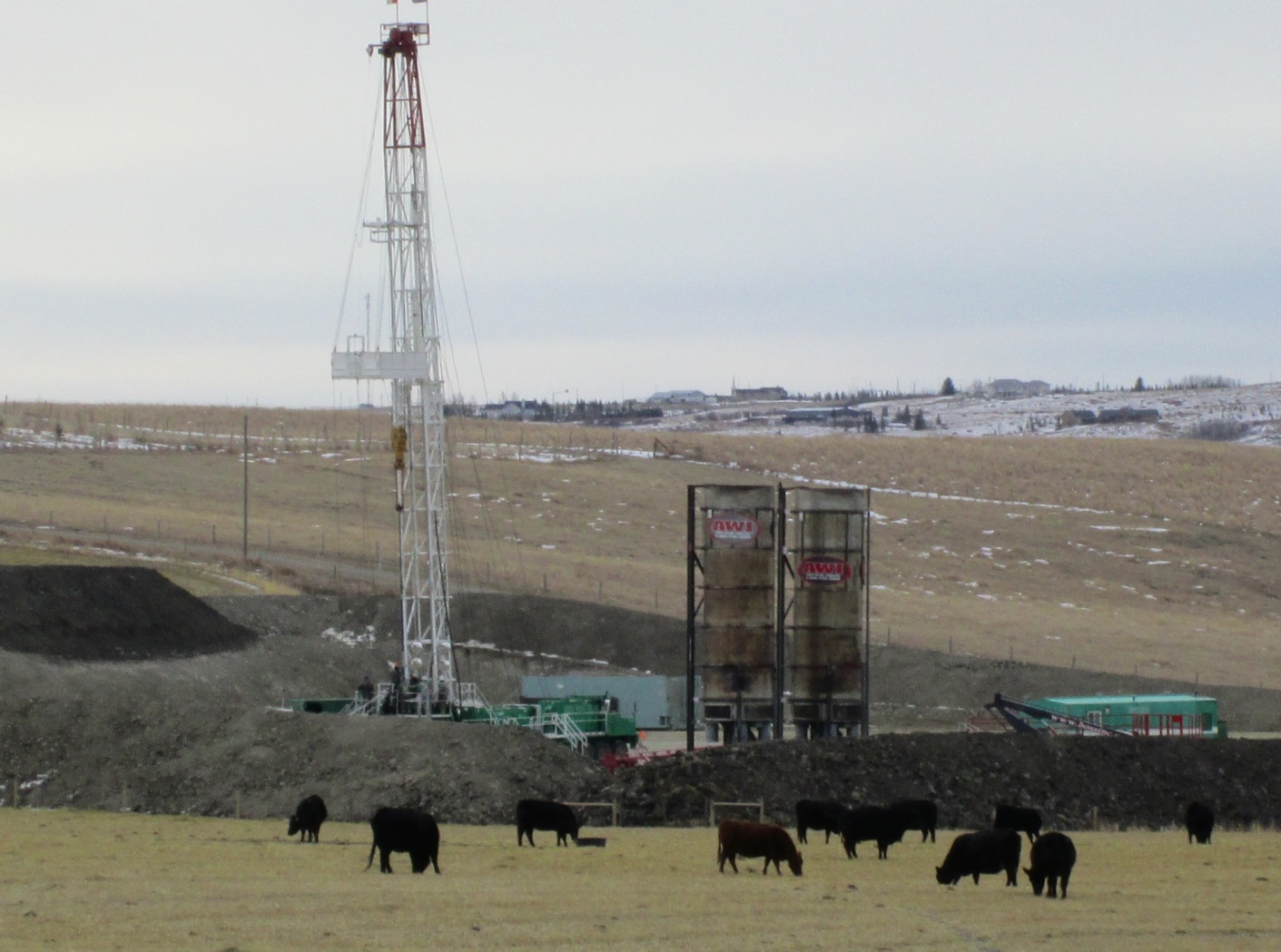
Two 'flare shields' sit on what is to become a multi-well pad after a frack job near the Town of Cochrane's new residential development of Sunset Ridge.
A chemical and radiation infused "windsock?" After a Lochend frack job, the wind appears to be coming from the north. Rocky View County, Alberta
In Situ Measurements Of Atmospheric Gamma Radiation In The Gas Flaring Environment Of The Ologbo Town, Nigeria
We recommend that flaring should not be done where human population is high or near residential areas because of the radon gas released.
By Onosohwo, B.U.; Mangset, E.W. and Khandaker, M.U., Malaysian Journal of Science 33 (1): 99-106 (2014)
ABSTRACT: The atmospheric gamma radiation level in gas flaring environment has gained the attention of researchers and environmentalists due to its devastating impact both on the climate and the environment. It is important to make a quantitative assessment of the gamma radiation in the gas flaring environment and nearby residential areas.
In situ measurements of the gamma radiation were performed using a nuclear radiation monitoring device: Digilert-50, Stop watch and a geographical positioning system. Data were collected from two different locations: Ologbo town and 40m away to the flaring site. Measured data showed that the mean equivalent dose rate at 40m away to the flaring site during flaring period was 1.02mSv/yr, and at Ologbo town was 1.04mSv/yr.
The obtained dose rate in the flaring site and Ologbo town area exceeded the International Atomic Energy Agency and International Commission on Radiological Protection recommended safety limit (>1mSv/yr.) for the general public.
This shows that the flaring activities have impacted the surrounding environment radiologically. This may pose long-term health side effects on the workers and residents of the host communities.
We recommend that flaring should not be done where human population is high or near residential areas because of the radon gas released.
... Furthermore, the radiation levels recorded for gas flare facilities and natural gas compressor stations are fairly higher than other facilities. This confirms the high concentration of radon gas and heavy metals normally associated with natural and associated gas.
This radon concentration of natural gas at these facilities in the region when compared to those obtained in other countries of the world such as USA, Great Britain and Canada, it may be seen that the facilities radiation levels in Nigeria is fairly smaller compared to those reported in USA and Canada where radon concentration (radiation levels) constitutes enormous environmental problems requiring government legislation for the control of NORM contamination in their petroleum industries. ... more.
Canaries In Coal Mines
Alberta Energy Regulator admits they don't know what's spewing from well sites - and they're not looking; "No, we do not have a totally accurate comprehensive information on the flare composition."
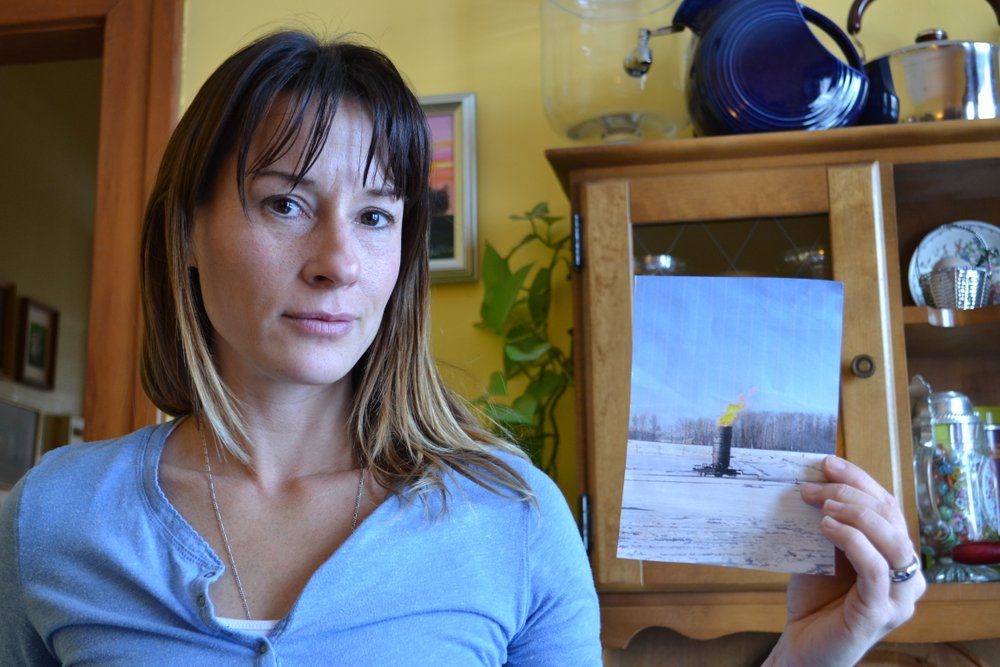 Diana DaunheimerDecember 14, 2014 by Green Planet Monitor
Diana DaunheimerDecember 14, 2014 by Green Planet Monitor
Bob Willard, Senior advisor at the Alberta Energy Regulator, agreed to speak about current regulations.
David Kattenburg: Why aren’t these things being monitored for in the gases that are coming out from flaring and incineration stacks?
Bob: The long list that you’ve identified would be the responsibility for monitoring of not only the Alberta Energy Regulator, but the Environment department themselves, and I would direct you once again to ESRD for them to identify what their plans are relative to updating those guidelines.
David: I have actually, I’ve tried valiantly I’d say, to try to get them to explain to me why they have these guidelines that say all industry MUST conform to these guidelines, and then I said: "well why does directive 60 of the Alberta Energy Regulator only establish monitoring requirements for sulfur dioxide?" and he said: “speak to the Alberta Energy Regulator.”
Bob: Um, it is important, and this is something the Energy Regulator does lead, is capturing the metrics of the volumes of material, so we do have good metrics as to the volumetrics.
David: But essentially nothing about the composition of those gases, other than sulfur dioxide.
Bob: A totally accurate composition, I would certainly volunteer that, no, we do not have a totally accurate comprehensive information on the flare composition, rather, we have it for the uh volumes, but not necessarily for the compositions. ... more.
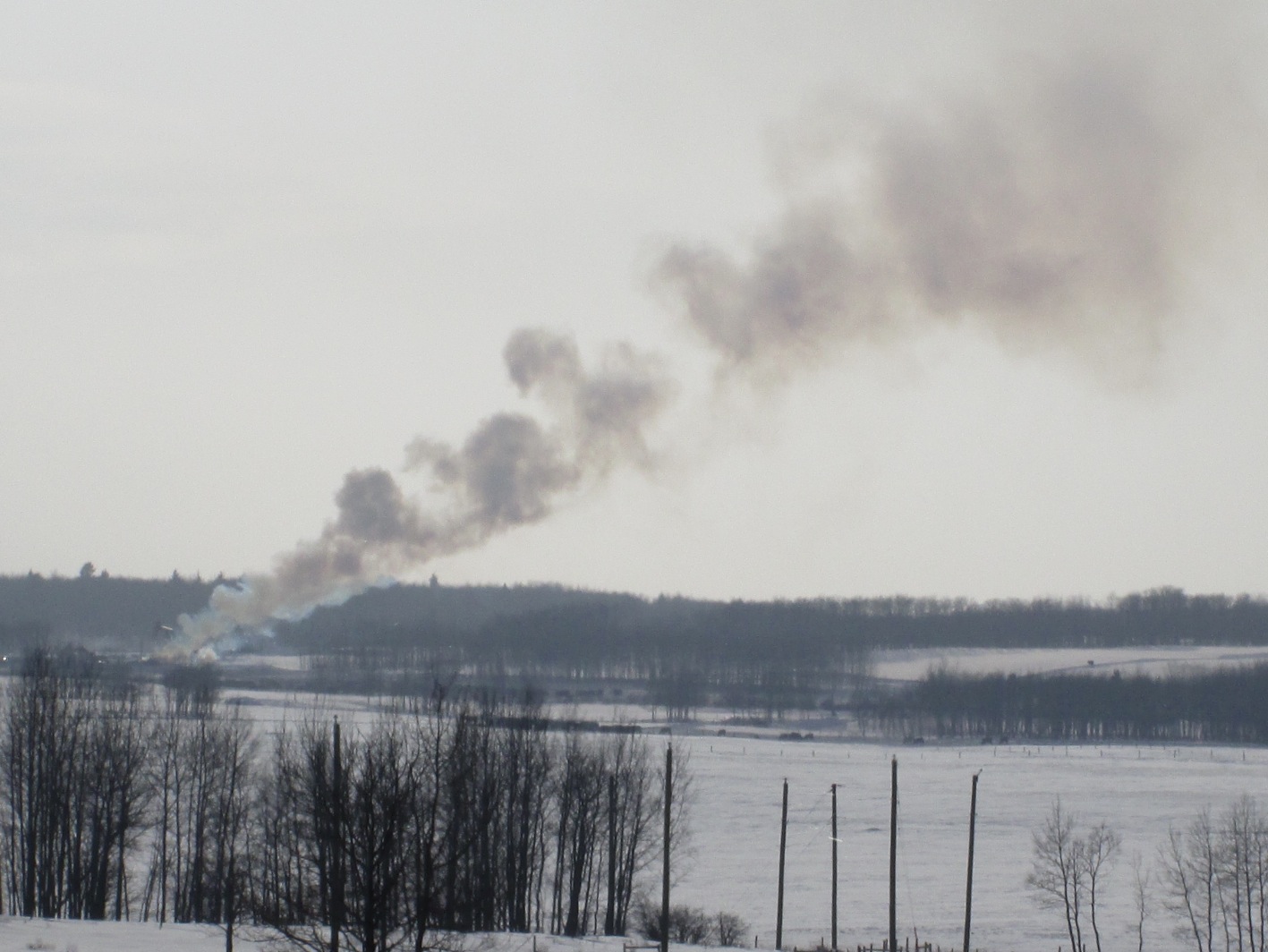
Lochend area, Rocky View County, Alberta. 2014
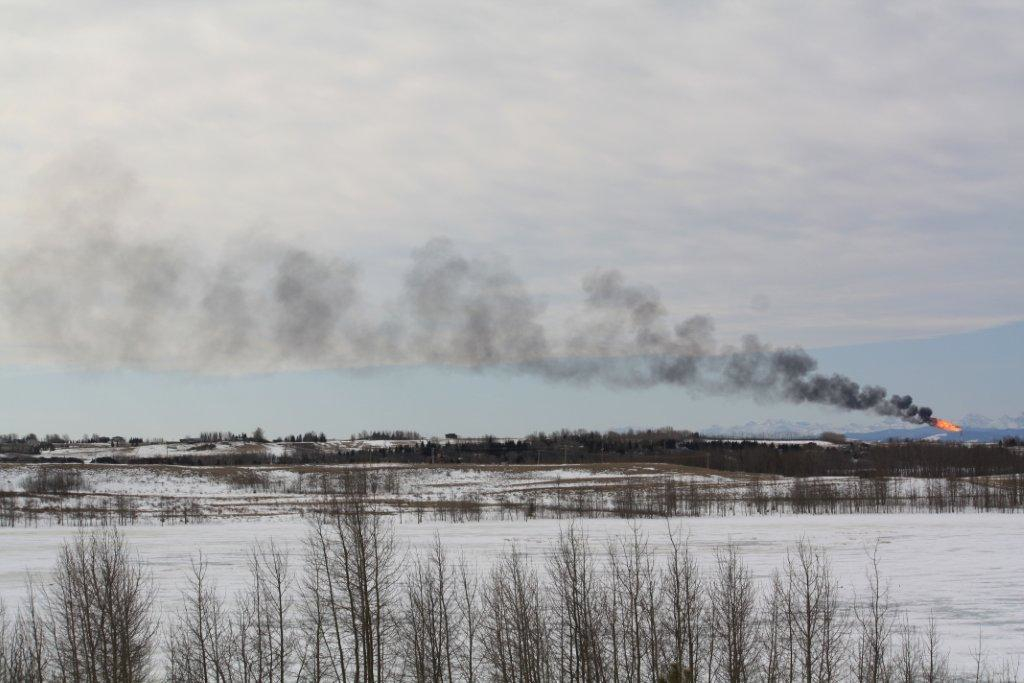
Onward, upward, and downward. A "cloud" floats over the Cochrane, Lochend, and Bearspaw areas from the Cochrane gas plant. 2014
Welcome To The New Dawn Of Deregulation: Off-Lease "Odours" For Everyone!
Of greatest concern is that off-lease odours are now permitted from energy sites. The previous document was clear; no off-lease odours were allowed.
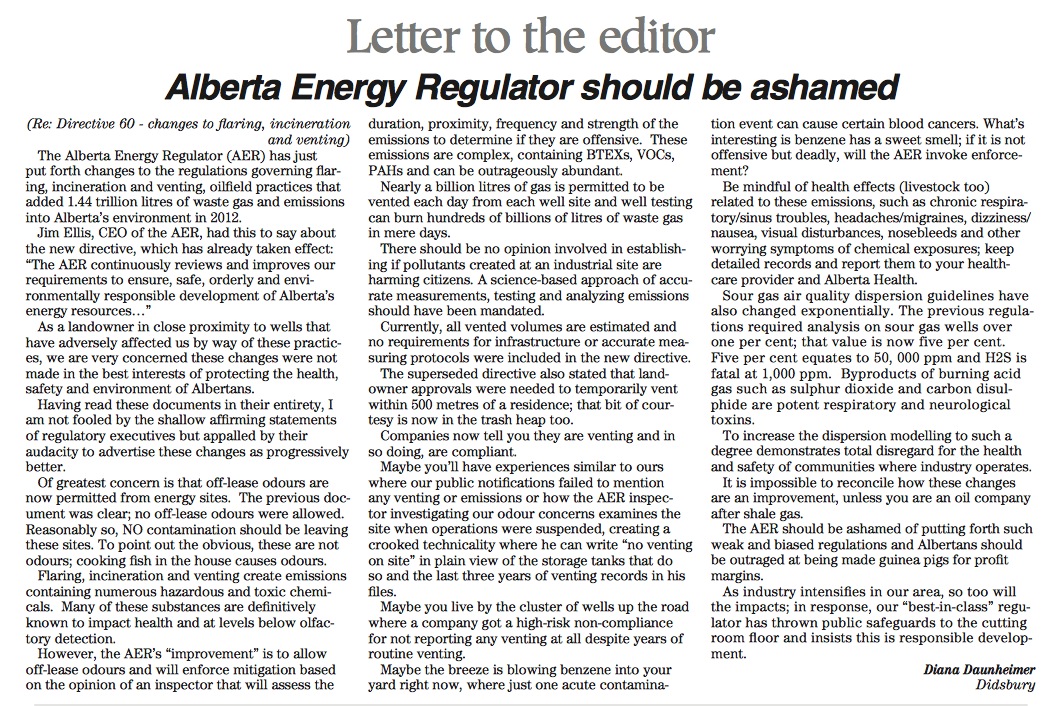 Alberta Energy Regulator should be Ashamed
Alberta Energy Regulator should be Ashamed
By Diana Daunheimer, June 24, 2014 , Mountain View Gazette
... Having read these documents in their entirety, I am not fooled by the shallow affirming statements of regulatory executives but appalled by their audacity to advertise these changes as progressively better.
Of greatest concern is that off-lease odours are now permitted from energy sites. The previous document was clear; no off-lease odours were allowed.
Reasonably so, NO contamination should be leaving these sites. To point out the obvious, these are not odours; cooking fish in the house causes odours. Flaring, incineration and venting create emissions containing numerous hazardous and toxic chemicals. Many of these substances are definitively known to impact health and at levels below olfactory detection.
... Sour gas air quality dispersion guidelines have also changed exponentially.
The previous regulations required analysis on sour gas wells over one per cent; that value is now five per cent. Five per cent equates to 50,000 ppm and H2S is fatal at 1,000 ppm.
Byproducts of burning acid gas such as sulphur dioxide and carbon disulphide are potent respiratory and neurological toxins. To increase the dispersion modelling to such a degree demonstrates total disregard for the health and safety of communities where industry operates.
It is impossible to reconcile how these changes are an improvement, unless you are an oil company after shale gas. ... more.
"Remember To Breathe"
Alberta lays out plan to grow tourism industry
By Amanda Stephenson, Calgary Herald, October 29, 2013
"The new Alberta Tourism Framework, a strategy for turning what is currently a $7.8 billion industry into a $10.3 billion industry, was developed in consultation with Travel Alberta and industry representatives. It aims to build on Travel Alberta’s successful 'Remember to Breathe' marketing strategy, convincing more travellers to seek out the Alberta experience.
One of several priorities of the framework is expanding the province’s supply of tourism experiences, especially in national and provincial parks and on Crown land near water, mountains or other natural attractions.
'Our mature iconic national park destinations are capped in terms of commercial growth, and we face strong competition from new, high quality destinations; there is an urgent need for new destination development in Alberta and outside the mountain national parks,' said the document. ... more.
Public Health Experts Call on Governor to Study Fracking’s Impact on Cancer-Causing Radon Levels Before Making a Decision On Whether to Allow Drilling
State Medical Society Weighs in Supporting Legislation That Protects Public Health by Limiting Radon Exposure
Press Release May 8, 2014
Albany, NY – Leading public health experts and the American Lung Association of the Northeast released a letter to Governor Cuomo urging him to study radon levels in shale gas before making a decision on whether to allow fracking. Relatedly, the State Medical Society issued a resolution supporting legislation that protects the public from excess radon exposure.
Public health experts are concerned that elevated levels of radon, which according to the US Environmental Protection Agency and Centers for Disease Control is the second leading cause of lung cancer, could reach people’s homes through the natural gas system. Because of elevated levels of radon in the Marcellus Shale and because radon in natural gas from the Marcellus shale might not have time to decay before it gets used in homes and offices, it is important that radon levels be quantified, risks to exposure be limited, and any decision on whether to drill for gas in New York include a full study of the potential radon exposure.
The letter references EPA’s concerns about radon in Marcellus gas expressed in official comments to the New York State Department of Environmental Conservation (DEC).
... According to the experts, including Dr. Helen Caldicott, founder of Physicians for Social Responsibility, and David Carpenter, Director, Institute for Health and the Environment University at Albany, the New York State Department of Environmental Conservation’s (DEC) draft environmental impact statement on shale gas drilling contains little analysis of radium risks and only one sentence about radon.[1] “Many states have moved forward with shale gas drilling and distribution before examining important evidence about risks. We need to limit risks to the public, and to do that we need to quantify what exposures may be taking place,” said Dr. Carpenter.
The full text of the letter is below:
The Honorable Andrew M. Cuomo
Governor of New York State
NYS State Capitol Building
Albany NY 12224
May 8, 2014
Dear Governor Cuomo:
We are writing to urge your administration to conduct studies and a human health risk assessment of the occurrence of radon and radium during drilling for natural gas before deciding whether to allow drilling in New York’s portion of the Marcellus shale or the distribution to New Yorkers of Marcellus shale gas containing unhealthy levels of radon. We urge your administration to make public any and all data collected about the presence of these two carcinogenic elements in Marcellus shale drilling so that the citizens of New York will have full access to the information used in your decisionmaking.
Our primary concerns are that natural gas produced from the Marcellus shale may contain levels of radon and its decay products that are significantly higher than gas currently being distributed in New York and that wastewater and other drilling wastes from Marcellus shale drilling may contain high concentrations of radium that pose health risks if disposed of improperly.
High radon levels are problematic both to potential end users and as an occupational hazard. Radon present in natural gas may have insufficient time to decay if transported through gas pipelines to homes and other buildings in the state. Therefore, indoor use of radon-containing natural gas for cooking, heating and other purposes might significantly increase cancer risk to the public, especially in New York City and other jurisdictions where homes tend to be smaller and radon could become concentrated in indoor air.
The radon exposure risk from Marcellus gas may affect not only those living in areas where the gas is distributed, but also those who work in close proximity to natural gas facilities, including personnel who maintain and repair the gas distribution system and gas-fired boilers, building maintenance staff, restaurant cooks and state oil and gas inspectors.
Similarly, radium in natural gas wastes could pose risks to drinking water, soil and aquatic life if it is disposed of improperly. Both radon and radium are classified as known human carcinogens by the International Agency for Cancer Research.[2]
The New York State Department of Environmental Conservation’s (DEC) draft environmental impact statement on shale gas drilling contains little analysis of radium risks and only one sentence about radon.[3] The document’s minimal attention to these issues is inadequate and should be remedied by doing a full exposure characterization and health risk assessment of radon, radium and other radioactive byproducts associated with shale gas drilling. The analysis should include a comprehensive study of the levels of radioactivity released from all stages of shale gas production and use and the potential for exposure during exploration, drilling and hydraulic fracturing, transmission to compressor stations and pipelines, delivery to consumers and disposal of drilling wastes.
According to the EPA and the Centers for Disease Control and Prevention (CDC), radon, a naturally occurring radioactive gas, is the nation’s second-leading cause of lung cancer, after smoking. Radon is a radioactive decay product of radium, which, in turn, is a decay product of uranium and thorium, elements that are often located deep underground. Radon is colorless, tasteless and odorless. It is created only by radioactive decay and can be eliminated only by further radioactive decay. It has a half-life of 3.8 days and does not burn or react chemically. Radon’s radioactive decay products include polonium, a radioactive solid that decays by emitting high-energy alpha particles that damage lung tissue and cause cancer. Radon can accumulate in homes and other buildings by migrating from the ground through cracks and holes in a building’s foundation. However, the CDC recognizes that radon can also collect in homes through the indoor use of natural gas that was previously trapped in underground deposits of uranium- and thorium-bearing rock.[4]
The New York Department of Environmental Conservation and U.S. Geological Survey have previously reported that the Marcellus shale contains both uranium and thorium and the Survey has noted that “the Marcellus is readily identified on geophysical logs by its high gamma-ray signal,” a form of radiation.[5] Moreover, the Survey recently released preliminary sampling data from a limited number of natural gas wells that confirmed that natural gas from the Marcellus shale contains radon. In a report published in 2012, the USGS examined 10 samples of gas collected near the wellheads of three wells producing from Pennsylvania’s Marcellus shale. It found radon levels ranging from 1-to-79 picocuries per liter, with an average of 36 and a median of 32. The Survey’s scientists noted that they knew of no other published measurements of radon in natural gas from the Appalachian Basin, which contains the Marcellus shale. They concluded that the number of samples “is too small to… yield statistically valid results” and that “the key to better understanding radon, its sources, and behavior in hydrocarbon reservoirs lies with the collection and interpretation of additional data.”[6]
The EPA similarly highlighted the lack of analysis of radon and other radiation exposure in its review of the DEC’s draft plan for shale gas drilling in New York. “Who is responsible for addressing the potential health and safety issues and associated monitoring related to external radiation and the inhalation of radon and its decay products?” the EPA asked. “Such potential concerns need to be addressed.”
While radon levels in produced gas will start to decline as soon as the gas leaves the well, the short distance from Marcellus shale wells to New York’s consumers means that there will likely be little time for radon levels to decline before the gas reaches homes and buildings. The result may be exposures that are higher than current levels and an increased risk of lung cancer. We strongly encourage your administration to take a leadership role in studying radon exposure through natural gas.
With respect to radium, evidence suggests that levels in wastewater from Marcellus shale gas drilling are unusually high. Radium contaminates underground water deposits that come into contact with uranium- or thorium-bearing rock.[7] In 2011, the U.S. Geological Survey reported that radium levels in produced water from oil and gas wells in New York and Pennsylvania, including those in the Marcellus shale, “have a distinctly higher median… than reported for other formations in the Appalachian Basin, and range to higher values than reported in other basins.” (Generally, produced water is a term for naturally occurring water that comes to the surface in the oil and gas production process; it is distinct from “flowback,” hydraulic fracturing fluid that returns to the surface after being injected during the drilling process. However, here the U.S. Geological survey defines produced water as “produced from an oil or gas well at any point during its life cycle.”) The agency also found that the range of radium levels from produced water in Pennsylvania’s Marcellus shale was similar to New York’s, although the median level was lower “due, at least in part, to dilution of formation water by formation water injected for hydraulic fracturing.”[8] Because radon is a decay product of radium, high levels of radium suggest high levels of radon.
In 2011, The New York Times reported that drilling companies were dumping millions of gallons of wastewater from Marcellus shale gas wells in Pennsylvania into treatment plants, and that the wastewater from 42 wells studied contained radium levels up to 3,600 times EPA’s safety standard for drinking water. In some cases, the treatment plants were not equipped to treat the wastewater and discharged it into rivers just upstream from drinking water intakes.[9] A peer-reviewed study of the impacts of drilling wastewater treated and discharged into a creek by a wastewater facility in western Pennsylvania recently documented radium levels approximately 200 times greater in sediment samples near the discharge than in sediment samples collected upstream of the plant or in other locations in western Pennsylvania. “The absolute levels that we found are much higher than what you allow in the U.S. for any place to dump radioactive material,” one of the authors told Bloomberg.[10] The New York Department of Environmental Conservation has previously found that produced water from 11 of 13 vertical wells drilled in New York’s Marcellus shale in 2008 and 2009 contained radium levels ranging from 400 times to nearly 3,400 times EPA’s safe level. That data was included in the U.S. Geological Survey’s study of radium.[11]
Despite this evidence, the Department’s assessment of radium risks and how to contend with them appears lacking. Although its report stated that “there is questionable available capacity”[12] for New York’s public sewage treatment plants to accept drilling wastewater, it would allow those facilities to accept it if the plants meet permitting conditions.[13] The agency said that underground injection (perhaps the most common method of disposal of drilling wastewater) might be an alternative,[14] even though the last significant government study of pollution risks from oil and gas underground injection wells took place in 1989 and found significant instances of groundwater contamination.[15] In the years since, news stories and studies have continued to link underground injection of drilling wastewater to contamination as well as earthquakes.[16]
The DEC assessment reported that a radioactive materials license might be required for facilities that concentrate naturally occurring radioactive materials during pre-treatment or treatment of drilling wastewater.[17] In its review of the Department’s analysis, the U.S. EPA noted that it was unclear who would be responsible for ultimate disposal of these concentrated radioactive materials.[18]
To ensure the safety of the residents of New York state, it is essential to conduct a thorough assessment of exactly how radium and other radioactive wastes from Marcellus shale drilling operations would be handled and what health risks these wastes would pose. In addition, New York should determine exactly how and whether such wastes can be disposed of safely.
Radon and radium are known human carcinogens that have been found in significant levels in natural gas and natural gas wastes in the Marcellus shale. New York must carefully assess the risks of exposure to these pollutants before making a decision about how or whether to drill for shale gas or to distribute Marcellus shale gas containing unhealthy levels of radon.
Sincerely,
Helen Caldicott, MD
Founding President, Physicians for Social Responsibility, and President of the Helen Caldicott Foundation
Wilma Subra, PhD
President, Subra Company
David O. Carpenter, MD
Director, Institute for Health and the Environment University at Albany
Michael Seilback, MPA
Vice President, Public Policy & Communications, American Lung Association of the Northeast
David R. Brown, DSc
Environmental Health Consultant
Larysa Dyrszka, MD
Concerned Health Professionals of NY
Kathleen Nolan, MD, MSL
Research Director, Catskill Mountainkeeper
Barbara Warren, RN, MS
Member, Alliance of Nurses for Healthy Environments
Sheila Bushkin, MD
Member, Medical Society of the State of New York
Cochrane Homes Test High For Radon
"Due to the geology of Southern Alberta, we are in a high risk area and the results we are finding have been consistent with that"
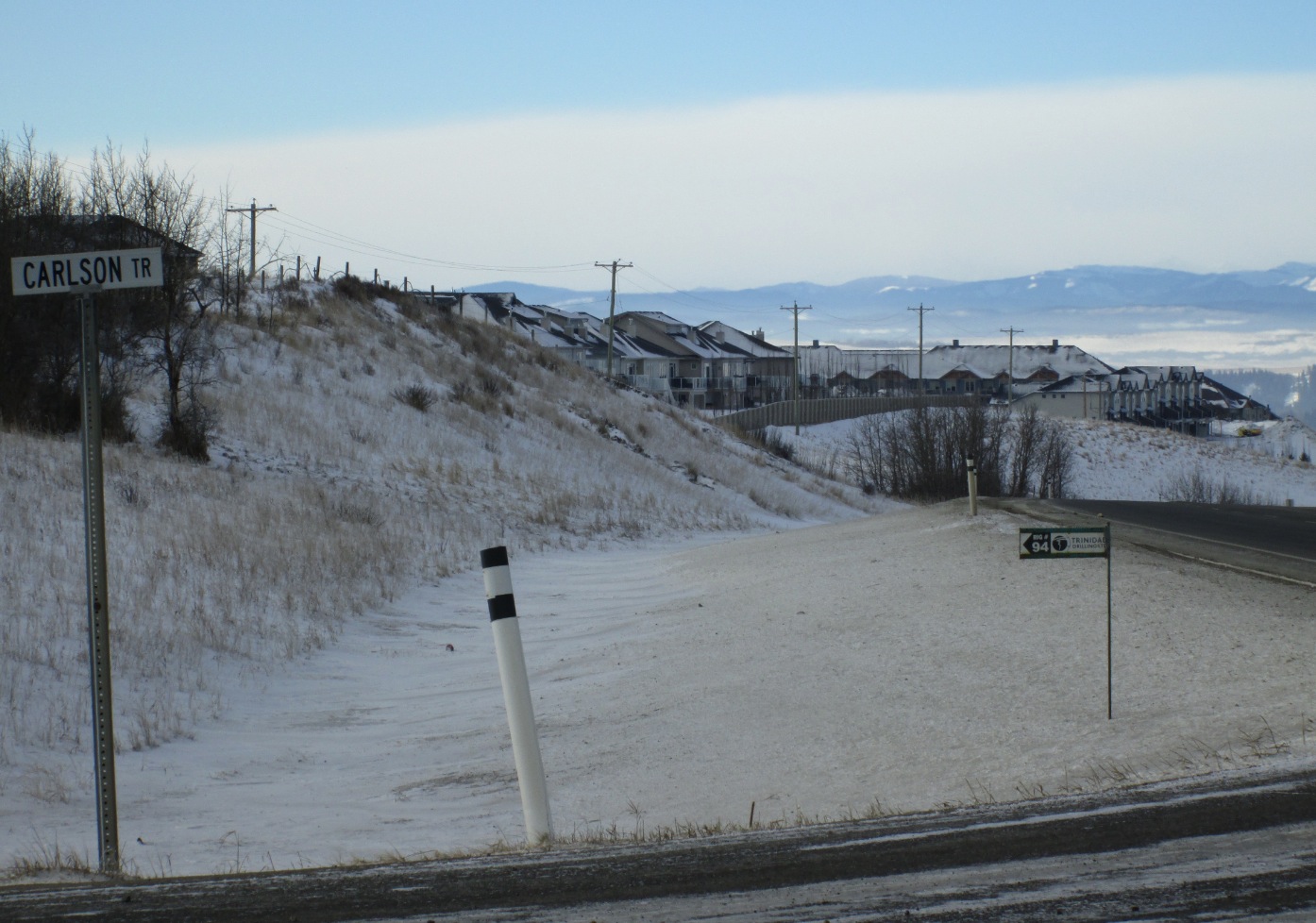
A rig sign directs oilfield traffic to a drill and frack site next to the new residential neighbourhood of Sunset Ridge in Cochrane, Alberta. 2014
By Lindsay Seewalt, Nov 28, 2013, Cochrane Eagle
It’s odourless, tasteless and invisible. It’s also the second leading cause of lung cancer, next to smoking, or the leading cause of lung cancer in non-smokers. And it just might be reaching dangerous levels in your home without you even knowing it.
A radioactive noble gas, Albertans are among the last to know about radon — how long-term exposure to it in enclosed spaces (homes) can be lethal and yet how easy it is to mitigate.
With the push by Health Canada to make November "Radon Action Month", Cochranite and co-owner of Radon West, Renata MacQueen, is on a mission to raise awareness in Cochrane and surrounding municipalities.
"Due to the geology of Southern Alberta, we are in a high risk area and the results we are finding have been consistent with that," explained MacQueen, who estimates that over 40 per cent of the homes her company tests in Calgary, Okotoks and Canmore are testing high for radon.
MacQueen explained that glacial till gets pushed into Southern Alberta by glaciers from such areas as Alaska, Northern B.C. and the Yukon, where there are high levels of radon.
“In Canada, radon is measured in a unit called a Becqueral per meter cubed (Bq/m3)…we have been consistently finding levels above Health Canada’s actionable 200 Bq/m3, while testing communities from Banff all the way down to Lethbridge.”
... MacQueen’s own Cochrane home tested at a staggering 2,491 Bq/m3.
Her sister and business partner, Karin Dumais, also tested high, 322 Bq/m3, in her Okotoks home.
... One Cochrane woman has broken the record for Radon West. Her home tested at 3,441 Bq/m3.
Although she mitigated her home in the fall of 2012 and continues to regularly test her radon levels, her doctor has referred her for a CT scan, as she lived in her home for so many years with no idea she was being exposed to such high levels of radon.
"I was horrified," said the women, who wished to remain anonymous. "I couldn’t even be in the house until it was mitigated."
The women said what concerns her the most is the lack of awareness in Alberta — how so few people she talks to actually know about the side effects of long-term exposure to high levels of radon in their homes. ... more.
Fracking Increases Radon Gas Hazard, US Study Finds
Levels of the carcinogenic gas rising in Pennsylvanian homes near industry sites.
The U.S. findings collaborate and strengthen earlier studies by Australian researchers at Southern Cross University as well as recent shale gas research in Colorado. All suggest that the industrial activity of fracking can speed up the release of the odourless and tasteless gas in geologies already rich in uranium.
By Andrew Nikiforuk, April 13, 2015, The Tyee.ca
Another major U.S. health study has found that the hydraulic fracking of unconventional rock formations can liberate and accelerate the release of radon, a highly carcinogenic gas.
Researchers at Johns Hopkins Bloomberg School of Public Health found that radon levels in U.S. homes in Pennsylvania have been on the rise ever since fracking of the Marcellus shale began in 2004.
The study, published in Environmental Health Perspectives, found that buildings in areas of the most active shale gas mining had significantly higher readings of radon compared to buildings located in areas of low well density and fracking activity.
The study looked at radon levels in more than 700,000 structures between 2004 and 2013. Buildings using well water had 21 per cent higher indoor radon concentrations than homes using municipal water, the study reported. "The release of waterborne radon during showering or washing can contribute to concentrations in buildings," it said.
Radon can be found in well water, natural gas and the atmosphere wherever rock formations or soils contain lots of decaying uranium. Lung cancer caused by radon kills about 3,000 Canadians a year.
The U.S. findings collaborate and strengthen earlier studies by Australian researchers at Southern Cross University as well as recent shale gas research in Colorado. All suggest that the industrial activity of fracking can speed up the release of the odourless and tasteless gas in geologies already rich in uranium.
In 2013, Douglas Tait, Isaac Santos and Damien Maher reported that the radon air levels above the heavily fracked Surat Basin in Queensland, Australia were three times greater than those observed in a non-fracking region. (A separate and earlier study also showed that methane and carbon dioxide levels in the air were three times higher in the mined landscape.)
The Australian researchers suggested that the shallow fracking of coal seams radically changed "the geological structure" of the ground by cracking rock, removing water and lowering pressure in the formation. The fracturing of the ground structure simply created more pathways for radon and other gases to leak up through the soil.
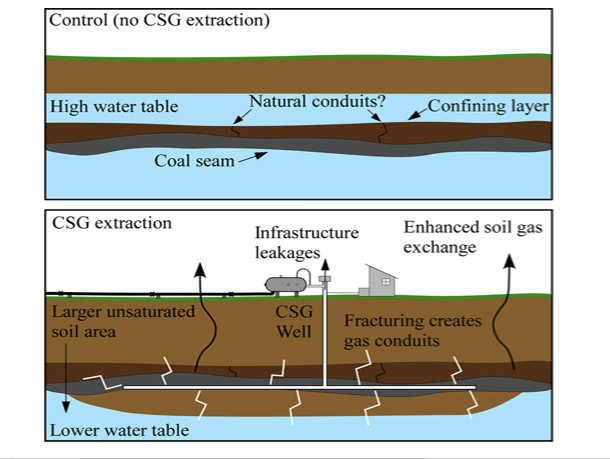 Conceptual model of how gas pathways are altered due to fracking. Source: Australian study, Douglas Tait, Isaac Santos and Damien Maher.
Conceptual model of how gas pathways are altered due to fracking. Source: Australian study, Douglas Tait, Isaac Santos and Damien Maher.
The mechanism for releasing radon into the atmosphere in fracked landscapes may be similar to that caused by earthquakes, added the researchers. Atmospheric levels of radon will typically increase fivefold prior to an earthquake due to stress changes in rock which, in turn, opens new fractures and pathways to the surface.
Hydraulic fracturing pulverizes low quality rock formations to release small amounts of oil and gas over vast geographic areas.
The technology causes small earthquakes by design, but in recent years, as the industry has used more force to crack rock in ever deeper formations, it has triggered significant earthquake activity. Many of these industry-made quakes could be felt on the surface in Alberta, British Columbia, Ohio and Oklahoma.
'Southern Alberta is a hotspot'
"The disruptive process" of fracking, explain the John Hopkins researchers, not only brings gas to the surface but can liberate "heavy metals and organic and radioactive materials such as radium-226, which decays into radon."
In a press release, Joan A. Casey, lead author in the Hopkins study, explained that "the fracking industry may have changed the geology and created new pathways for radon to rise to the surface. Now there are a lot of potential ways that fracking may be distributing and spreading radon."
Radon liberated by the fracking of more than 7,000 horizontal shale wells in Pennsylvania may dissolve into well water, be released into the air near gas wells, or wander through soil into house foundations. It may also enter homes via cooking stoves and furnaces.
A 2012 Health Canada study found that more than seven per cent of the homes measured in Calgary, Peace River, David Thompson and Aspen regional health districts had dangerous levels of radon (200 becquerels per cubic metre). High levels of radon have also been found in northeast B.C. That geographic region has also witnessed intense shale gas activity over the last decade.
Renata MacQueen, one of the owners of Radon West, an Alberta-based company that measures and fixes radon problems, said fracking can "increase the levels of radon by opening pathways in the soil and it then can move into the home or water." But she adds the danger is pre-existing, due to the high uranium content of many soils and rock formations in Canada such as those in southern Alberta.
"Southern Alberta is a hotspot. Even if you don't live near a well site, you should test your home," said MacQueen.
More pathways, more risk
The John Hopkins study discovered that houses located in suburban townships, where the density of gas wells is the greatest, had a 39 per cent higher concentration of radon than those in the cities.
"We found a statistically significant association between proximity to unconventional natural gas wells drilled in the Marcellus shale and first floor radon concentration in the summer, with a positive, but attenuated association for basement levels, which suggests a pathway through outdoor ambient air, but does not rule out the possibility of radon moving from the basement to the first floor."
In addition, nearly 300,000 homes had a first basement test result that exceeded federal safety levels.
"We observed fluctuating radon concentrations throughout the study period; low Marcellus activity counties consistently had lower radon concentrations than both high and no Marcellus activity counties, before and after drilling began," added the study.
Pennsylvania, the home of the U.S. oil boom which began in the 1860s, is one of the most heavily drilled jurisdictions in North America. Industry has punctured the state's geology with nearly a million holes, and then cracked and fracked that geology again during the shale boom.
Given that much of the state's geology is also uranium rich and that well densities are extremely high, it is no surprise that the state has some of the highest indoor radon levels in the U.S.
The connection between radon migration and hydraulic fracking has been documented in other regions, too. A 2013 study by the University of Colorado-Colorado Springs found radon levels at fracking sites so high that they recommended better air monitoring.
"The fracked rock releases radon that was trapped by the tight shale formation which then is able to flow along the lateral sections of the fracked zone and be pumped up the well bore to the surface," concluded the study. "Radon is then released to the atmosphere at the fracking site in levels which may be of some health concern to nearby workers or residents."
An industry textbook on gas migration explains that drilling holes in the ground and then injecting them with water or gases can force gases including radon, carbon dioxide and methane to migrate and find paths to the surface. The more pathways created by the industry, the greater the risk for encountering stray gases: "There is a risk of gas migration into homes, apartment buildings and commercial structures, which have been built in the area of producing oil fields."
In addition, the well-known textbook by Leonid Khilyuk and George Chilingar also notes that seismic activity, such as industrial fracking or earthquakes, can greatly accelerate upward gas migration by creating new faults and fractures, or by increasing the sponginess of the rock formation.
All of the studies called for better baseline data and improved radon monitoring in regions of unconventional drilling and fracking.
"Radon exposure represents a major environmental health risk, and in addition to future studies to understand the impact of drilling on radon levels, there is continuing need for a radon program in Pennsylvania to track and evaluate radon concentrations and to encourage testing and remediation," concluded the John Hopkins study.
Rocky View County, ERCB To Cohost Meeting About Oil And Gas Drilling
Alberta Environment and Sustainable Resource Development (ESRD), Alberta Energy and Alberta Health Services (AHS) have also been requested to participate in the open house.
 By Kimberley Massey, Oct 22, 2012, Rocky View Weekly
By Kimberley Massey, Oct 22, 2012, Rocky View Weekly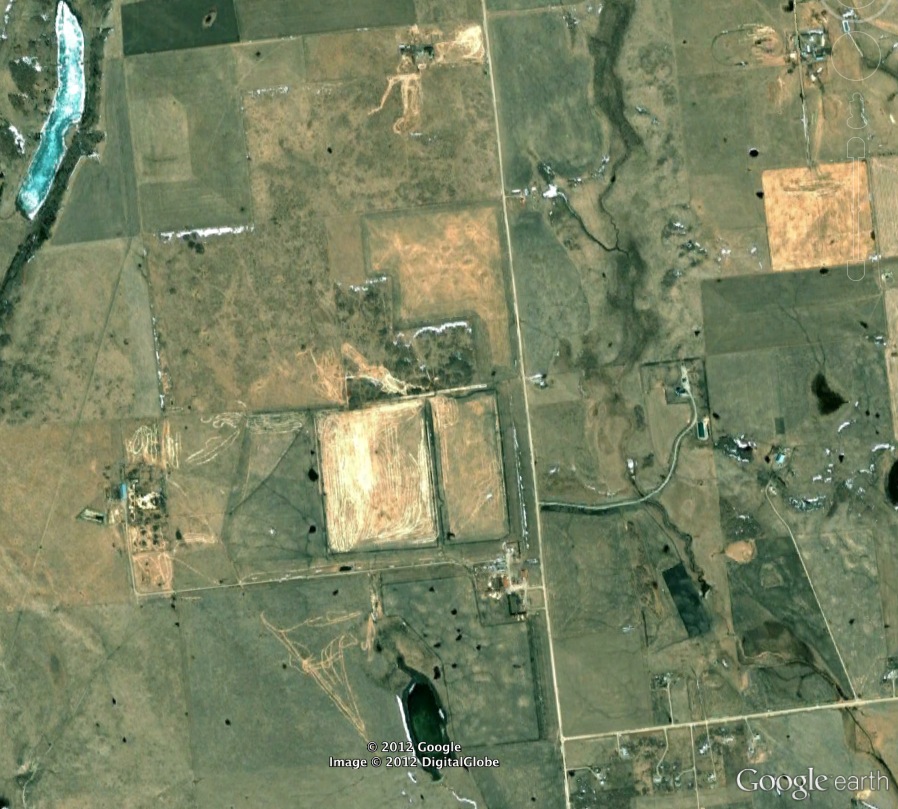 An Agricultural and residential area near Big Hill Springs Provincial Park and Oxyoke Nature Preserve - Rocky View County, Alberta“Time is of the essence here and the sooner we get correct information out to people the better,” she said. “It’s going to have an effect on how development happens out here and how we plan development in Rocky View.”
An Agricultural and residential area near Big Hill Springs Provincial Park and Oxyoke Nature Preserve - Rocky View County, Alberta“Time is of the essence here and the sooner we get correct information out to people the better,” she said. “It’s going to have an effect on how development happens out here and how we plan development in Rocky View.”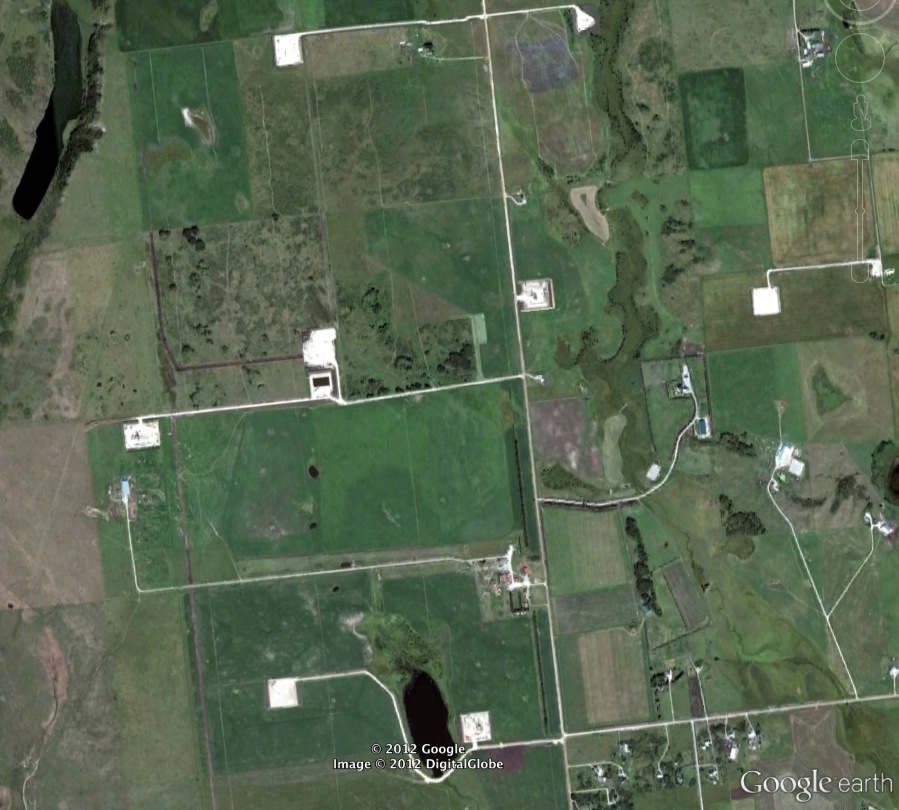 In just 2 years, from agricultural and residential - to toxic industrial? This is the same Lochend area in 2011. Many more wells have been drilled and fracked here since then, with more to come.on Sept. 19 and drilling applications will be submitted to the ERCB.
In just 2 years, from agricultural and residential - to toxic industrial? This is the same Lochend area in 2011. Many more wells have been drilled and fracked here since then, with more to come.on Sept. 19 and drilling applications will be submitted to the ERCB.Industry Representatives To Host Oil And Gas Workshop In Cochrane ... No Word On Alberta Health
Representatives from the ERCB, Alberta Environment and Sustainable Resources and Rocky View County will be available ...
Dec. 7, 2012 - As one resident who attended the Open House reported ...
"It was announced at the Open House to a room full of visibly impacted residents;
'Alberta Health couldn't make it.'"
Alberta Health Services (AHS) Session To Discuss End-Of-Life Planning
By The Cochrane Eagle, February 27, 2013
Planning for what one wants to happen when the end of their life nears is normally not at the top of the priority list, but important nonetheless.
Alberta Health Services (AHS) is holding a session at the Nan Boothby Memorial Library today (Feb. 27) to address this issue. ... more.
What Do US Medical Professionals Recommend?
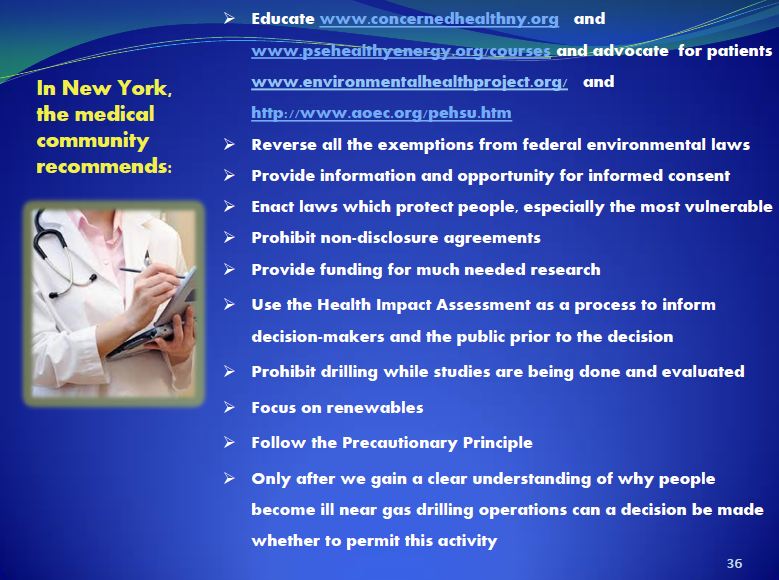 From a presentation by Larysa Dyrszka MD, September 2013 - Click on slide for more.
From a presentation by Larysa Dyrszka MD, September 2013 - Click on slide for more.
Alberta Residents [Cochrane Area]: Fracking Fumes Damaging To Health - CCTV America, October 11, 2013
CCTV Insight presents What Lies Beneath (21 clips), a week long series where we investigate the Natural Gas revolution in the United States spearheaded by a highly controversial technology known as 'Hydraulic Fracturing.'
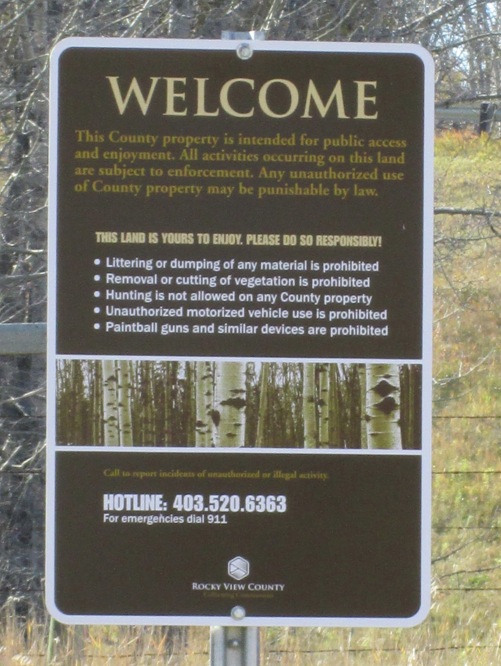
Rocky View County lays down the law and a resident responds. - "Nice signs, are they afraid those things won't blend well with the industrialized landscape, light pollution, noise pollution, air pollution, water contamination, waste spreading, excessive truck traffic, ruined roads, sick residents, dead livestock and decimated property values? Good thinking."
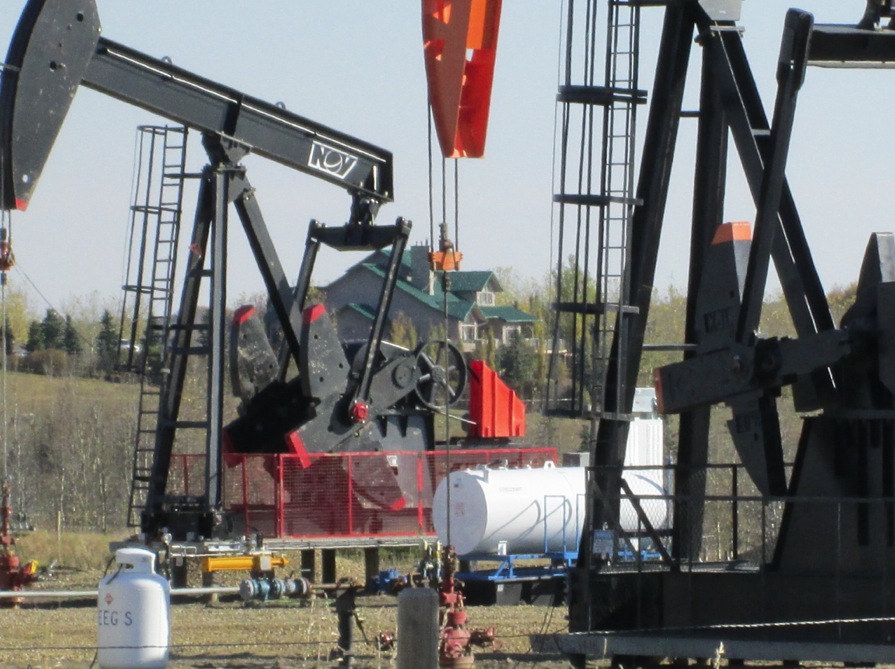 Lochend area. Rocky View County, Alberta. 2013
Lochend area. Rocky View County, Alberta. 2013
"The Hawkwoods have contacted the Alberta Energy Board and have written to politicians, but nothing has happened.
They said most of their neighbours are trying to sell their properties.
'They’re frightened and they want to leave, or they’ve been affected,' Nielle said.
'There’s a neighbour to the south of us – he has prostate cancer, his wife lost her hair, their two teenage daughters lost their hair; they’ve abandoned the house and told the real estate agent to get what you can for it.'"
—Rocky View County Rancher Nielle Hawkwood - Lethbridge Herald
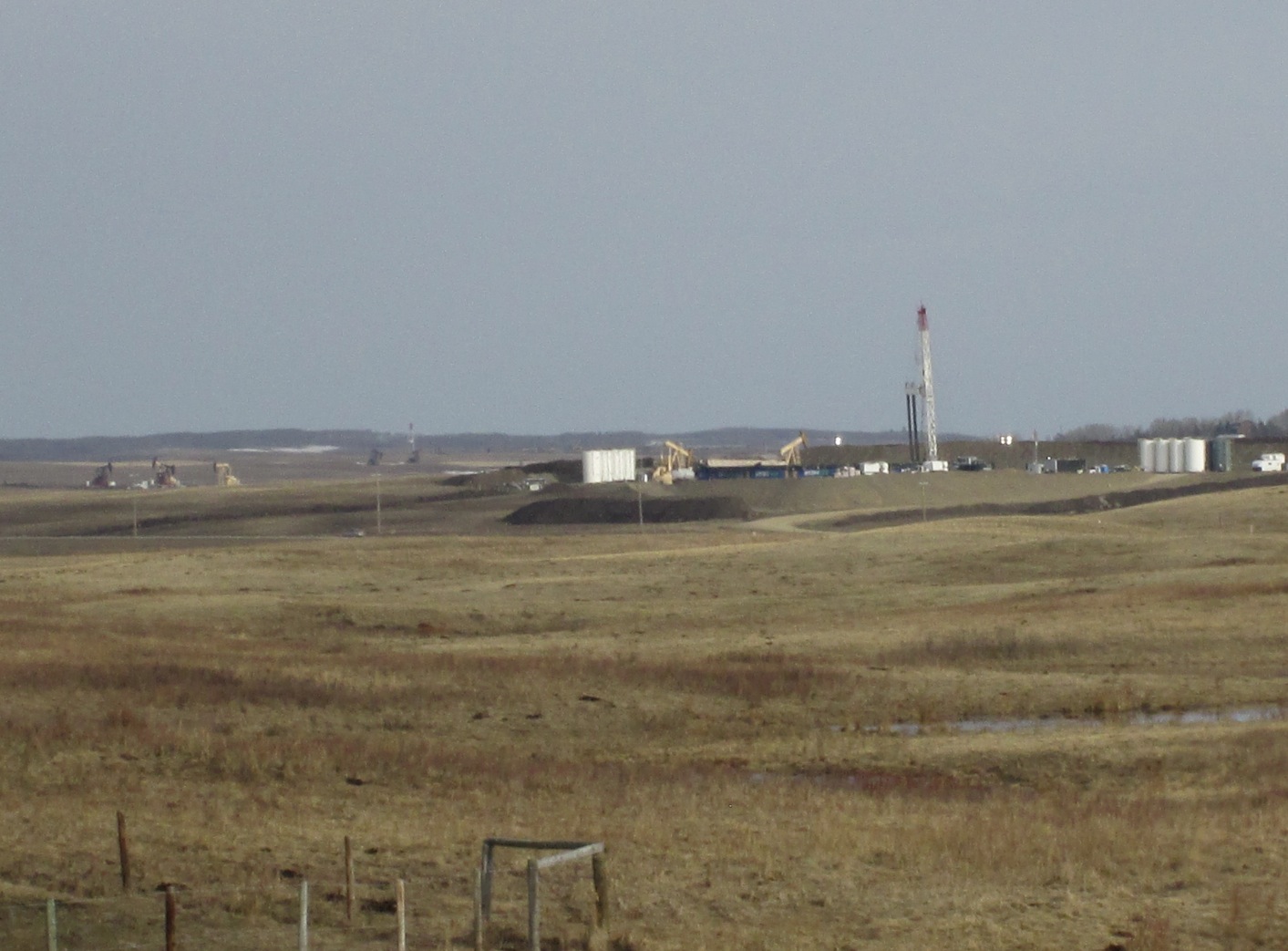 Companies carpet bomb the Lochend east of Big Hill Springs Provincial Park. Rocky View County, Alberta 2014
Companies carpet bomb the Lochend east of Big Hill Springs Provincial Park. Rocky View County, Alberta 2014
Partial transcript from: Health scare over backyard fracking in Canada; Locals sue fracking companies in Alberta
By David Kattenburg, February 5, 2014 for Deutsche Welle - World in Progress
... "More are speaking out, and not just about their personal health.
Where are we Howard, what is this? Howard Hawkwood is another member of Cochrane Area Under Siege.
'Right now we're looking at a cow that has just passed away, during the evening, and I don't know why she died.'
Rocky View County, Alberta Photo: David Kattenburg - Green Planet Monitor
18 of his cows have now died, with over a hundred fracked wells surrounding his property, there's no doubt in Hawkwood's mind what's killing his cattle.
'It is the oil and gas industry, they are responsible for all this stuff, and I'm just tired with the blatant attitude that the oil executives, the presidents, and the shareholders of these companies have towards the common people of Canada and Alberta, actually I'm appalled.'" ... more.
'I get frustrated with people who move to the country and say I like rural — no you don’t,' she said, explaining that rural is the appropriate location for a gravel pit. She added it’s where you find smelly animals, dusty crops and oil wells.
~Rocky View County Councillor Lois Habberfield - Rocky View Weekly
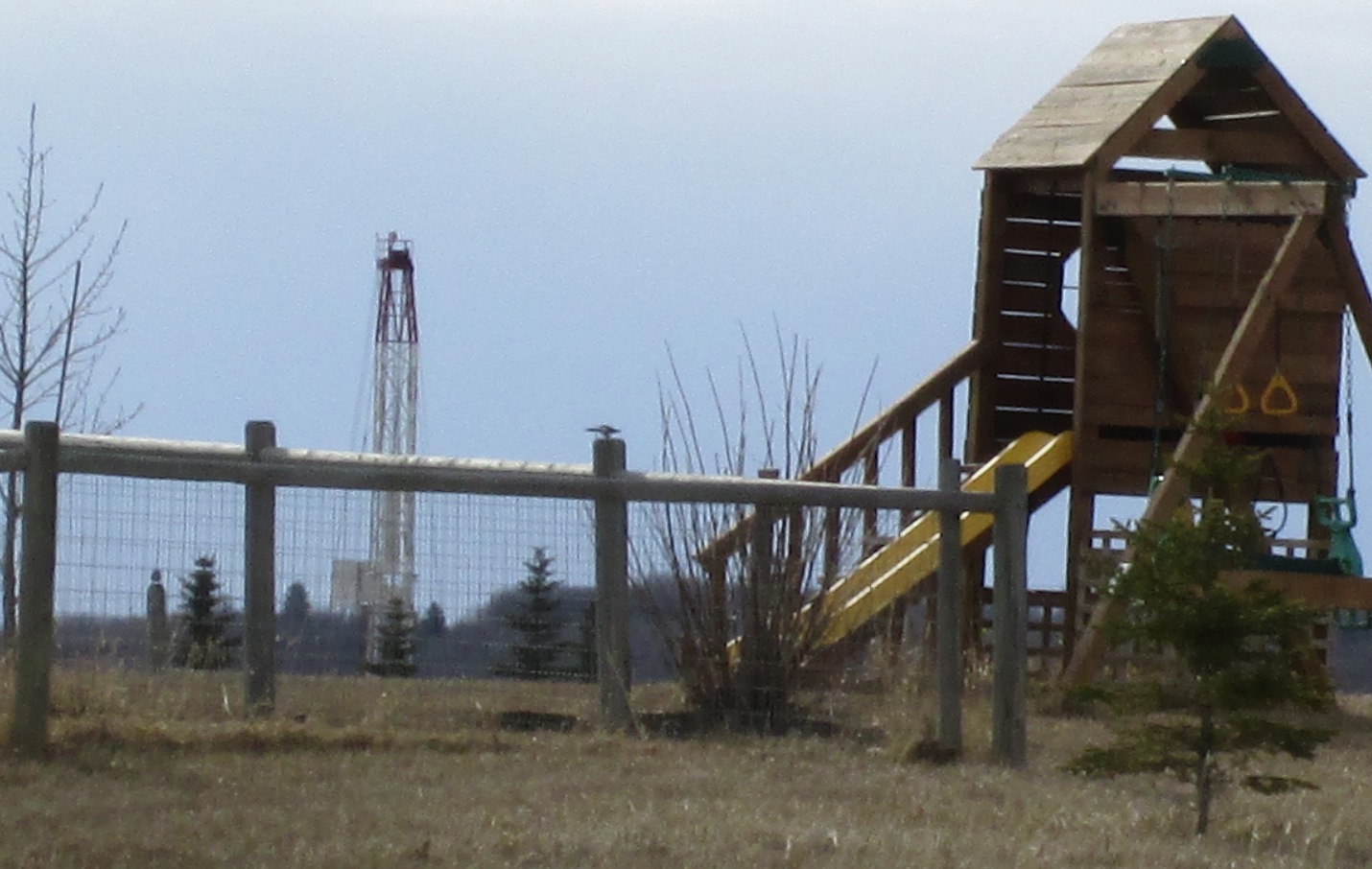 Bearspaw area. Rocky View County, Alberta. 2014
Bearspaw area. Rocky View County, Alberta. 2014
